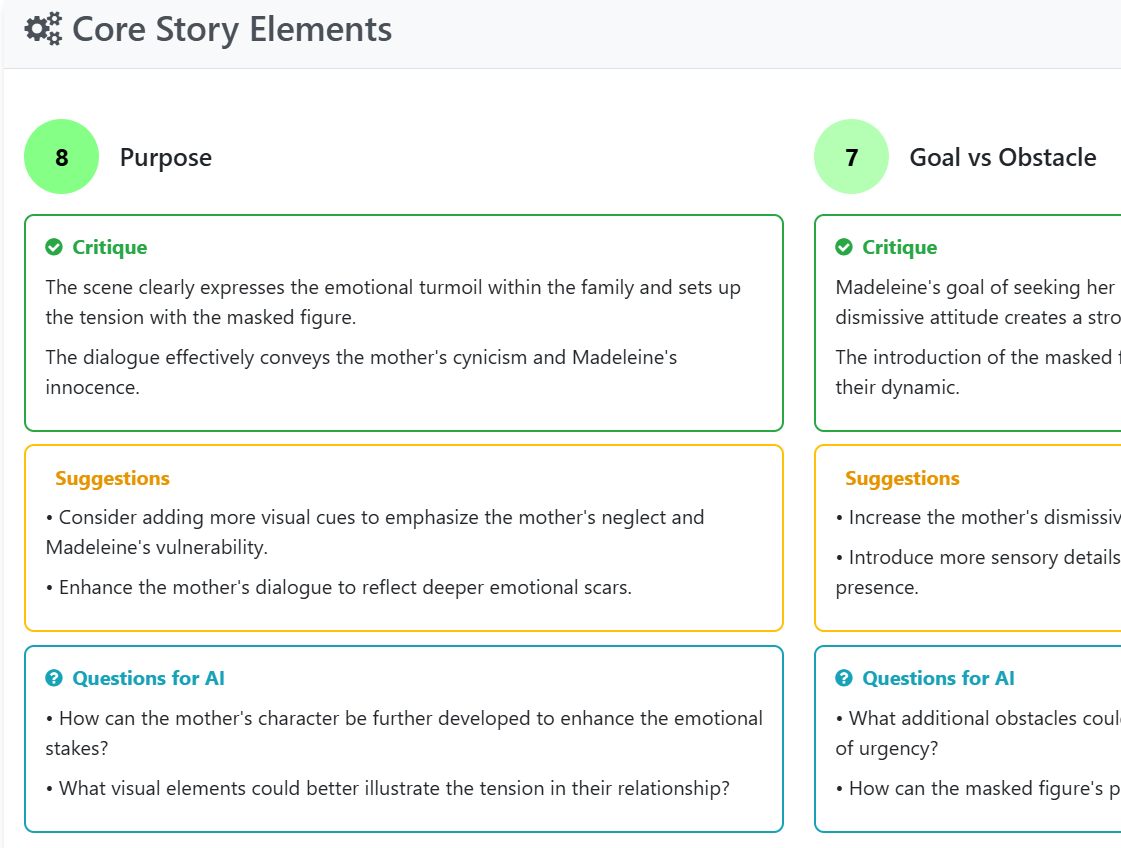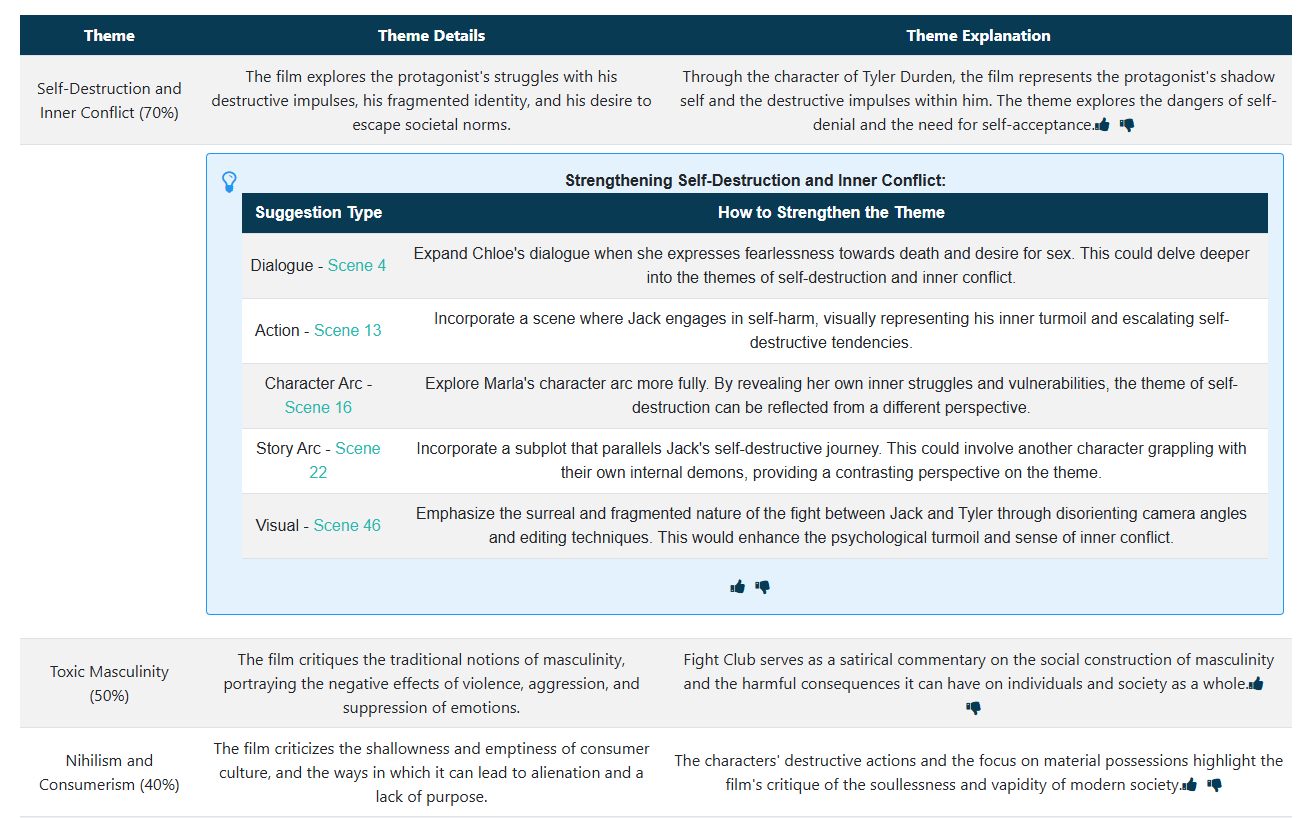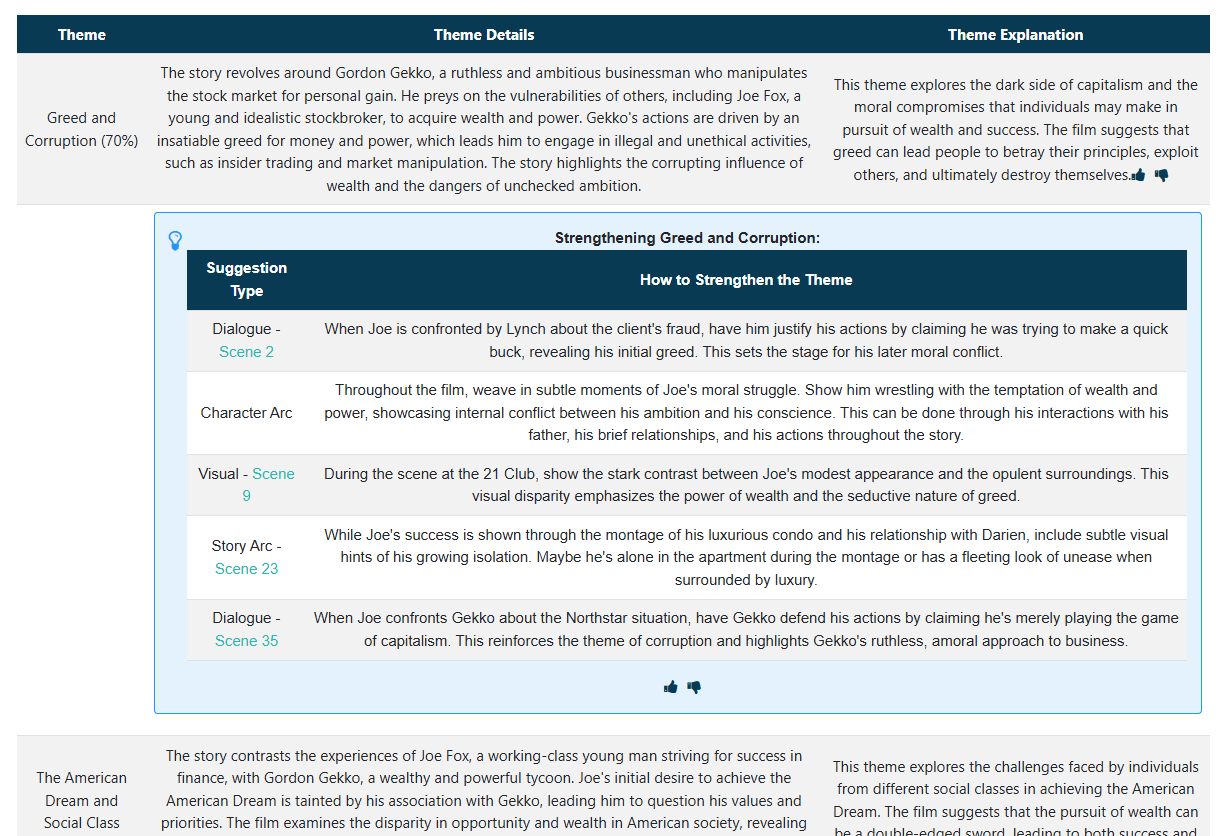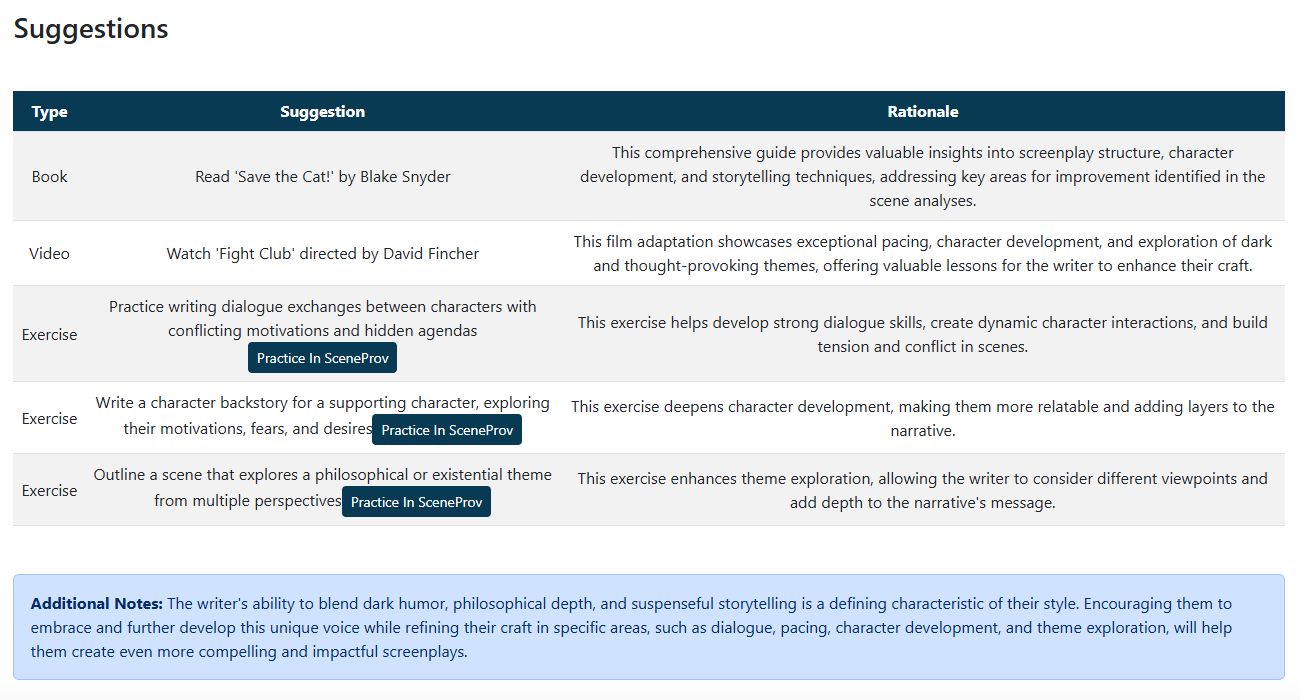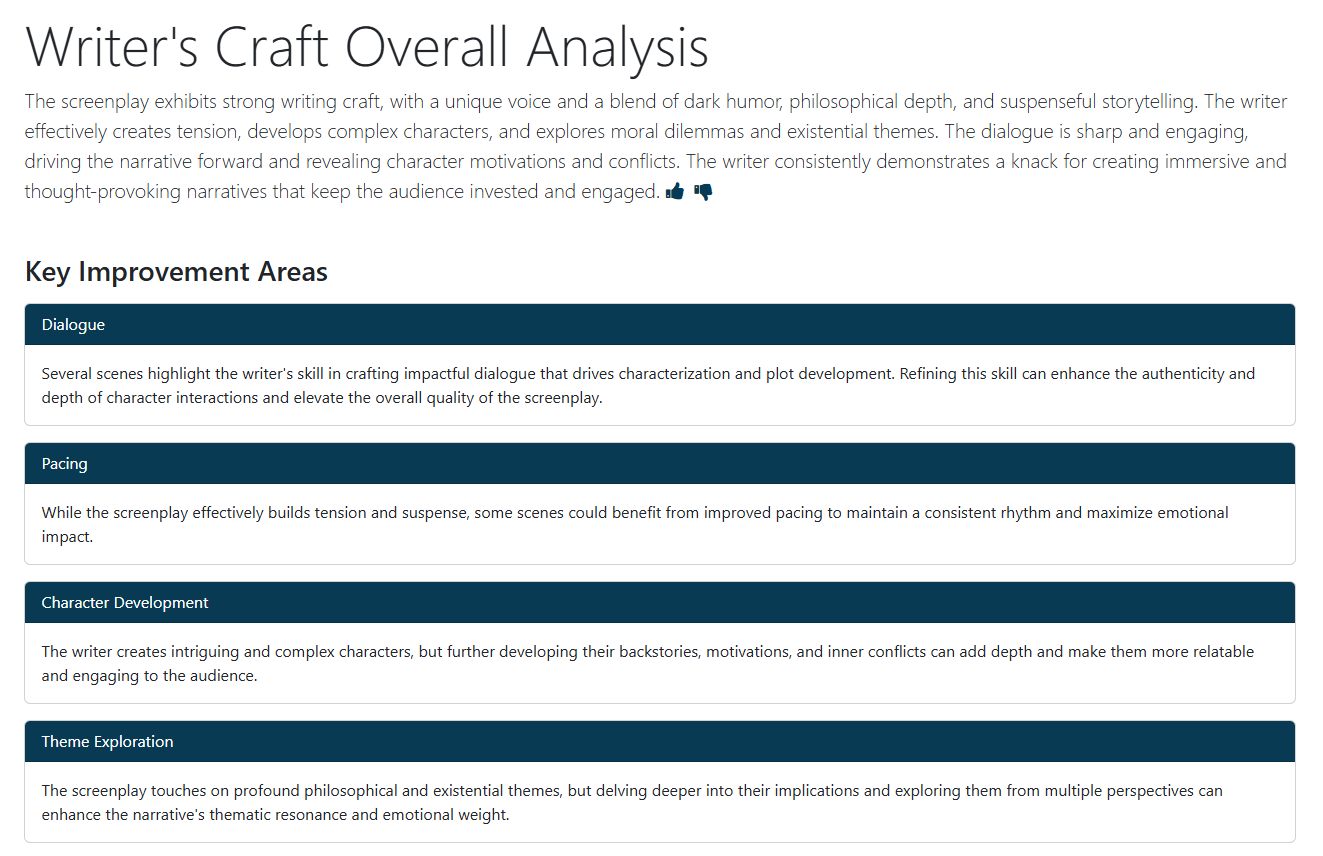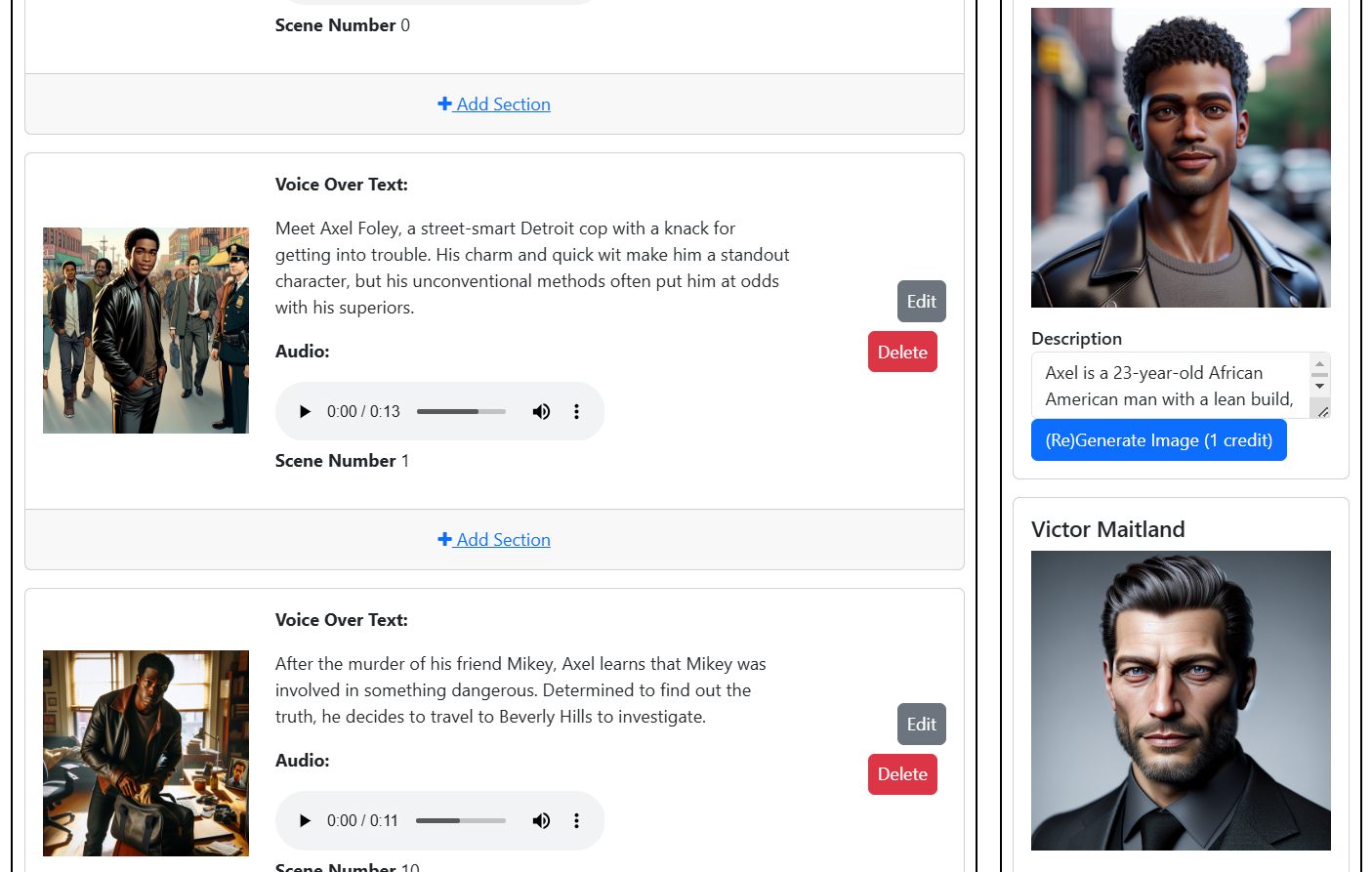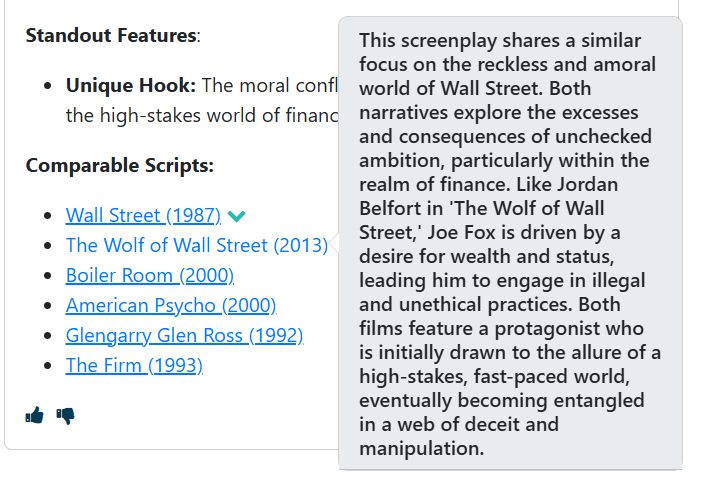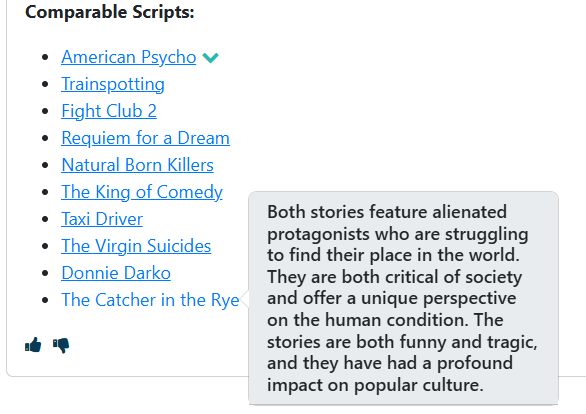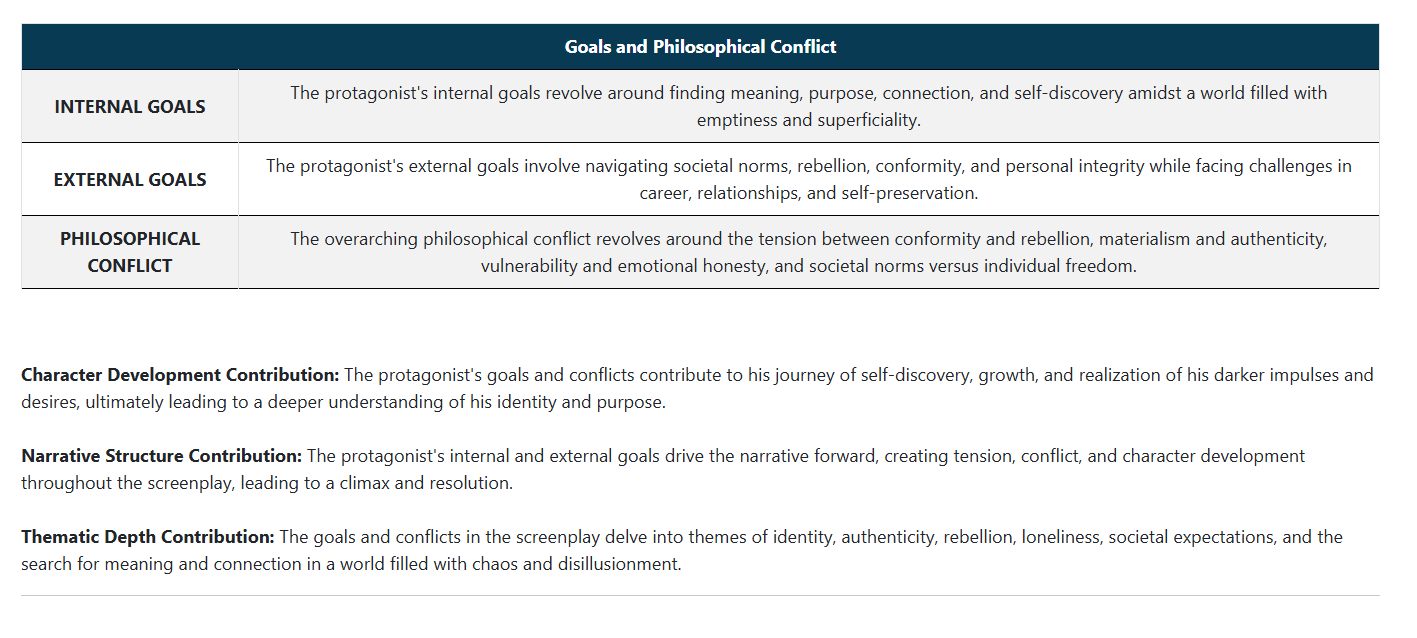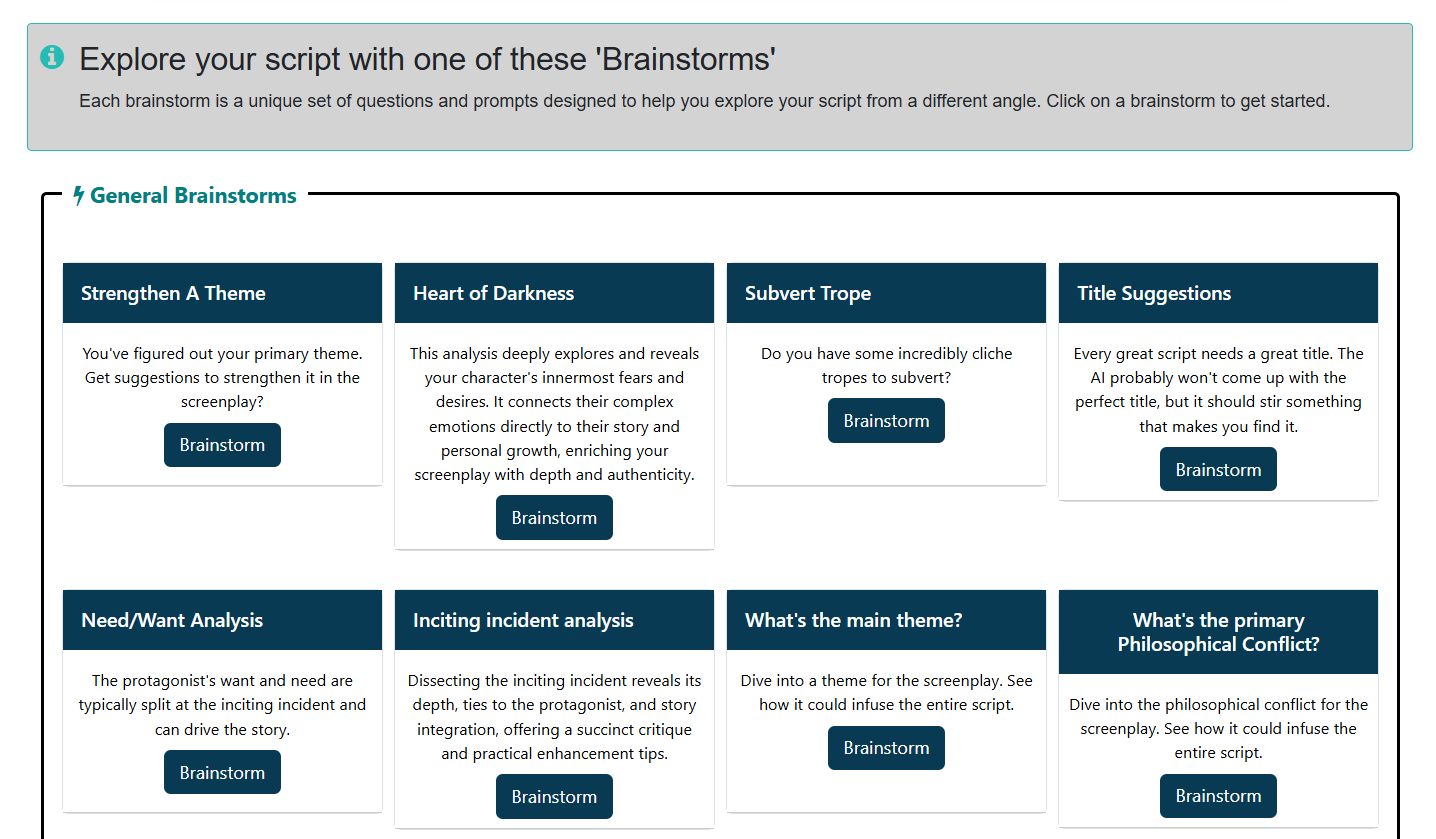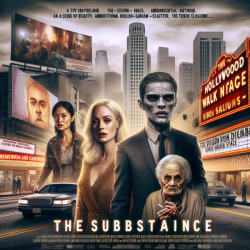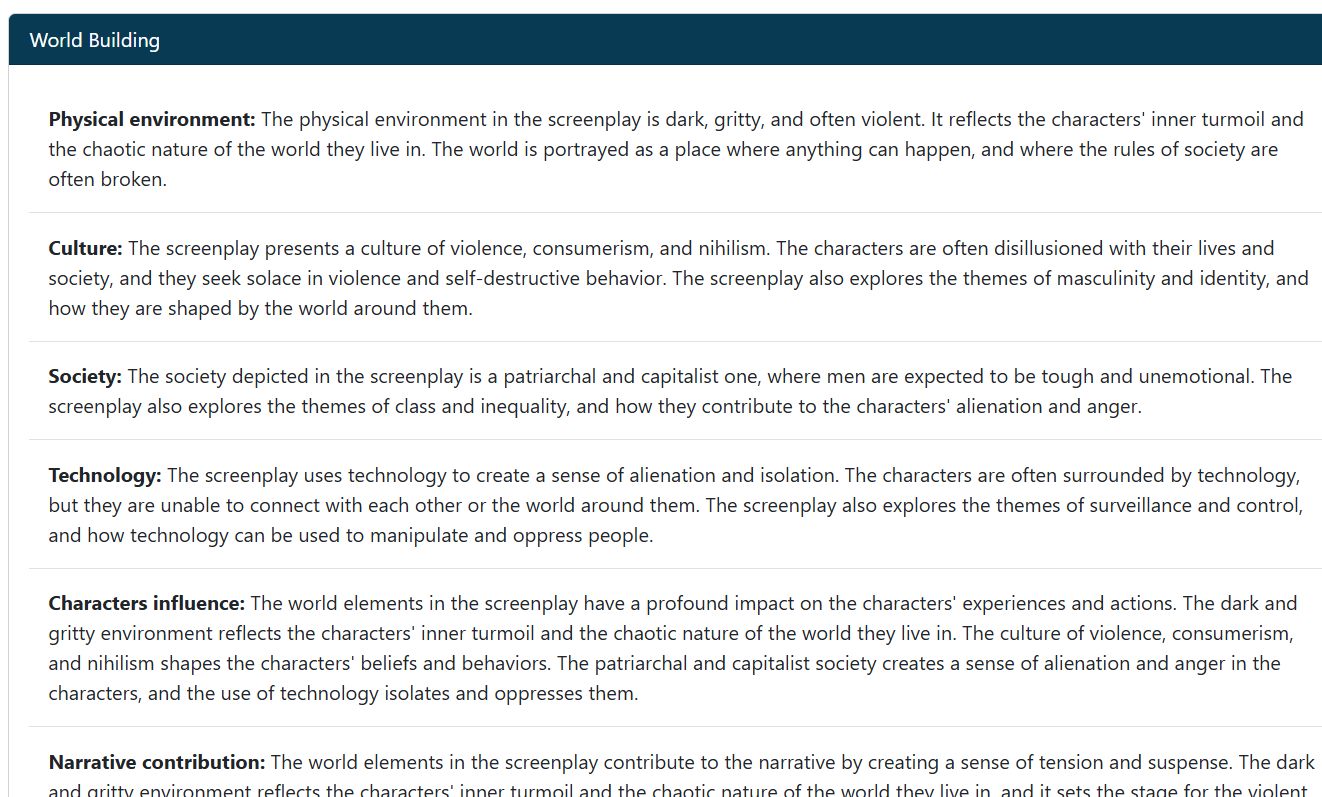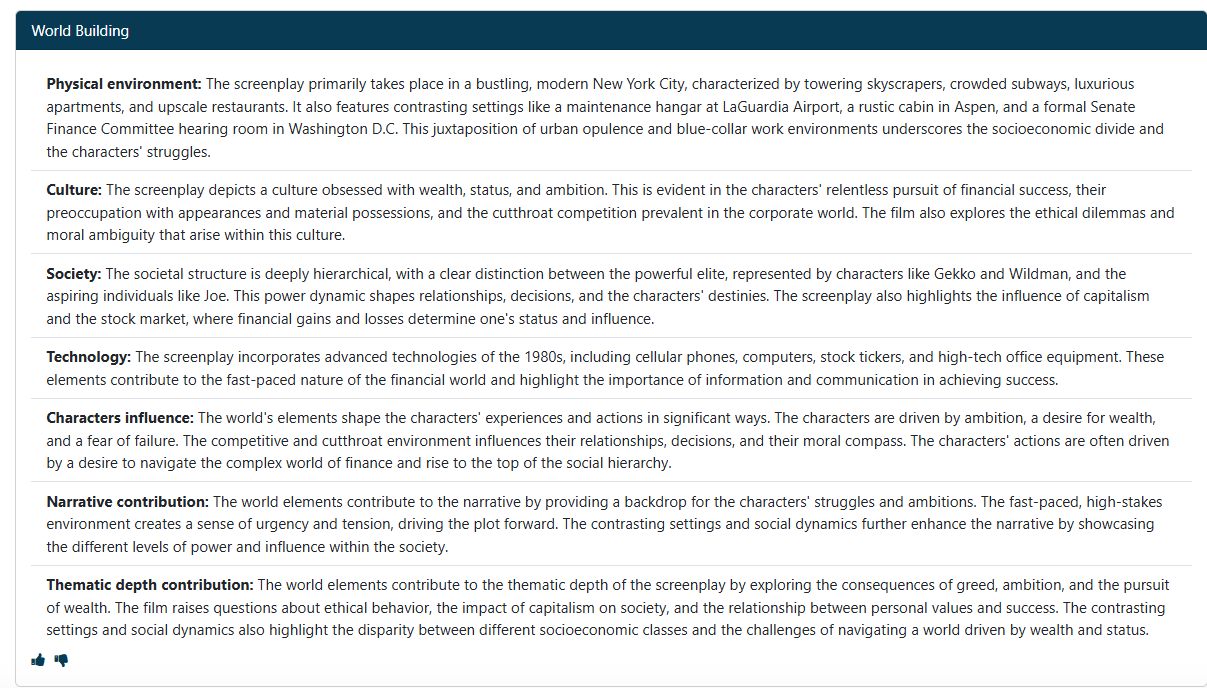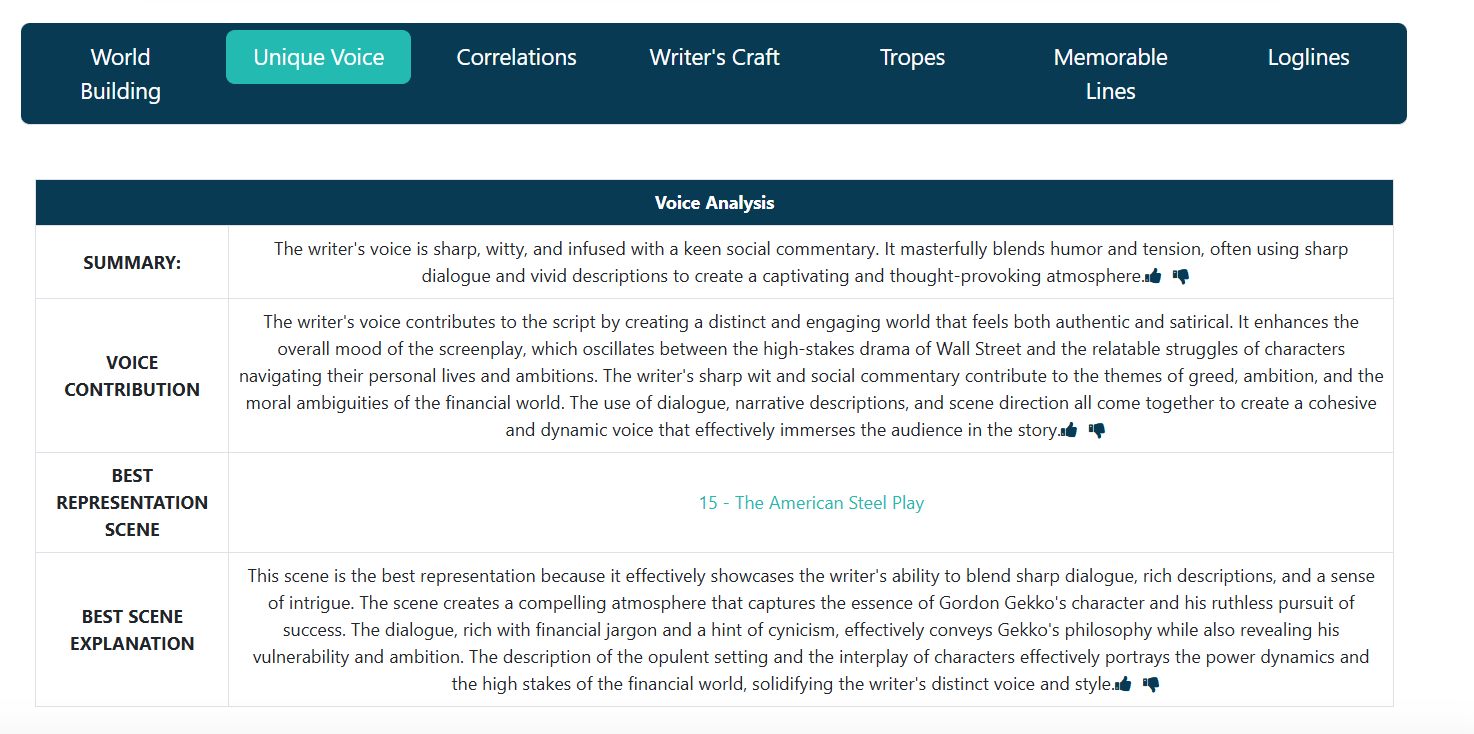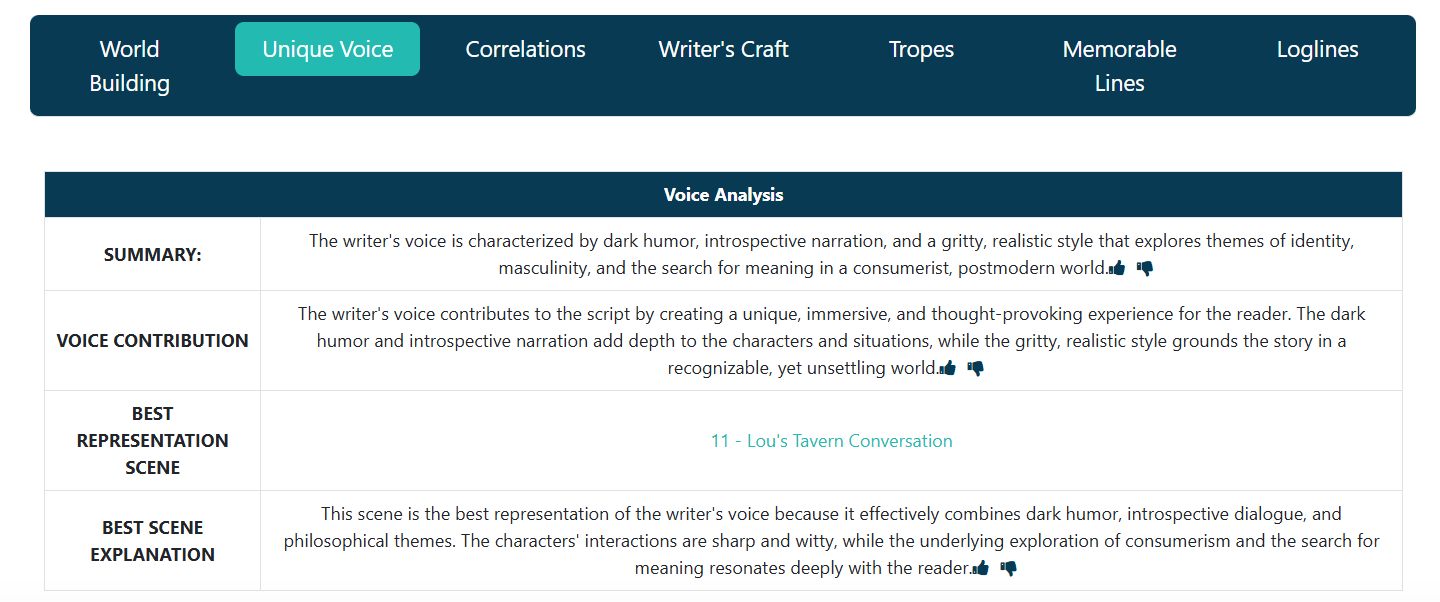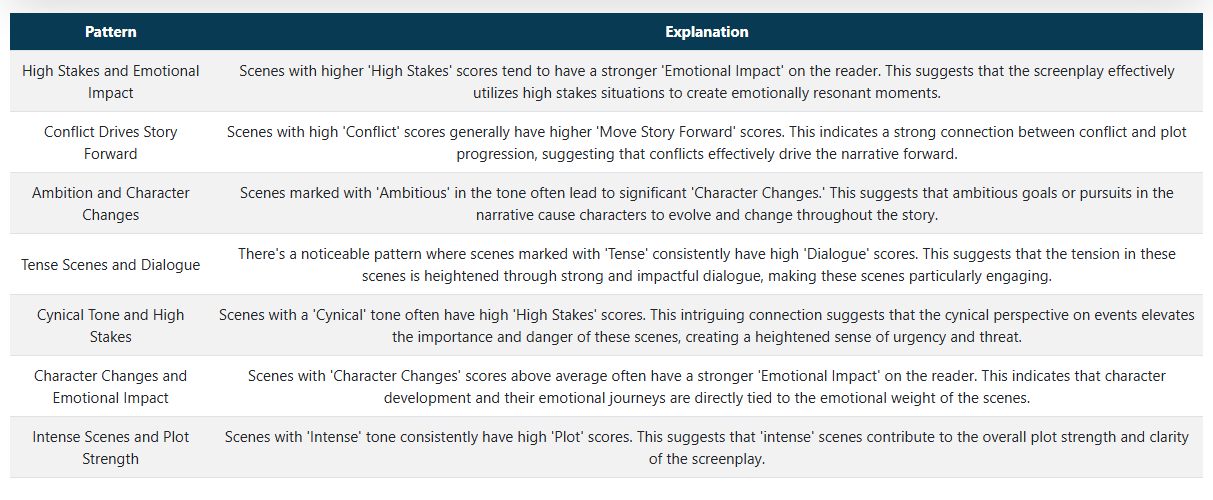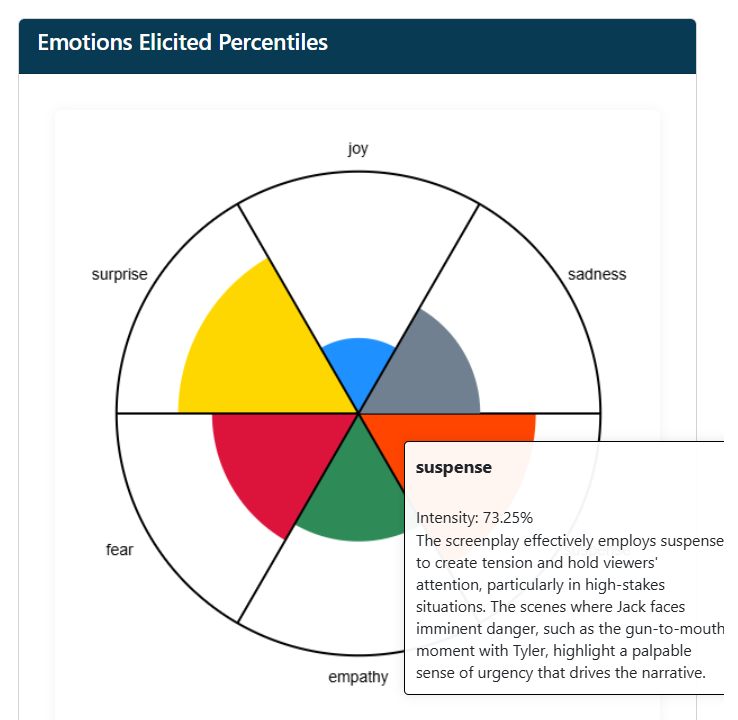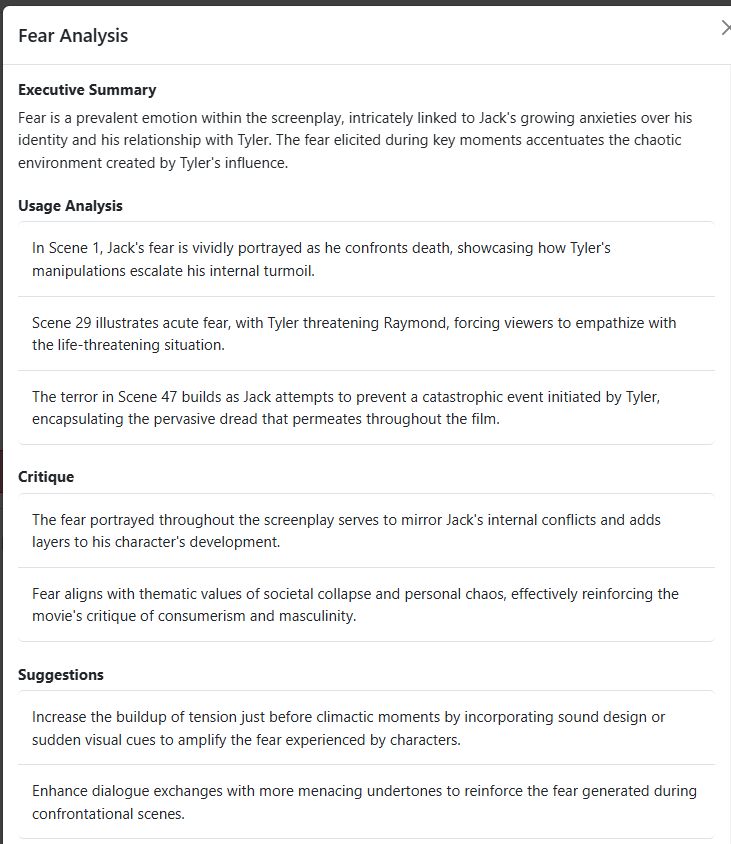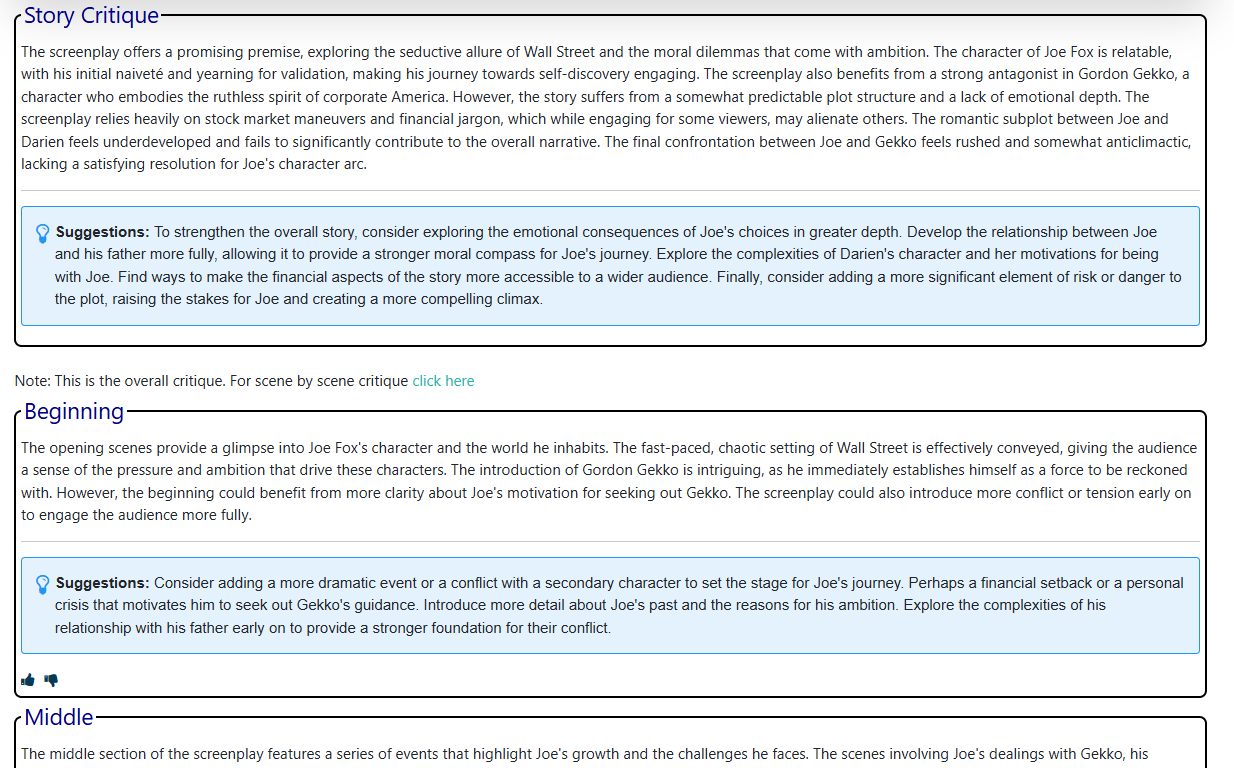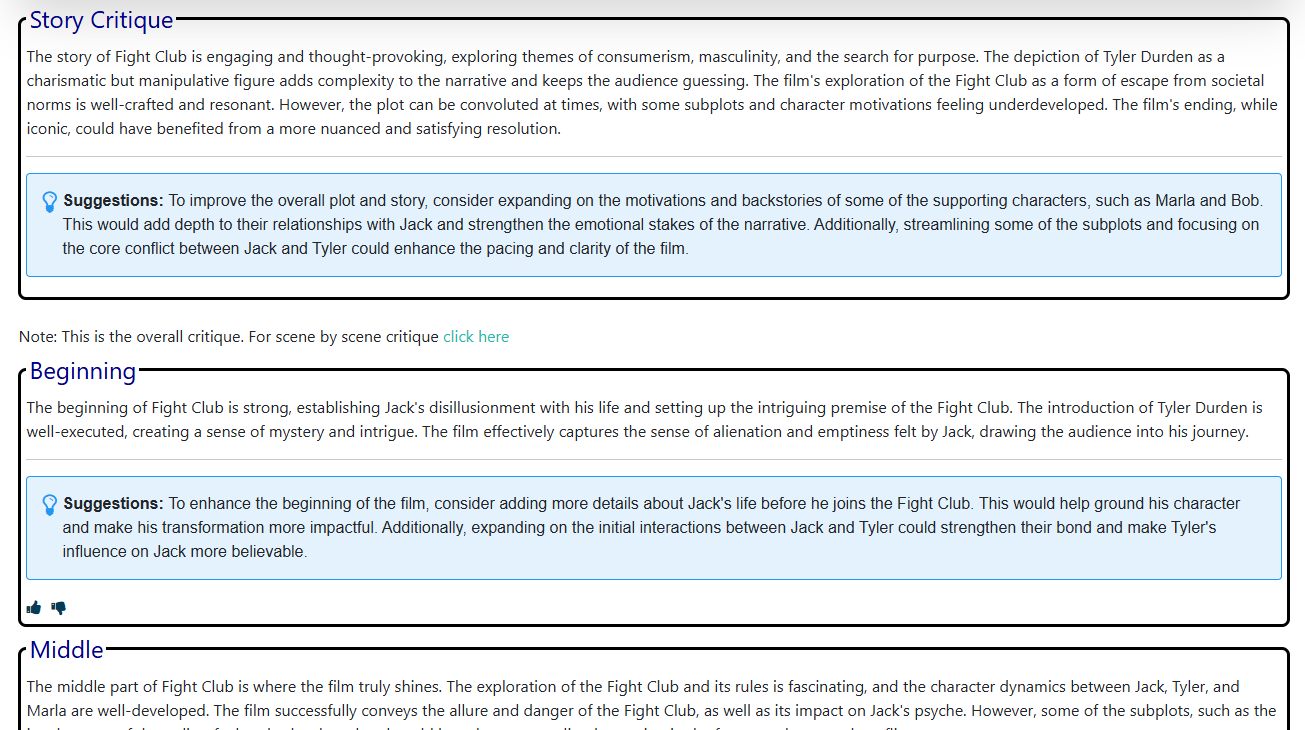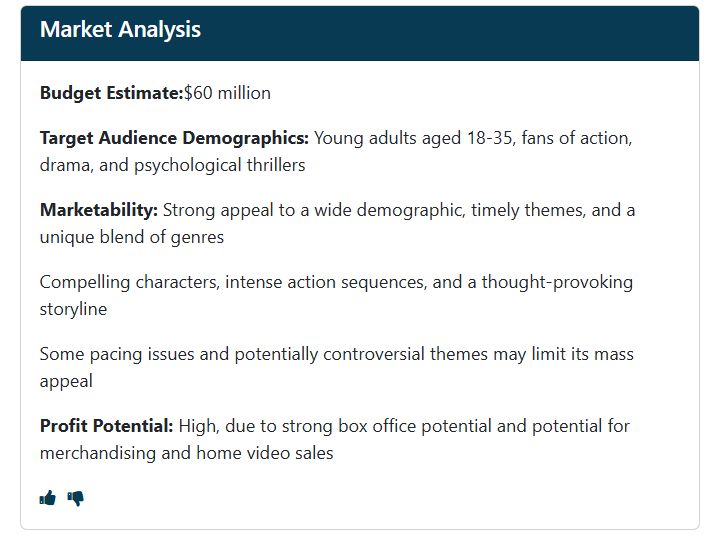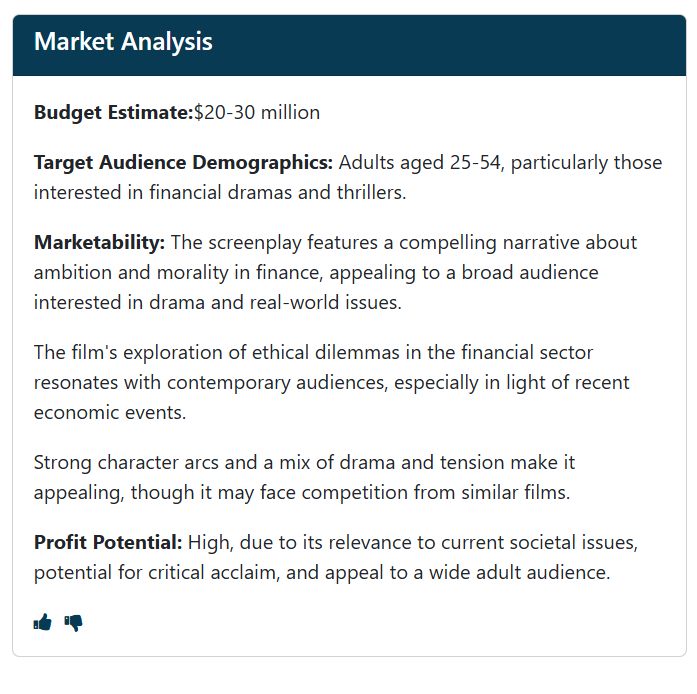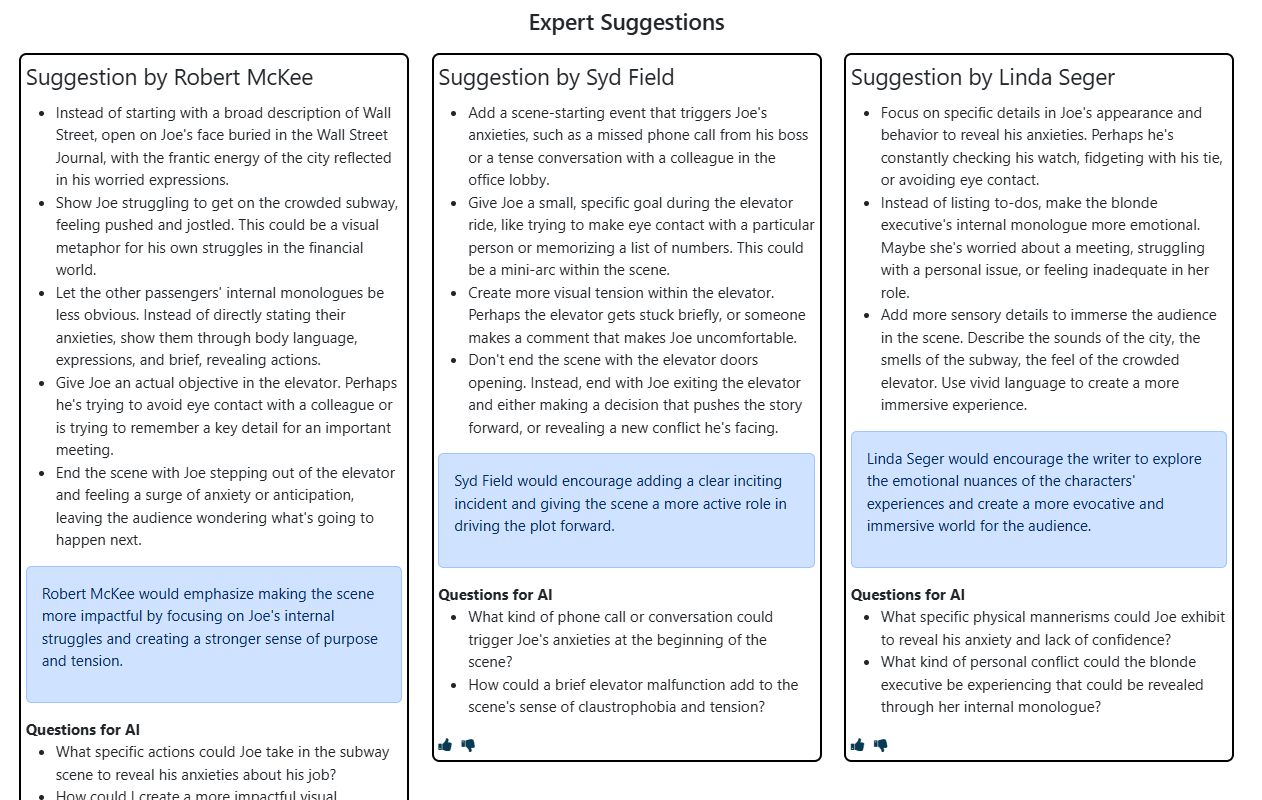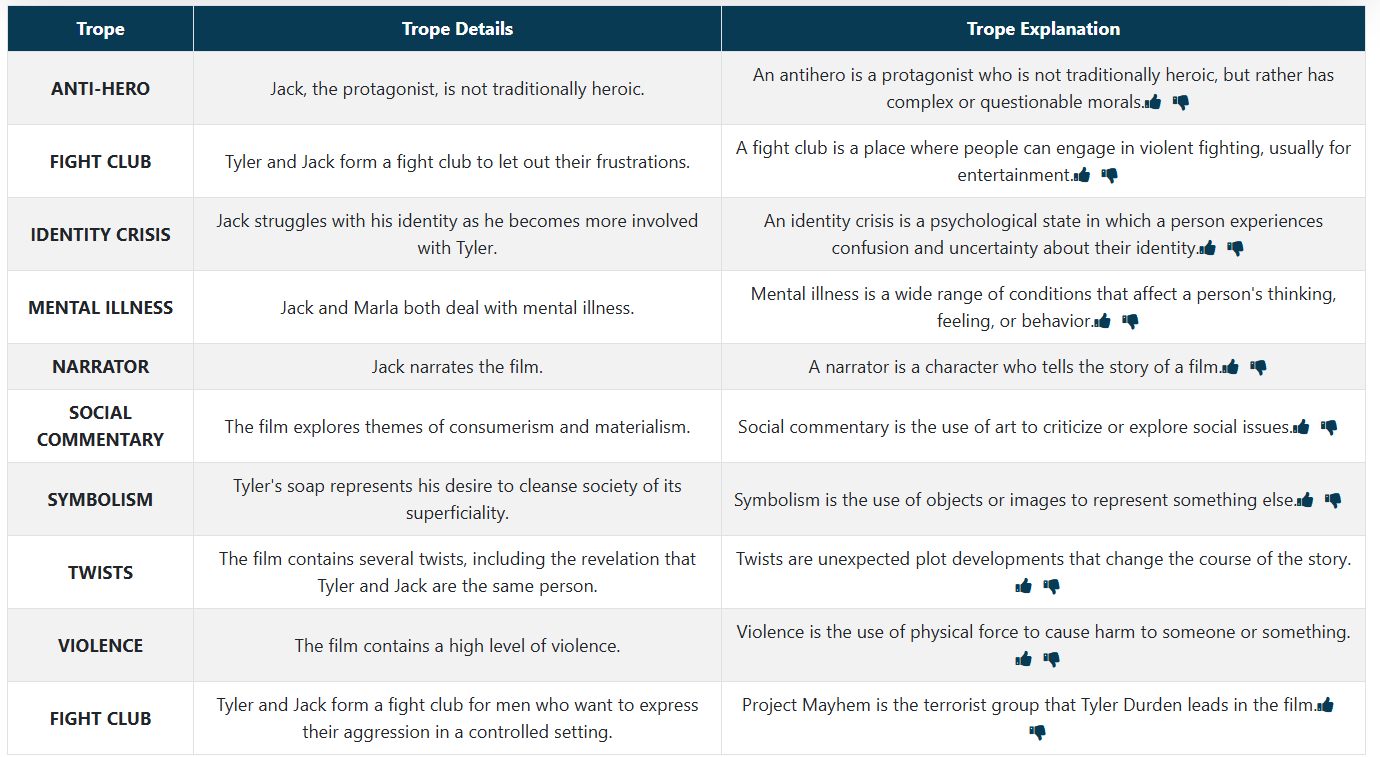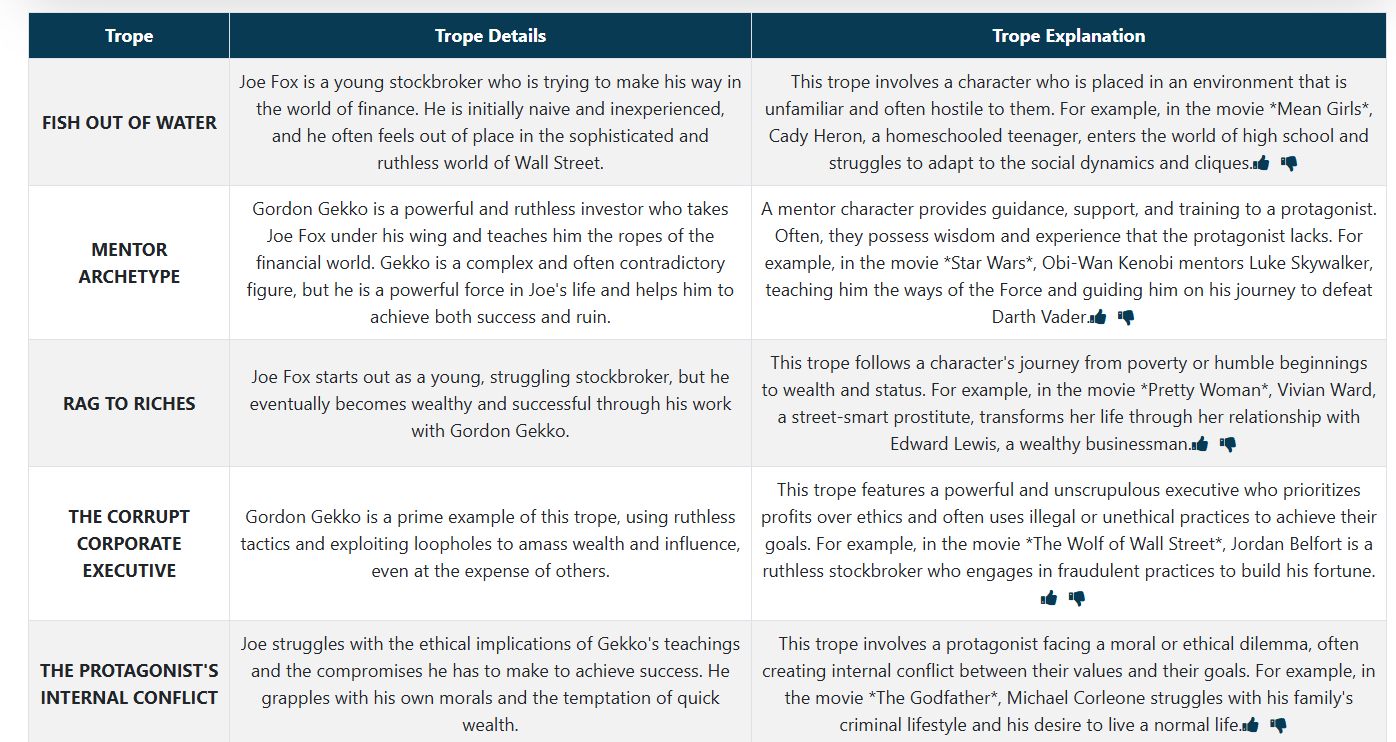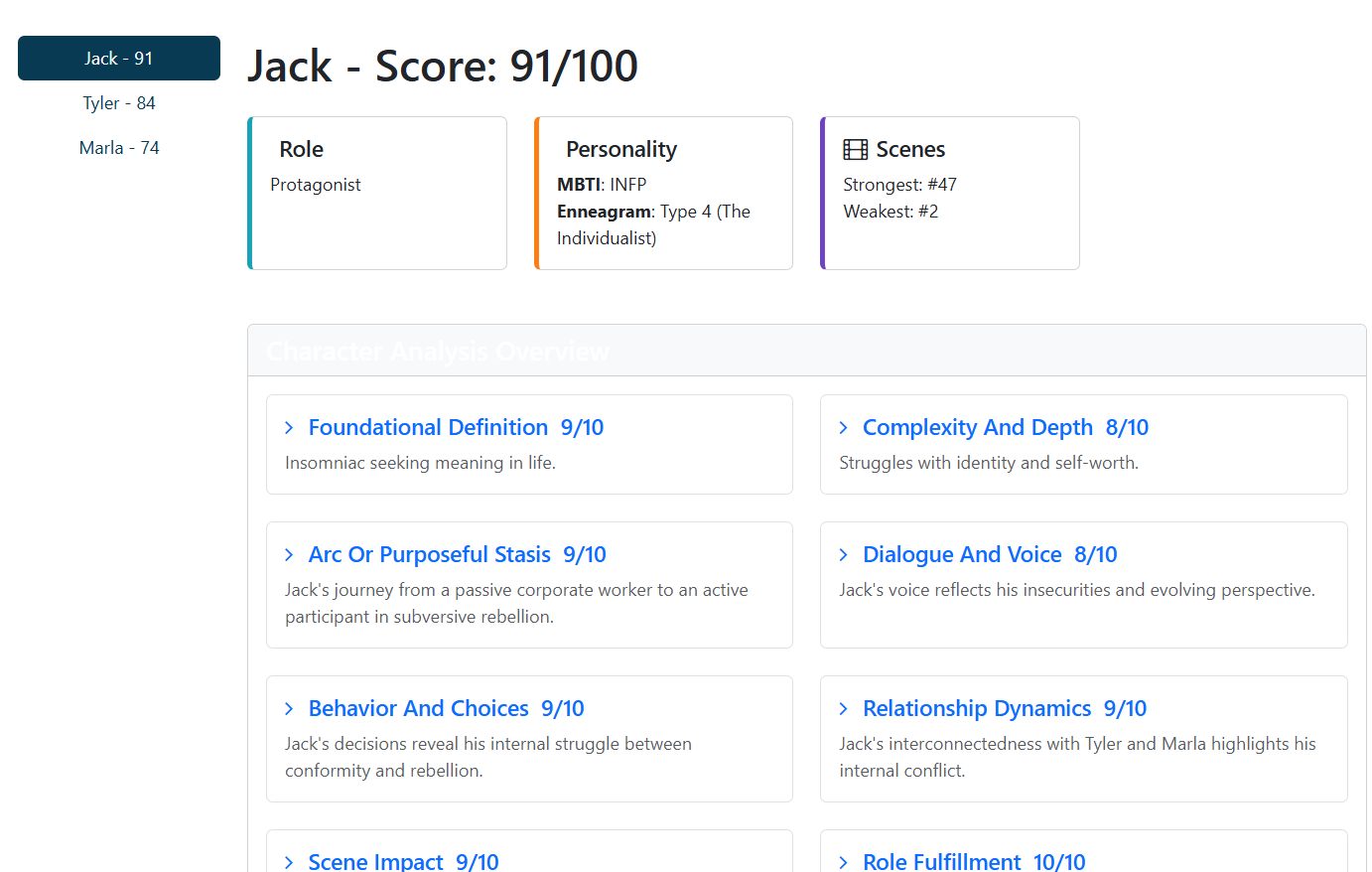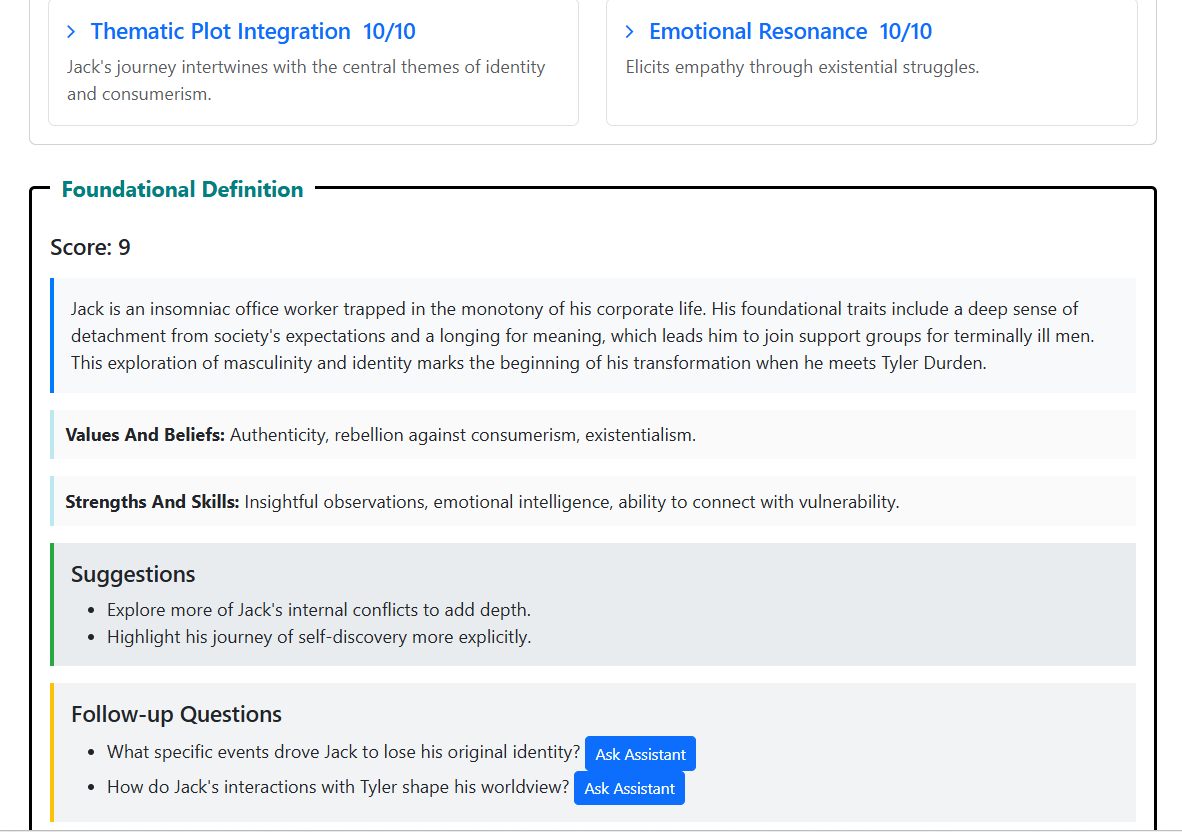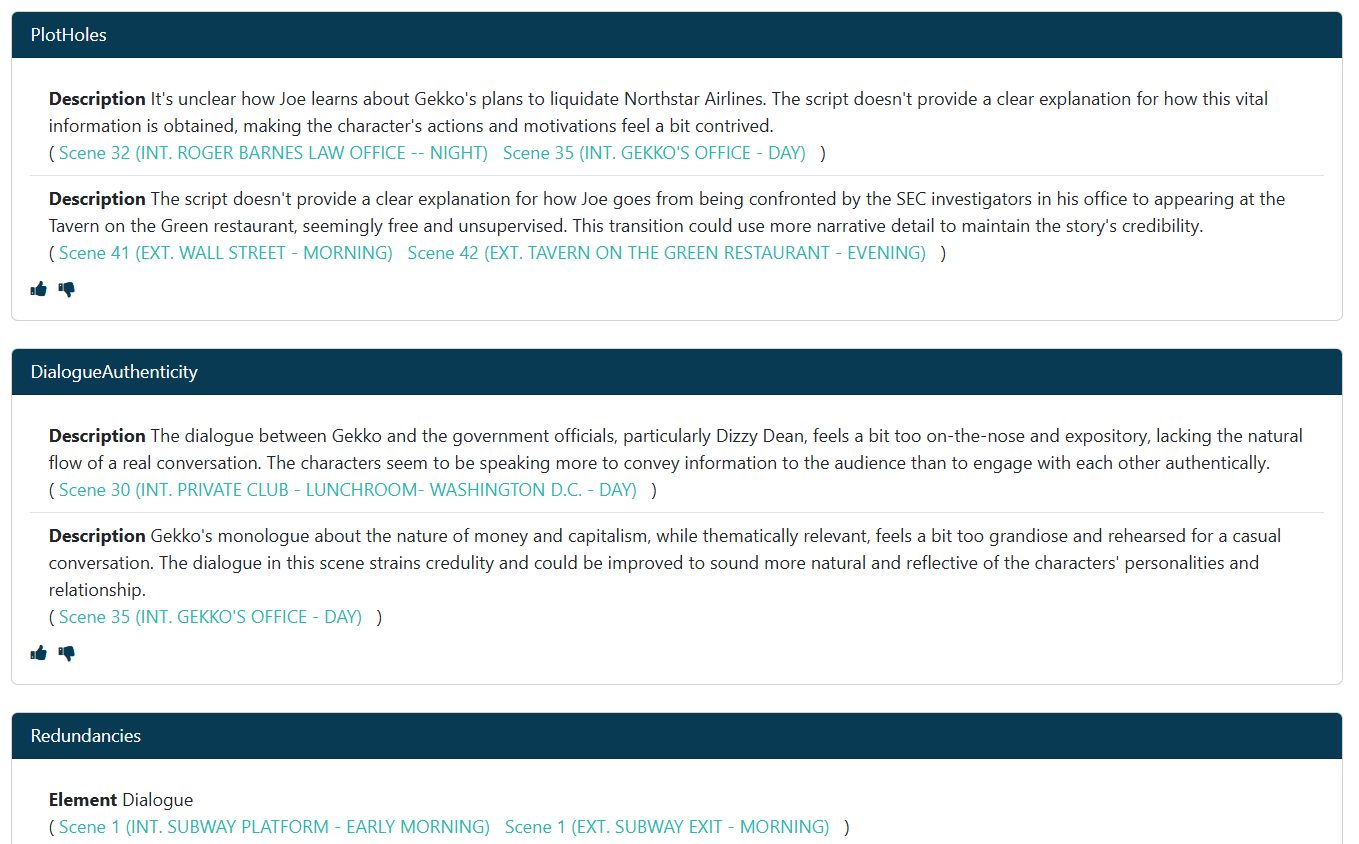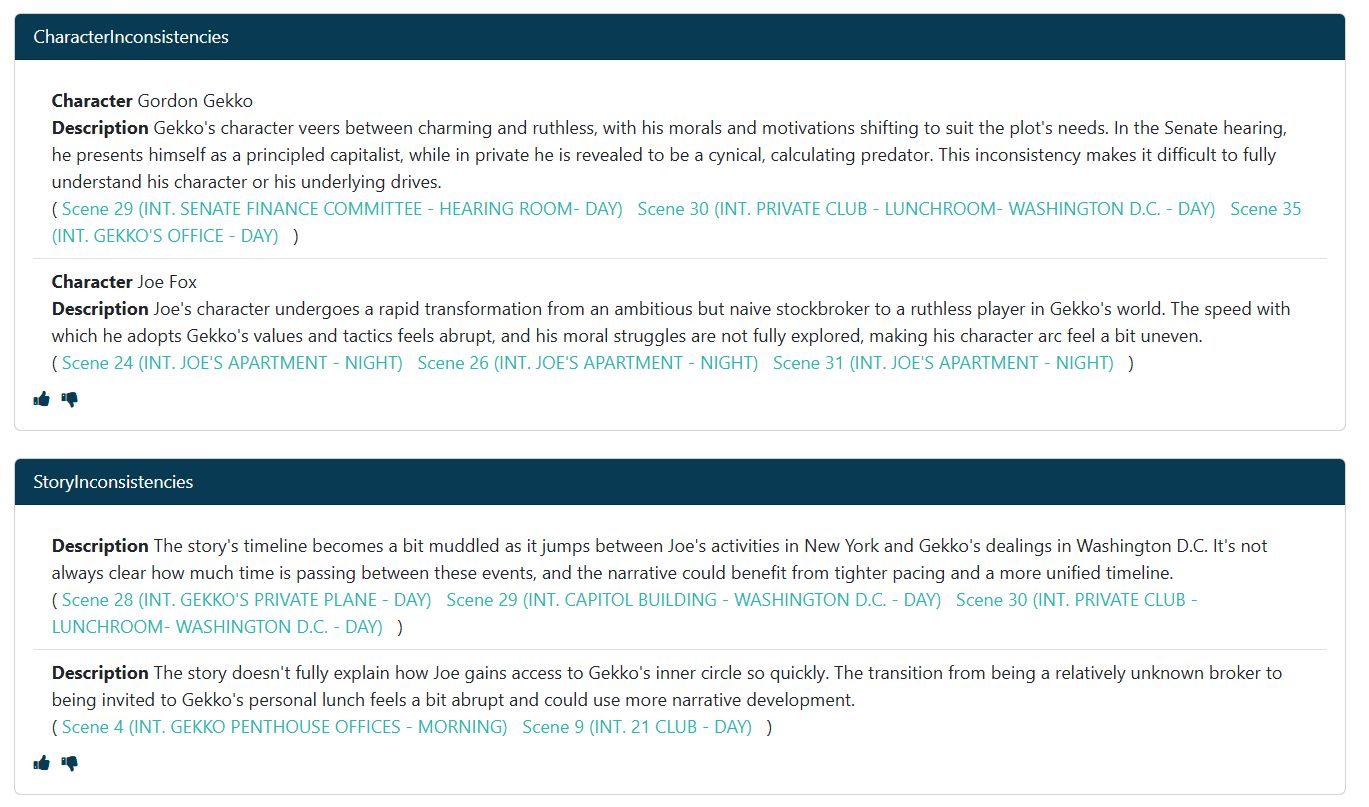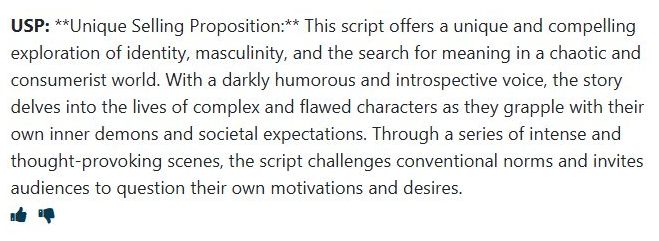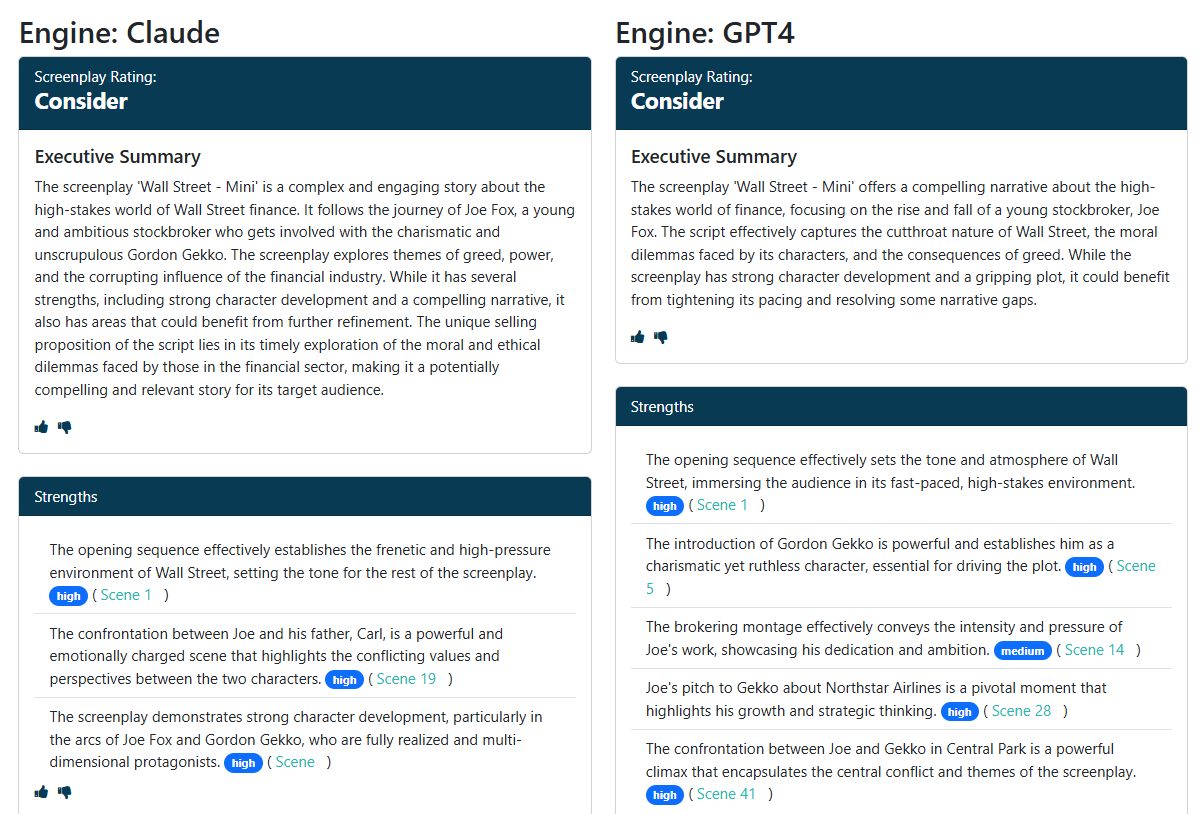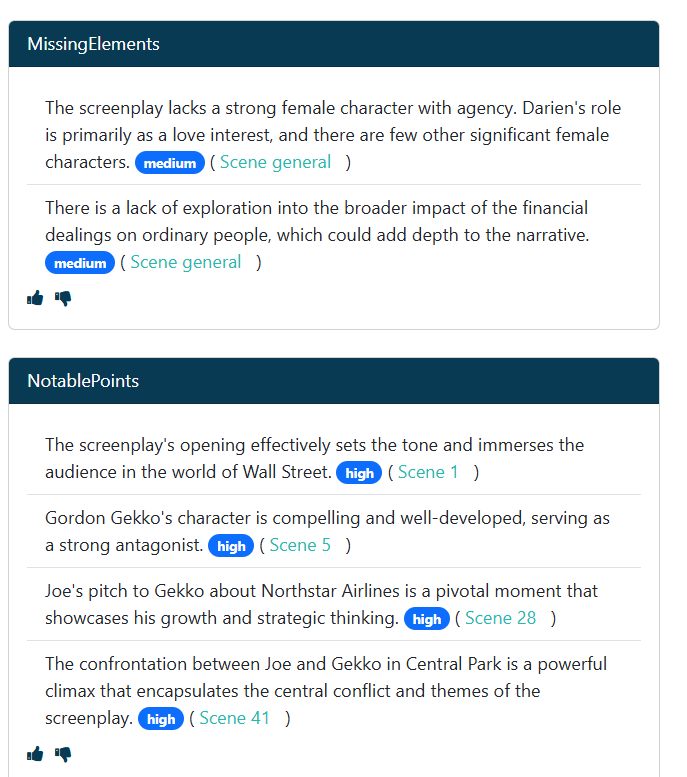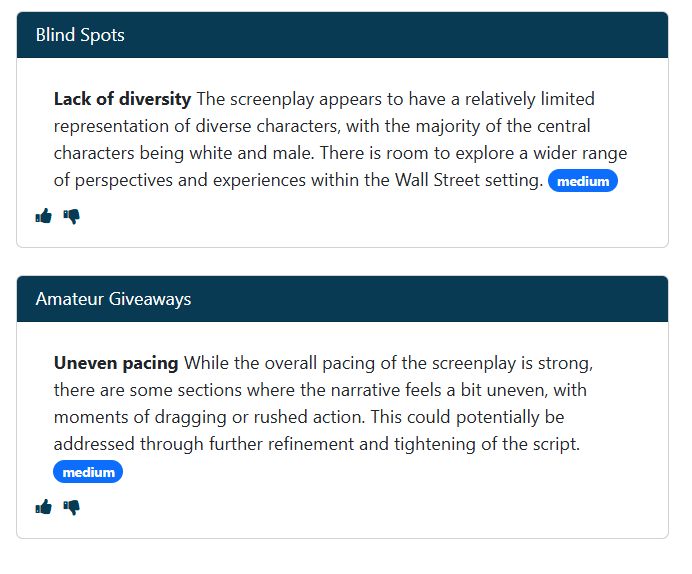View Analysis
View Script
PART TWO
by
Denis Villeneuve & Jon Spaihts
ii.
Power over Spice is power over all.
1 BLACK 1
A young female voice.
IRULAN (V.O.)
Imperial diary. Year 10191. Third
comment.
2 EXT. ARRAKEEN TARMAC - MORNING 2
Huge piles of thousands of human bodies burning in the
morning light. HARKONNEN SOLDIERS are using flamethrowers to
ignite the remains.
IRULAN (V.O.)
The battle for Arrakis took
everyone by surprise. There were no
witnesses. The Harkonnen operation
was perpetrated overnight, without
warning or declaration of war.
An Atreides officer’s insignia melting in the flames.
IRULAN (V.O.)
By morning, the Atreides were no
more. All died in the dark.
Dark smoke rising in the morning sky.
More columns of dark smoke are seen all around, against the
rising sun. It was a massacre.
Tone: Dark, Tragic, Intense
Ratings
The #1 Rule of Screenwriting: Make your reader or audience compelled to keep reading.
“Grab ‘em by the throat and never let ‘em go.”
The scene level score is the impact on the reader or audience to continue reading.
The Script score is how compelled they are to keep reading based on the rest of the script so far.
This opening scene effectively sets a dark and foreboding tone for the screenplay, immediately drawing the reader into the world of Arrakis. The vivid imagery of burning bodies and the destruction of the Atreides creates a visceral impact, compelling the reader to want to understand the implications of this massacre. The voiceover from Irulan adds a layer of narrative depth, hinting at the larger political machinations at play. The scene ends with a sense of loss and tragedy, leaving the reader eager to learn how these events will shape the story and the characters involved.
Overall, the screenplay so far maintains a compelling narrative momentum. The opening scene introduces a significant conflict and establishes the stakes for the Atreides family, while subsequent scenes hint at complex character dynamics and political intrigue. The reader is left with questions about the fate of the Atreides and the motivations of the Harkonnens, which keeps the interest alive. The emotional resonance of the initial massacre is echoed in later scenes, suggesting that the consequences of this event will ripple throughout the story, enhancing the reader's desire to continue.
Expert Critiques
Expert Suggestions
View Analysis
View Script
A CHEOPS chessboard. A game in progress. An elegant regal
young woman, PRINCESS IRULAN, makes a move. She waits. Her
opponent, a charismatic old man with enigmatic features and
sad eyes - The PADISHAH EMPEROR SHADDAM IV - seems lost in
thought, as though he had forgotten about the game.
IRULAN (V.O.)
And the Emperor said nothing.
Since that night, my father has not
been the same.
She keeps her eyes on her father, studying him.
IRULAN (V.O.)
Nor have I.
4 INT. IRULAN’S OFFICE - DAY 4
Irulan talks into the recording device microphone.
IRULAN
His inaction is difficult for me to
accept.
5 EXT. ARRAKEEN TARMAC - MORNING 5
A pile of large oil painting portraits being thrown into the
flames by Harkonnen soldiers. The portrait of Duke Leto
Atreides burning, quickly.
IRULAN (V.O.)
For I know he loved Duke Leto
Atreides like a son.
A closer look at Leto, engulfed by the flames.
6 EXT. ARRAKEEN TARMAC - MORNING 6
Thousands of Harkonnen soldiers aligned in perfect order.
BEAST RABBAN HARKONNEN stands on a ceremonial carpet and
lowers his head.
IRULAN (V.O.)
But my father has always been
guided by the calculus of power.
A huge shadow lands on him - BARON VLADIMIR HARKONNEN (who
seems weaker) hovers above him and puts a HEAVY BLACK
MEDALLION around his neck.
IRULAN (V.O.)
This would not be the first time
the Harkonnens have done his dirty
work.
The Baron blesses Rabban who stands, victorious. The entire
army cheers.
7 INT. IRULAN’S OFFICE - DAY 7
Irulan finishes her recording session.
IRULAN
In the shadows of Arrakis lie many
secrets.
8 SPACE 8
ARRAKIS seen from orbit. The Southern hemisphere disappears
in the dark.
IRULAN (V.O.)
And the darkest of them all may
remain the end of House Atreides.
One of the moons casts a shadow over the Northern hemisphere:
a SPECTACULAR ECLIPSE occurs. Sun rays hit the camera lens
generating RED FLARES, the MAIN TITLE APPEARS:
DUNE : PART TWO
9 WOMB 9
A three-week-old EMBRYO floats in amniotic fluid.
PAUL (V.O.)
(whispering, a confession)
Sister - Father is dead. Shouldn’t
you go back to the stars? Be with
him? I’m afraid I won’t have enough
time to fix things before your
coming. This world is beyond
cruelty.
Tone: Grim, Reflective, Melancholic
Ratings
The #1 Rule of Screenwriting: Make your reader or audience compelled to keep reading.
“Grab ‘em by the throat and never let ‘em go.”
The scene level score is the impact on the reader or audience to continue reading.
The Script score is how compelled they are to keep reading based on the rest of the script so far.
This scene effectively builds on the tension established in the previous scene by delving into the emotional aftermath of the Atreides' destruction. Irulan's reflections on her father's inaction and the burning of Duke Leto's portrait create a poignant sense of loss and betrayal. The scene ends with a powerful visual of an eclipse, symbolizing the dark fate of House Atreides, which leaves the reader eager to learn more about the implications of these events. The combination of personal conflict and broader political intrigue compels the reader to continue.
Overall, the screenplay maintains a strong momentum with its exploration of themes such as power, betrayal, and the consequences of inaction. The introduction of Irulan's perspective adds depth to the narrative, while the ongoing conflict between the Harkonnens and the Atreides keeps the stakes high. The emotional weight of the previous scenes, combined with the new developments in this scene, ensures that the reader remains engaged and curious about the unfolding story. However, some earlier plot threads could benefit from re-engagement to maintain interest.
Expert Critiques
Expert Suggestions
View Analysis
View Script
The ECLIPSE is almost total.
PAUL ATREIDES awakes, startled, and finds CHANI hushing him
with authority - Quiet!
Paul is completely disoriented. He was having a vision, lying
in the shade of a rock, on a large dune slope. The sun is
hidden by one of the moons. The world is eerily DARK and RED.
JAMIS’ bodybag lies close by.
Chani moves away swiftly like a cat, revealing behind her -
JESSICA who makes a quick hand signal (subtitled): Enemy.
We hear Harkonnen language in the distance.
Paul gets his senses back. Beside him, STILGAR unfolds his
MAULA PISTOL, and whispers -
STILGAR
Stay here.
He disappears behind the rock with his FREMEN PATROL.
Paul and Jessica exchange a quick look, then slowly crawl
toward the top of the dune and peek above it: THIRTY
HARKONNEN SOLDIERS armed with lasguns, in full desert battle
gear, landing quietly, using suspensors. A hovering TROOP
TRANSPORT silently moves away.
The soldiers switch OFF their suspensors and slowly start
walking in Paul and Jessica’s direction. The only sound is
the barely audible hums of the soldiers’ breathing systems.
Paul peeks again - They are getting much closer.
ON JESSICA who makes a hand signal: Down - right.
They both move downhill, toward the base of the rock, and
quickly hide under a recess.
The soldiers reach the crest of the dune, rising against the
sky like spectral vampires. They immediately find Jamis’
remains, then Paul and Jessica’s footsteps. Some draw their
tactical daggers. The soldiers slowly head downhill,
following the footsteps.
HARKONNEN COMMANDER
(Harkonnen, subtitled)
They’re close.
Paul and Jessica are barely hidden by the recess.
The Harkonnens are getting closer.
Paul and Jessica hold their breaths, becoming completely
still. Jessica keeps her hands on her belly. We can hear the
barely audible breaths of the soldiers getting closer... and
closer... and closer. Paul tries to keep calm. He grabs the
only weapon he can find: a rock. From the corner of his eye,
he can see one of the soldiers now - he is just about to be
discovered as -
Thump.
The soldier shivers and turns toward the source of the sound,
somewhere, behind, in the dunes.
HARKONNEN SOLDIER #1
(Harkonnen, subtitled)
Do you hear that!?
Thump. Thump.
The entire platoon looks around to find the source of the
rhythmic sound.
Thump. Thump. Thump.
HARKONNEN SOLDIER #2
(Harkonnen, subtitled)
The rats are calling a worm!
Two scouts start to run toward the rock.
HARKONNEN SOLDIER #3
(Harkonnen, subtitled)
Worms!
HARKONNEN SQUAD LEADER
(Harkonnen, subtitled)
Unit. Climb. Now!
The soldiers sprint toward the rock, activate their
suspensors and jump, rising up with elegance, gliding up in
the air like scuba divers under water.
We now see that the scene has been happening around a
solitary gigantic monolith in the middle of a sea of sand
dunes. The soldiers reach its top.
TOP OF THE MONOLITH
Harkonnen SNIPERS scan the area and spot in the distance - an
activated THUMPER at the top of a dune.
Thump. Thump. Thump.
One of the snipers shoots it with his lasgun - Silence again.
The soldiers are nervous.
HARKONNEN SQUAD LEADER (CONT'D)
(Harkonnen, subtitled)
Look for wormsign.
The snipers scan the area.
The desert is still.
The Eclipse is now total.
HARKONNEN SQUAD LEADER (CONT'D)
(Harkonnen, subtitled)
We are OK.
SHHHHHHTONK! A projectile hits the Squad Leader, piercing his
helmet. He stands still, in silence. His men turn toward him.
The Squad Leader falls from the heights, like a rock, as
another soldier gets shot.
HARKONNEN SOLDIER #2
(Harkonnen, subtitled)
SHIELDS!
SNIPER
(Harkonnen, subtitled)
NO SHIELDS!!! NO SHIELDS!!!
SHHHHHHTONK! The Sniper is hit and falls from the heights.
ON PAUL AND JESSICA
The Sniper’s body falls straight in front of Paul with
muffled impact.
Dead Harkonnen soldiers fall like stones around them. The
horrible sound of bodies hitting the sand. Strangled SCREAMS
above. Lasgun beams rake the darkening sky. Two Harkonnens
fall, dead.
Suddenly a HARKONNEN LIEUTENANT lands, his fall slowed down
by his suspensors, and sees them. Paul spots a dead soldier’s
sword several feet away, and sprints for it. The Lieutenant
charges! Paul has just enough time to reach the sword
avoiding the deadly blow.
A brief sword duel. The Lieutenant is stronger, but Paul,
faster, kills him with one spectacular strike.
Paul hears something behind him. At the top of the dune, a
SNIPER is about to shoot him. Out of breath, the young man
contemplates death.
HARKONNEN SOLDIER #4
(Harkonnen, subtitled)
I got you, rat.
Jessica appears behind the sniper and smashes his helmet with
the only weapon available: a melon-sized rock.
The Sniper goes down, Jessica pins him down with her legs.
She smashes the rock on the helmet: the visor shatters,
venting conditioned air. She hammers the rock again and
again, staving in the helmet and the skull within.
Silence falls.
Jessica walks down toward Paul.
JESSICA
Never stand with your back to the
open! How many times do we have to
tell you!
PAUL
You OK?
Jessica nods. Paul points to her belly.
PAUL (CONT'D)
What about her?
Jessica is surprised that Paul already knows the embryo’s
gender.
JESSICA
She’s fine.
ON THE OTHER SIDE OF THE ROCK
The sunlight is slowly returning to normal.
Scores of Harkonnen bodies lie scattered around the pillar.
Stilgar and his Fremen move among the fallen, ruthlessly
killing the wounded. Other Fremen rush to the dead, taking
instruments out of their fremkits.
Paul looks at the dead bodies around them, impressed. Fremen
are truly strong fighters. Desert Power.
Stilgar kills a wounded soldier without really paying
attention. He seems worried.
STILGAR
They do not usually venture this
deep.
PAUL
They want to make sure no Atreides
escaped.
Stilgar reloads his maula pistol with new darts.
STILGAR
(laughing)
You think too much of yourself! We
are in the deep desert. Only Fremen
can survive here. They were here
for us. Not for you - Don’t worry,
I’m bringing you somewhere they
will never find us.
Jessica looks at the Fremen extracting the water from dead
soldiers, using suction tools connected to plastic bladders.
Jessica refrains from throwing up. Stilgar tries to reassure
her.
STILGAR (CONT'D)
Filthy water. Full of chemicals.
But good enough for cooling
systems.
That doesn’t help. Jessica is trying to hold it in.
STILGAR (CONT'D)
Don’t let it out...
That doesn’t help, either.
Paul turns to his mother, concerned.
PAUL
You okay?
Jessica nods, trying to stay focused.
STILGAR
Don’t let it out!
Too late. She turns around to let the inevitable happen.
Stilgar shakes his head, discouraged, mumbling to himself.
She’s not fit for the desert.
JESSICA
I’m okay.
PAUL
Are you sure?
Jessica nods.
Chani sits beside a young Harkonnen soldier who is slowly
dying, taking his water with precision. The young soldier
dies. Chani isn’t moved at all. Done. She smiles at Paul as
though she had just taken a cake out of the oven.
CHANI
You fought well - once you woke up.
PAUL
I wasn’t sleeping.
Chani shakes her head. Yes he was!
Stilgar looks at the sky. The eclipse is almost over.
STILGAR TRANSLATION
(Chakobsa) Oma isadha.
We must leave.
The Fremen are packing dozens of water-filled bladders in
their bags. Others are piling up the bodies.
One of the Fremen sets up a thumper beside the pile of
bodies, adjusts it and releases the latch. Jessica
understands what they are doing - it’s clever.
As Jamis’ bodybag is about to be lifted by young fighters.
Paul grabs one of its handles.
PAUL
I’ll do it.
Chani notices Paul’s attention and respect for Jamis.
They leave by sandwalking as the thumper keeps hammering the
sand.
Thump. Thump. Thump.
The Harkonnen bodies are swallowed by a worm.
Tone: Tense, Suspenseful, Intense, Dramatic
Ratings
The #1 Rule of Screenwriting: Make your reader or audience compelled to keep reading.
“Grab ‘em by the throat and never let ‘em go.”
The scene level score is the impact on the reader or audience to continue reading.
The Script score is how compelled they are to keep reading based on the rest of the script so far.
This scene is highly compelling as it builds intense suspense and action. The tension escalates with the Harkonnen soldiers closing in on Paul and Jessica, creating a palpable sense of danger. The unexpected ambush by the Fremen adds an element of surprise, and the swift, brutal combat showcases the stakes involved. The scene ends with a dramatic moment as Paul shows respect for Jamis, hinting at deeper character development and emotional connections. The combination of action, character dynamics, and the looming threat of the Harkonnens effectively compels the reader to continue to the next scene.
Overall, the screenplay maintains strong momentum with ongoing conflicts and character arcs. The introduction of the Fremen as formidable allies and the exploration of Paul’s evolving identity keep the reader engaged. However, some earlier plot threads, such as the implications of Jessica's pregnancy and the broader political machinations, could be more directly tied into the current action to sustain interest. The emotional stakes are heightened in this scene, particularly with Paul’s respect for Jamis, which adds depth to his character and the narrative. This balance of action and character development continues to draw the reader forward.
Expert Critiques
Expert Suggestions
View Analysis
View Script
INSERT on a holographic map: the ICON OF THE HARKONNEN
PLATOON turns RED.
A 3D projection of a map of Arrakis’ NORTHERN HEMISPHERE
illuminates a military SOLIDO console where we can see the
aerial traffic and Harkonnen troops deployment.
Nine OPERATORS plugged onto the console like dark insects are
reading the data, a strange Harkonnen a cappella melody.
12 EXT. ARRAKEEN - SAME MOMENT 12
The city of Arrakeen. Harkonnen structures have been built on
top of the destroyed area, a growing black cancer.
13 INT. ARRAKEEN RESIDENCY WAR ROOM - SAME MOMENT 13
A HARKONNEN COMMANDER doesn’t like what he’s seeing and
hearing - even less the smell suddenly rising behind him:
BEAST RABBAN HARKONNEN wearing large stained pajamas,
obviously drunk, enters the room.
HARKONNEN COMMANDER
Lord Rabban, now that spice fields
have been secured, I strongly
recommend bringing all troops out
of Fremen territories. We’re losing
too many men to the desert.
Rabban is so drunk he can barely think. He looks at the red
zone on the map. Fremen territories.
RABBAN
Rats?
HARKONNEN COMMANDER
I beg your pardon?
RABBAN
We are losing men to RATS? -
Rabban becomes threatening. Right behind the Beast, an
OFFICER discreetly mouths: Fremen. The Commander gets it.
HARKONNEN COMMANDER
Fremen! - I can’t confirm, my Lord.
Communications are hectic in the
open sands.
Rabban gets closer to the hologram, hypnotized by the red
zone, as though it were a hallucination. He is tripping.
RABBAN
Your orders were to control the
whole planet.
HARKONNEN COMMANDER
We are.
RABBAN
I see only half of it.
The Commander looks at his subalterns: the Beast is hopeless.
HARKONNEN COMMANDER
The South is uninhabitable, my
Lord. May I suggest you get some
rest -
WITHOUT WARNING, the Beast JABS the Commander straight into
the neck, with such strength that he is projected onto the
console. Rabban smashes his face into pulp. A volatile burst
of incomprehensible rage.
RABBAN
RATS!!! KILL THEM!!! KILL THEM
ALL!!! KILL THEM ALL!!! RATS!!
Tone: Tense, Threatening, Chaotic, Triumphant
Ratings
The #1 Rule of Screenwriting: Make your reader or audience compelled to keep reading.
“Grab ‘em by the throat and never let ‘em go.”
The scene level score is the impact on the reader or audience to continue reading.
The Script score is how compelled they are to keep reading based on the rest of the script so far.
This scene effectively builds tension and showcases the chaotic atmosphere within the Harkonnen war room. The drunkenness of Rabban adds a layer of unpredictability, making the reader curious about how his volatile behavior will impact the ongoing conflict. The scene ends with a violent outburst, leaving the audience eager to see the consequences of Rabban's rage and how it will affect the Fremen and the overall battle strategy. The unresolved tension regarding the Fremen's threat and Rabban's unstable leadership creates a compelling reason for the reader to continue.
Overall, the script maintains a strong momentum with escalating conflicts and character developments. The introduction of Rabban's erratic behavior adds a new layer of unpredictability, while the ongoing threat of the Fremen keeps the stakes high. Previous scenes have established a sense of urgency and impending doom, and this scene reinforces that tension. The unresolved conflicts and the buildup to a larger confrontation ensure that the reader remains engaged and eager to see how the story unfolds.
Expert Critiques
Expert Suggestions
View Analysis
View Script
The Fremen patrol walks through a narrow canyon.
ON PAUL, feeling the presence of shadows. They are being
spied on from the heights. Stilgar makes a WEIRD CLICK with
his tongue, like a bird. An answer comes from the heights.
Shadows land around them: FREMEN SENTINELS.
The SENTINEL LEADER exchanges a few words with Stilgar,
throws a look at Paul and Jessica. Chani translates for Paul.
CHANI
He’s asking why we are so late -
They think you are spies...
Stilgar whispers something in the sentinel leader’s ear. The
sentinel leader turns to Paul and Jessica.
SENTINEL LEADER TRANSLATION
(Chakobsa) So unaarahashii fadil zih.
You’re not welcome here.
Chani is about to translate -
PAUL
I got that. Thanks.
STILGAR
Stay close to me.
The patrol heads toward a narrow vertical opening in the
rock.
15 INT. SIETCH TABR - RIGHT AFTER 15
SIETCH TABR is an ancestral underground troglodyte village
carved in the rock, filled with sand. In some areas, the sand
is only a few feet from the ceiling.
STILGAR
Sietch Tabr.
Paul takes in his surroundings. It feels familiar to him.
A growing crowd of onlookers greet them.
Stilgar seems to know everybody. Everybody knows Stilgar.
He’s their NAIB, their leader and they trust him.
STILGAR (CONT'D) TRANSLATION
(Chakobsa, not Oga! Oga ozii.
subtitled) *
Move! Move away!
Women welcome Jamis’s remains with lamentations: La, La, La,
La! More and more Fremen want to touch Jamis’ body and start
pushing. Most of them are hostile toward Paul and Jessica.
Paul protects his mother, who puts her hands on her womb. In
Chakobsa: What are they doing here? WITCH! SPIES! Leave them
to the desert! IMPOSTOR!
Stilgar attempts to calm the angered crowd.
Some Fremen seem more welcoming: Mahdi! They don’t know what
they are saying! Lisan Al-Gaib! Both camps start to argue
with more and more vehemence. Paul doesn’t seem afraid. Chani
notices.
CROWD CHAKOBSA TRANSLATION
Ru-che kaah zih? CHIFTHIT! RAABJIL!
Sahtha reshme noqadhakaa! ZOTHIB! E
Mahdi! Vii she Lisaan al-Gayib?
Stilgar keeps his eyes on Paul, fascinated.
Tone: Tense, Hostile, Fascinated
Ratings
The #1 Rule of Screenwriting: Make your reader or audience compelled to keep reading.
“Grab ‘em by the throat and never let ‘em go.”
The scene level score is the impact on the reader or audience to continue reading.
The Script score is how compelled they are to keep reading based on the rest of the script so far.
This scene effectively builds tension as Paul and Jessica navigate the hostile environment of Sietch Tabr, where their identities are questioned by the Fremen. The conflict between the welcoming and hostile factions within the crowd creates a palpable sense of danger and uncertainty. The scene ends with a heated argument among the Fremen, leaving the audience eager to see how Paul will assert his identity and navigate this precarious situation. The unresolved tensions and the potential for conflict compel the reader to continue to the next scene.
Overall, the screenplay maintains a strong momentum with ongoing character arcs and conflicts. The introduction of the Fremen's mixed reactions to Paul and Jessica adds layers to the narrative, highlighting the complexities of identity and acceptance in a hostile environment. Previous scenes have established the stakes surrounding Paul’s destiny, and this scene deepens the intrigue as it hints at the challenges he will face in gaining the trust of the Fremen. The unresolved tensions from earlier scenes continue to resonate, keeping the reader engaged.
Expert Critiques
Expert Suggestions
View Analysis
View Script
Sietch Tabr’s council: a dozen ELDERS sit in a circle on
carpets, wise old men and women, with deep blue eyes.
STILGAR TRANSLATION
(Chakobsa) Ruqaafiikaa dimalanii rii
I need your guidance with the liksit thaa.
two foreigners.
FEMALE ELDER TRANSLATION (CONT'D)
(Chakobsa, impatient) Qabdhikakaa a-reshme.
Give them back to the desert.
Stilgar weighs his next words.
STILGAR TRANSLATION (CONT'D)
(Chakobsa) Heshkii shyadhza.
I saw the signs.
FEMALE ELDER TRANSLATION (CONT'D)
(Chakobsa, amused) Yoshla.
Again.
OLDEST ELDER TRANSLATION (CONT'D)
(Chakobsa) E Stilgar, erah chaiya
Stilgar, your faith is heshkasha shyadhza?
playing tricks on you. Jahhuufahashii minzidhash a-
fii.
FEMALE ELDER TRANSLATION (CONT'D)
(Chakobsa, amused) So chukkuha Lisaan al-Gayib
The Lisan al-Gaib has not lek! He, he, he! So a-vadzih!
shown his face yet!
Stilgar takes a deep breath: they won’t believe him.
STILGAR TRANSLATION (CONT'D)
(Chakobsa) Vizdhaha Jamsa o zanla vejii.
He killed Jamis in a fair Jaraagaha sa kyurhum.
fight. He speaks our Hajaagaha nichii geftham.
language. He will quickly Qiraashii dhikadhaho eddemii.
learn our ways. I'm ready to
pledge my life for him.
FEMALE ELDER TRANSLATION (CONT'D)
(Chakobsa) Ru resham dimadhag vanraha.
The desert will handle his
fate.
The Elders are all satisfied, but one -
OLDEST ELDER TRANSLATION (CONT'D)
(Chakobsa) Hi rii bil?
What about the woman?
Tone: Serious, Mysterious, Tense
Ratings
The #1 Rule of Screenwriting: Make your reader or audience compelled to keep reading.
“Grab ‘em by the throat and never let ‘em go.”
The scene level score is the impact on the reader or audience to continue reading.
The Script score is how compelled they are to keep reading based on the rest of the script so far.
This scene effectively builds tension as Stilgar seeks the council's approval for Paul and Jessica's acceptance among the Fremen. The dialogue showcases the elders' skepticism and the cultural significance of the Lisan al-Gaib, which adds depth to the conflict. The scene ends with an unresolved question about Jessica's fate, leaving the reader curious about her acceptance and the implications for Paul. The interplay of faith, tradition, and the elders' authority creates a compelling push to continue reading.
Overall, the script maintains a strong momentum with ongoing character development and unresolved conflicts. The tension surrounding Paul and Jessica's acceptance among the Fremen, coupled with the looming threat of the Harkonnens, keeps the stakes high. The introduction of the elders and their skepticism adds layers to the narrative, while the unresolved questions about Jessica's fate create a sense of urgency. The reader is likely to feel compelled to continue exploring how these dynamics will unfold.
Expert Critiques
Expert Suggestions
View Analysis
View Script
ON JESSICA
Sitting with Paul, apart from Chani and the rest of the
Fremen patrol. All are eating some orange dry porridge.
Jessica doesn’t eat. She looks around. She can feel the
hostility in the room. They are so far away from home! The
younger fighters give Paul harsh looks. Paul doesn’t flinch.
Among them a young squad leader with a strong presence,
SHISHAKLI. Shishakli eats, huddling with Chani. Paul throws
discreet looks at Chani. Chani feels it. Shishakli doesn’t
know what to make of this.
PAUL
Look how your Bene Gesserit
propaganda has taken root. Even
here. In sand.
A look at several Fremen staring at Paul as if he were the
new incarnation of Buddha.
PAUL (CONT'D)
Some of them already think I’m
their messiah. Others, a false
prophet.
A look at Chani, Shishakli and the younger fighters who keep
looking at him with distrust and defiance.
PAUL (CONT'D)
I must sway the non-believers.
He exchanges a look with Chani and the young fighters.
PAUL (CONT'D)
If they follow me, we can disrupt
spice production. That’s the only
way I can get to the Emperor.
JESSICA
Your father didn’t believe in
revenge.
PAUL
Well, I do.
Paul goes pale.
Chani and Shishakli notice Paul’s discomfort.
A flash in his mind...
Tone: Tense, Defiant, Hostile, Emotional
Ratings
The #1 Rule of Screenwriting: Make your reader or audience compelled to keep reading.
“Grab ‘em by the throat and never let ‘em go.”
The scene level score is the impact on the reader or audience to continue reading.
The Script score is how compelled they are to keep reading based on the rest of the script so far.
This scene effectively builds tension and conflict as Paul grapples with the perception of him among the Fremen. The dialogue reveals the internal struggle he faces regarding his identity and the expectations placed upon him, particularly the contrasting views of him as a messiah or a false prophet. The scene ends with Paul expressing a desire for revenge, which adds a layer of complexity to his character and raises questions about his future actions. The emotional stakes are high, compelling the reader to want to see how these dynamics will unfold in the next scene.
Overall, the script maintains a strong momentum as it explores the evolving dynamics between Paul, Jessica, and the Fremen. The introduction of new conflicts, such as the skepticism of the Fremen towards Paul and the implications of his potential messiah status, keeps the reader engaged. The emotional weight of Paul's internal conflict and his determination to disrupt spice production adds urgency to the narrative. As unresolved tensions continue to build, the reader is likely to feel compelled to continue reading to see how these conflicts will resolve.
Expert Critiques
Expert Suggestions
View Analysis
View Script
A sandblasted SKULL in a tabernacle alcove. Above it, a small
oil portrait of Duke Leto, looking at us with infinite
sadness.
BACK TO REALITY
SHISHAKLI TRANSLATION
(Chakobsa) Vaiyiz omaiz o lekset?
Too spicy for the foreigner?
They all giggle, but Chani.
Jessica looks at Paul, concerned.
JESSICA
What is it?
Paul sees orange particles from the sauce of their meal:
spice.
PAUL
There’s spice in the food.
SHISHAKLI TRANSLATION
He’ll look pretty with blue Yazaabaha noj watha Ibad.
eyes.
CHANI TRANSLATION (CONT'D)
(Chakobsa) So vaklaho. Oma hesshyuho
Don’t mock him. He deserves vothim. Ho zamit cheshii.
our respect. He’s a good
fighter.
Stilgar interrupts their meal.
STILGAR
(to Jessica)
Woman, come with me.
19 INT. SIETCH TABR, ROOM OF THE DEAD - RIGHT AFTER 19
Fremen women wearing frightening ceremonial masks, the
WATERMASTERS, open Jamis’ bodybag swiftly with ceremonial
scissors. JAMIS’ identity is revealed, as his mouth, ears,
nose and eyes are immediately sealed with desert beeswax. One
of them cuts the WATER RINGS.
Jamis’ naked body is promptly wrapped in a tight plastic
sophisticated sarcophagus as several tubes are plugged into
it. Water starts to be pumped into a filtration system and
into ceremonial water bladders.
Tone: Tense, Mysterious, Ceremonial
Ratings
The #1 Rule of Screenwriting: Make your reader or audience compelled to keep reading.
“Grab ‘em by the throat and never let ‘em go.”
The scene level score is the impact on the reader or audience to continue reading.
The Script score is how compelled they are to keep reading based on the rest of the script so far.
This scene effectively builds tension and intrigue as it transitions from a light-hearted moment to a more serious and somber atmosphere. The initial banter among the characters, particularly the teasing about spice in the food, contrasts sharply with the subsequent ritualistic preparation of Jamis' body, which adds a layer of gravity to the narrative. The scene ends with a visual of the Fremen women preparing Jamis for burial, leaving the reader with a sense of foreboding and curiosity about the cultural significance of this ritual. The juxtaposition of humor and death creates a compelling push to continue reading, as the reader is left wondering how these elements will affect Paul and Jessica's journey within the Fremen community.
Overall, the script maintains a strong momentum, with ongoing character development and unresolved conflicts that keep the reader engaged. The tension between Paul and the Fremen, particularly regarding his identity and acceptance, continues to build, especially as he grapples with the implications of being seen as a messiah. The introduction of Jamis' burial ritual adds depth to the Fremen culture and raises questions about loyalty, identity, and the weight of prophecy. As the stakes rise, the reader is compelled to see how these dynamics will unfold, particularly with the impending challenges Paul and Jessica will face in gaining the trust of the Fremen.
Expert Critiques
Expert Suggestions
View Analysis
View Script
A gigantic cistern of millions of gallons of water. The
Watermasters and a family of Fremen are praying by the pool.
Jessica enters the room, amazed by the sight.
STILGAR
Thirty-eight million decaliters.
None of us, even dying of thirst,
would ever drink this water - This
is sacred.
The Watermasters pour Jamis’ water respectfully into the
cistern. Stilgar and Jessica observe from a distance.
STILGAR (CONT'D)
Jamis’ water. We have a thousand
such places.
(MORE)
STILGAR (CONT'D)
When we have enough water, the
Lisan al-Gaib will change the face
of Arrakis. He will bring back the
trees. He will bring back a Green
Paradise.
Jessica understands where all that water is coming from.
JESSICA
So many souls.
Jessica is moved. Life and death don’t mean the same thing
here.
Stilgar delicately but swiftly captures the tear on her cheek
with the tip of his finger. He brings the tiny drop of water
to his mouth. There is something sensual about the
microscopic contact.
STILGAR
Ats! Ats! Ats!
(English)
Never give your water away, not
even for the dead.
Jessica nods. And that calm, controlled discipline returns.
JESSICA
Why are you showing me this?
STILGAR
Because you are Bene Gesserit.
Because you understand the
prophecies.
Stilgar points at the walls, covered with engraved Chakobsa
words: the prophecy.
STILGAR (CONT'D)
The Mother of the Lisan al-Gaib
will be a Reverend Mother.
(beat)
Our Reverend Mother is dying.
JESSICA
You want me to take her place.
STILGAR
Yes. I do.
JESSICA
You believe in Paul.
STILGAR
There are signs. Yes.
JESSICA
And if I refuse?
STILGAR
Then he is not Lisan al-Gaib. And
you have no purpose to serve. What
is left to do then -
(the pool)
But return your water to the well?
The rest need not be spoken. Jessica understands. She will be
the Reverend Mother. Or she will die.
Tone: Mysterious, Spiritual, Intense
Ratings
The #1 Rule of Screenwriting: Make your reader or audience compelled to keep reading.
“Grab ‘em by the throat and never let ‘em go.”
The scene level score is the impact on the reader or audience to continue reading.
The Script score is how compelled they are to keep reading based on the rest of the script so far.
This scene is highly compelling as it delves into the emotional and cultural significance of water among the Fremen, highlighting the sacredness of life and death in their society. The tension surrounding Jessica's potential transformation into a Reverend Mother adds a layer of urgency and stakes to the narrative. The scene ends with Jessica facing a pivotal choice that could alter her fate and that of Paul, leaving the reader eager to see how this decision will unfold. The interplay of prophecy, sacrifice, and identity creates a strong push to continue reading.
Overall, the script maintains a strong momentum with ongoing character arcs and unresolved tensions. The introduction of Jessica's potential role as a Reverend Mother deepens the stakes for both her and Paul, while the Fremen's beliefs and customs continue to enrich the world-building. However, some earlier plot threads, such as the Harkonnen threat, have not been revisited recently, which could risk losing reader interest if not addressed soon. The balance of new developments and lingering conflicts keeps the reader engaged.
Expert Critiques
Expert Suggestions
View Analysis
View Script
A small expedition is getting ready. Fedaykin are adjusting
their stillsuits, weapons, traveling equipment, backpacks and
fremkits. Stilgar gives instructions to Chani and Shishakli.
Paul helps Jessica adjust her stillsuit.
PAUL
It’s an honor - isn’t it? I think
you should be honored.
JESSICA
Well, it was a choice between this
or death, so forgive me if I’m not
flattered.
PAUL
How does one become a Reverend
Mother?
JESSICA
It’s different from one culture to
another. Here on Arrakis, I have no
idea.
Paul senses something in her.
PAUL
You’re afraid.
JESSICA
Reverend Mothers are tasked with
holding the memories of all the
Reverend Mothers who came before
them. I’ll be given centuries of
pain and sorrows.
PAUL
Is it dangerous?
Jessica finds a way to avoid his question.
JESSICA
It’s lethal for men. That’s for
sure.
22 EXT. DESERT, RAMALLO’S DEN - DAY 22
An opening in the rocks, like a dark eye - an ancient desert
shelter entrance. Chani and the Fedaykin stand guard around
it. Paul keeps his eyes on the opening. We enter the ominous
darkness.
Tone: Tense, Reflective, Foreboding
Ratings
The #1 Rule of Screenwriting: Make your reader or audience compelled to keep reading.
“Grab ‘em by the throat and never let ‘em go.”
The scene level score is the impact on the reader or audience to continue reading.
The Script score is how compelled they are to keep reading based on the rest of the script so far.
This scene effectively builds on the tension established in the previous scenes, particularly regarding Jessica's acceptance of her role as a Reverend Mother. The dialogue between Paul and Jessica reveals her fears and the weight of her impending responsibilities, which adds emotional depth and stakes to the narrative. The scene ends with a sense of foreboding as they prepare to enter Ramallo's Den, leaving the reader curious about what lies ahead and how Jessica's transformation will impact the story. The combination of personal conflict and the ominous setting creates a compelling push to continue reading.
Overall, the script maintains a strong momentum, with ongoing character development and unresolved conflicts that keep the reader engaged. Jessica's internal struggle and the implications of her becoming a Reverend Mother add layers to the narrative, while Paul's determination to support her and assert his own identity as a leader further enrich the plot. The introduction of new settings and the looming threat of the Harkonnens continue to create suspense, ensuring that the reader is eager to see how these elements will unfold in the upcoming scenes.
Expert Critiques
Expert Suggestions
View Analysis
View Script
A TWO HUNDRED-YEAR-OLD blind Fremen woman, REVEREND MOTHER
RAMALLO, opens her eyes, suddenly troubled. She felt the
visitors’ presence - Stilgar and Jessica sit in front of her.
FIVE female FREMEN NUNS are caring for Ramallo. Two of them
guide her old hands to Jessica’s face. The old fingers try to
decipher Jessica’s features. Ramallo seems moved by what she
can read. Jessica is fascinated by the old woman.
24 OUTSIDE 24
Paul walks closer to Chani sitting with the group of young
Fedaykin, drinking spice tea in the shade, laughing.
PAUL
What are you laughing about?
CHANI
Don’t bother.
PAUL
You don’t believe in all this.
CHANI
No. We don’t.
SHISHAKLI
These are old Southern beliefs.
PAUL
Southern beliefs?
SHISHAKLI
Southern tribes believe a messiah
will come to deliver us from evil.
PAUL
So you don’t believe in the Lisan
al-Gaib.
CHANI
We believe in Fremen.
SHISHAKLI
Bi-lal kaifa! (Amen)
CHANI
You want to control people, you
tell them a messiah will come. Then
they’ll wait - for centuries.
Paul loves Chani’s straightforwardness.
Stilgar walks out of the den.
STILGAR
Now we must pray.
Stilgar moves away from the group, sits and starts to pray
with the older Fedaykin.
PAUL
What about him?
CHANI
Stilgar? He’s from the South.
Didn’t notice the accent?
PAUL
What will happen to my mother?
SHISHAKLI TRANSLATION
(Chakobsa) Zaihaalaha uqnu noqaj!
She’ll drink worm piss!
CHANI TRANSLATION (CONT'D)
(Chakobsa) So vakkii. Qiraashaha saya
Not funny. He’s about to lose belalaha.
her.
SHISHAKLI TRANSLATION (CONT'D)
(Chakobsa) Hu ho fiidhiir zaiha nah nati
If she’s stupid enough to naziim so gondho.
drink that poison.
The young Fedaykin laugh.
STILGAR TRANSLATION (CONT'D)
(Chakobsa) Fasshur! Ruqaazim.
Shut up! We’re praying.
25 BACK INSIDE THE DEN 25
Jessica sits in front of Ramallo. The nuns respectfully put a
ceremonial stole on each woman, as smoke bush incense burns.
JESSICA
(mumbling, like a prayer)
I must not fear. Fear is the mind-
killer. Fear is the little death
that brings total obliteration -
An OLD WATERMASTER brings a blue ornamented phial filled with
liquid in front of Jessica.
OLD WATERMASTER TRANSLATION
(Chakobsa) Zihik Ekkeri Eddema,
Here is the Water of Life, gassuubit fedh.
which frees the soul.
Jessica hesitant.
OLD WATERMASTER (CONT'D) TRANSLATION (CONT'D)
(Chakobsa, whispered) Hu zaihaash, rush uzzulatha.
If you drink you shall die. Hu zaihaash, shi heshyaash.
If you drink you may see.
NUN TRANSLATION (CONT'D)
(Chakobsa) Zehla!
Drink!
Jessica smells it and has a reaction of repulsion.
JESSICA
What is it?
REVEREND MOTHER RAMALLO
(using The Voice)
DRINK!!!
Jessica opens her mouth: the Old Watermaster puts the spout
in her mouth and squeezes. Jessica swallows, eyes wide in
surprise. She stops breathing. Her pupils dilate violently.
An extreme spasm contorts her body. She tries to control a
sheer panic - she has been poisoned.
Jessica’s eyes turn black. She is now convulsing, as though
she were experiencing the most violent epileptic attack.
JESSICA’S INTERNAL AWARENESS
The poison enters her body. Viscous blue clouds swirling in
her bloodstream. Killing her.
ON JESSICA
The chemical siege transforms her body: every muscle locked
in a death rigor. Skin paper-white. Eyes rolled back. Not
breathing.
JESSICA’S INTERNAL AWARENESS
The poison reaches the three-week-old EMBRYO like some
surreal blue spider.
ON JESSICA
Jessica feels it - and fights back.
JESSICA’S INTERNAL AWARENESS: THE EMBRYO SURVIVES AND OPENS
HER EYES.
ON JESSICA
Jessica gasps as though coming out of deep water.
As her colors return, she opens her eyes, which are now blue
on blue like a Fremen.
The old woman falls back, as though the ritual has consumed
the last energy of her body, her life-force spent. Ten hands
ease her down onto the pillows.
REVEREND MOTHER RAMALLO (CONT'D) TRANSLATION
(mumbling in Chakobsa) Sahthimi che? - Ekkerish
What have we done? - She is jiyaha! *
pregnant!
The nuns are horrified.
26 OUTSIDE - A MOMENT LATER 26
Jessica is haggard, feverish, being strapped onto a fremkit
litter. Paul is by her side.
The group of young Fedaykin take a stance against the older
ones. Stilgar and Chani are having an argument.
CHANI TRANSLATION
(Chakobsa) Chausik so ezlish!
That was no miracle!
STILGAR TRANSLATION (CONT'D)
(Chakobsa) Hesshyashaho sa vothash
You saw it with your OWN birsii! “Ru Kala dhika ekker
EYES! “The Mother of the a-Kwad”! Hi ho vejii! Qithlas-
Lisan Al-Gaib shall survive ha!
the poison.” And She did! As
written!
Chani points to Jessica.
CHANI TRANSLATION (CONT'D)
(Chakobsa) Qithlaka haiyitaha choska!
Her people wrote that!
STILGAR TRANSLATION (CONT'D)
(Chakobsa) Dhonaashash! Lefthas-ha
Blasphemy! The prophecy has ledib! Ho Chausij.
been accomplished!
SHISHAKLI TRANSLATION (CONT'D)
(Chakobsa) O Mahda ho Fremin!
The Mahdi must be Fremen!
CHANI TRANSLATION (CONT'D)
(Chakobsa) O Arraksa gasas isru
Arrakis must be freed by its haiyataha birsiiya!
own people!
PAUL
She’s right.
All eyes turn to Paul.
PAUL (CONT'D)
It’s no miracle. My mother was
trained to do that. Poison
transmutation is something advanced
Bene Gesserit can do. I’m not the
Mahdi.
All Fremen looking at him, disconcerted.
PAUL (CONT'D) TRANSLATION
I’m not here to lead. Ne zih hajaga gefthak.
(Chakobsa)
I’m here to learn your ways.
Chani takes in his words.
PAUL (CONT'D)
Let me fight beside you. That’s all
I’m asking.
Tone: Tense, Emotional, Mysterious
Ratings
The #1 Rule of Screenwriting: Make your reader or audience compelled to keep reading.
“Grab ‘em by the throat and never let ‘em go.”
The scene level score is the impact on the reader or audience to continue reading.
The Script score is how compelled they are to keep reading based on the rest of the script so far.
This scene effectively builds tension and intrigue as Jessica undergoes a life-altering ritual that not only tests her physical limits but also reveals her potential role in the Fremen prophecy. The dramatic transformation she experiences, coupled with the revelation of her pregnancy, raises significant stakes for both her character and the overarching narrative. The scene ends with a sense of urgency and uncertainty, as Paul grapples with his identity and the expectations placed upon him, compelling the reader to continue to see how these developments will unfold. The conflict between Chani and Stilgar regarding the interpretation of the event adds further layers of complexity, suggesting that the implications of Jessica's survival will resonate throughout the community.
Overall, the screenplay maintains a strong momentum, with multiple unresolved plot lines and character arcs that keep the reader engaged. The tension surrounding Jessica's transformation and the implications of her pregnancy add depth to the narrative, while Paul's struggle with his identity as a potential leader continues to resonate. The interplay between the Fremen's beliefs and the reality of their situation creates a rich tapestry of conflict and intrigue. As the story progresses, the stakes are continually raised, ensuring that the reader remains invested in the outcome of these characters and their fates.
Expert Critiques
Expert Suggestions
View Analysis
View Script
Aside from the main group, Stilgar conspires with a few of
the other believers.
STILGAR
(Chakobsa)
The Mahdi is too humble to say he
is the Mahdi. Even more reason to
know he is! As written!
28A JESSICA’S WOMB 28A
The embryo’s eyes are fully open. Blue on blue. We can feel a
strong presence, as though she wanted to communicate with us.
We hear the distorted voice of Jessica and Paul filtered by
the amniotic liquid.
PAUL (V.O.)
How are you?
JESSICA (V.O.)
Better.
PAUL (V.O.)
How is she?
28 INT. SIETCH TABR - JESSICA’S YALI - DAY 28
Paul is at his mother’s side, in a little private nook called
a YALI. Jessica is weak, but has much more color than in the
previous scene. The five nuns are taking care of her.
JESSICA
She was frightened. But she’s OK.
Jessica looks intensely into Paul’s eyes. And whispers.
JESSICA (CONT'D)
Paul. She talks to me.
Paul tries to hide his discomfort. Has she lost her mind? The
mother looks at her son with more intensity.
JESSICA (CONT'D) TRANSLATION
She believes in you Paul! She E Kwisats Haderach,
says: hesshyumaho gif!
(Chakobsa,)
Kwisatz Haderach, show us the
way!
Jessica puts her hand on Paul’s arm.
JESSICA (CONT'D) TRANSLATION (CONT'D)
You are so close now! Only RUSH HESHYAKAA! YOZBO HI
one step remains - and you’ll JAHKAZ!
become the Kwisatz Haderach.
You must do what I did. You
must drink the Water of Life -
for your MIND, it’s going to
OPEN! And you will SEE!
(Chakobsa, ancient
voices)
YOU WILL SEE! THE BEAUTY AND
THE HORROR!
Tone: Mysterious, Intense, Foreboding
Ratings
The #1 Rule of Screenwriting: Make your reader or audience compelled to keep reading.
“Grab ‘em by the throat and never let ‘em go.”
The scene level score is the impact on the reader or audience to continue reading.
The Script score is how compelled they are to keep reading based on the rest of the script so far.
This scene effectively builds anticipation for the next developments in the story, particularly regarding Paul’s transformation into the Kwisatz Haderach. The emotional weight of Jessica's connection with her unborn child and the revelation of her belief in Paul's potential creates a compelling narrative thread. The scene ends with a strong sense of urgency as Jessica urges Paul to drink the Water of Life, leaving the reader eager to see how he will respond to this pivotal moment. The combination of familial bonds, prophecy, and the looming danger of the ritual adds layers of tension that compel the reader to continue.
Overall, the screenplay maintains a high level of engagement through its intricate character dynamics and the unfolding prophecies. The tension surrounding Jessica's transformation and the implications for Paul as he approaches his destiny keep the reader invested. The interplay of personal stakes and larger political conflicts ensures that the narrative momentum remains strong. As unresolved plot lines continue to intertwine, particularly regarding the Fremen's beliefs and the impending challenges, the reader is left eager to see how these elements will converge in the upcoming scenes.
Expert Critiques
Expert Suggestions
View Analysis
View Script
Stilgar and Paul stand on a high dune. The Fremen is in a
great mood.
STILGAR
If you want to fight with us, first
thing you must learn: to be one
with the desert.
Stilgar gives him a Fremkit.
STILGAR (CONT'D)
Here is a tent and enough food. I
want you to cross that small erg,
and come back. Travel by night. You
know how to use a paracompass?
Paul nods, confident.
PAUL
Anything else I should know?
STILGAR
Besides the worms and the
Harkonnens, beware of the trapdoor
spiders, centipedes are very nasty.
Not the big ones, they are
harmless. But the little ones you
have to worry about.
A little one is two feet long. All good for Paul.
STILGAR (CONT'D)
(whispering)
Don’t ever listen to the jinn.
PAUL
The jinn?
STILGAR
Desert spirits. They whisper at
night. They can possess you. Be
careful. They are demons.
Paul doesn’t know what to make of that.
STILGAR (CONT'D)
It’s true. Don’t listen to them.
FROM AFAR
Chani and Shishakli are watching them from the top of another
dune. We see Paul leaving Stilgar from their perspective.
CHANI TRANSLATION
(Chakobsa) So ledaaraha yaqala!
He doesn’t know how to cross! Qiraashaha Stilgar uzzulluth-
Stilgar is going to get him ho. Hesshyuuhama gif chaiyi?
killed. What is he trying to
prove?
SHISHAKLI TRANSLATION (CONT'D)
(Chakobsa) Minaazash che? Ruha ledaga
What do you think? - The geftha resham.
Prophet knows the ways of the
desert.
Chani understands: Stilgar is blinded by his faith.
SHISHAKLI (CONT'D) TRANSLATION (CONT'D)
(Chakobsa) Minaazii ho a-cheshhe. (off
I think it’s all for the Chani’s look) Ru-che?
best. Abraachashho vadzih?
(seeing Chani’s look)
What? - You care for him now?
CHANI TRANSLATION (CONT'D)
(Chakobsa) Ho so sahiim laiksat oziiyag.
He’s not like the other Minaazii ho vejii.
strangers. He’s sincere.
Tone: Mysterious, Foreboding, Instructive
Ratings
The #1 Rule of Screenwriting: Make your reader or audience compelled to keep reading.
“Grab ‘em by the throat and never let ‘em go.”
The scene level score is the impact on the reader or audience to continue reading.
The Script score is how compelled they are to keep reading based on the rest of the script so far.
This scene effectively builds tension and anticipation as Paul prepares for a significant challenge in the desert. The dialogue between Stilgar and Paul introduces important elements of survival and the dangers of the desert, including the ominous mention of jinn, which adds a layer of suspense. The scene ends with a sense of uncertainty about Paul's ability to navigate the desert, leaving the reader eager to see how he will fare. The perspective of Chani and Shishakli watching from afar also hints at the stakes involved, suggesting that Paul's journey is not just a personal trial but one that affects others as well.
Overall, the script maintains a strong momentum with ongoing character development and escalating stakes. The introduction of new challenges for Paul, coupled with the emotional dynamics between him, Chani, and Stilgar, keeps the reader engaged. The unresolved tension regarding Paul's ability to survive in the desert and the looming threat of the Harkonnens and desert creatures adds to the urgency of the narrative. Additionally, the interplay of faith and skepticism among the characters enriches the story, ensuring that the reader remains invested in their fates.
Expert Critiques
Expert Suggestions
View Analysis
View Script
Paul sandwalks in the silence of the night, in a narrow
canyon of dunes. Suddenly he stops, alert. From the top of a
dune, a ghostly silhouette is watching him. Laughing.
PAUL
(mumbles)
Jamis?
The ghost doesn’t move.
CHANI
You sandwalk like a drunk lizard.
Paul recognizes her voice.
PAUL
I’m doing pretty good so far.
CHANI
Yeah. You’re not even in worm
territory - yet.
She hits the dune with her fist a few times to prove her
point. Paul is puzzled.
31 ON A PLATEAU NEARBY 31
Chani teaches Paul.
CHANI
You have to break up your rhythm -
like this.
She executes elegant arrhythmic movements with her feet.
PAUL
That’s interesting because in the
filmbooks I’ve studied, the
anthropologists says that in order
to properly sandwalk, you actually
have to -
Chani gives him a look - really?
PAUL (CONT'D)
Never mind. Please keep going.
That’s better.
She sandwalks slowly. He imitates her, as best as he can.
There is beauty in seeing them sandwalking together.
Tone: Mysterious, Educational, Intimate
Ratings
The #1 Rule of Screenwriting: Make your reader or audience compelled to keep reading.
“Grab ‘em by the throat and never let ‘em go.”
The scene level score is the impact on the reader or audience to continue reading.
The Script score is how compelled they are to keep reading based on the rest of the script so far.
This scene effectively builds on the established relationship between Paul and Chani, showcasing their growing bond through the playful yet serious context of desert survival. The tension of the desert environment is palpable, and Chani's instruction adds a layer of urgency to the scene. The dialogue is light-hearted, which contrasts with the underlying dangers they face, making the reader curious about how their relationship will develop amidst these challenges. The scene ends with a visual of them sandwalking together, which leaves the reader wanting to see how they will navigate the desert's perils and what further challenges lie ahead.
Overall, the script maintains a strong momentum with ongoing character development and escalating stakes. The relationship between Paul and Chani is deepening, and their interactions provide both emotional depth and comic relief. The introduction of new challenges, such as the dangers of the desert and the looming threat of Harkonnen forces, keeps the reader engaged. Additionally, unresolved plot lines regarding prophecy and leadership continue to create intrigue. The balance of personal stakes and broader conflicts ensures that the reader remains invested in the unfolding narrative.
Expert Critiques
Expert Suggestions
View Analysis
View Script
A few Fremen are working on WINDTRAPS on the crest of a rock.
Chani inspects one of them and explains to Paul how to set
it.
CHANI
You know I’m the only one who
believes you’re going to make it
until summer. Everyone else thinks
you won’t make it two weeks. If you
want to follow us in the desert you
have to know how windtraps work, so
listen to me. They’re simple, but
they need constant attention. This
here captures the moisture, in that
pocket (and fade out).
Paul, melancholic, isn’t really listening, he’s just looking
at her, fascinated. She is so beautiful. We don’t hear the
sound of her explanation until -
CHANI (CONT'D)
What? Stop looking at me like that.
33 INT. SIETCH TABR, WIDE GALLERY - DAY 33
Jessica walks by herself. She whispers something, as though
she were having a conversation with a ghost. She listens as
Alia responds. She likes the answer.
JESSICA
You’re right. If we want to protect
your brother, we need all the
Fremen to believe in the prophecy.
Kids are spying on her.
She looks at them (or at us), with a strange smile.
JESSICA (CONT'D)
We must convert the non-believers,
one by one. We need to start with
the weaker ones. The vulnerable
ones. The ones who fear us.
34 EXT. DEEP DESERT - DAY 34
Silence. Dunes.
A little desert kangaroo mouse jumps on the sand. It stops to
look at something unusual, a plastic tube protruding from the
sand (we’ll find out later that this is a Fremen snorkel).
A voice comes from under the sand trying to scare the mouse:
Shhhhtt! Shhhtt! Get out of here. There is a person hiding
under the sand! The mouse doesn’t move, smelling the tube,
curious.
Suddenly, the mouse quivers and runs away. A gigantic
carryall slowly puts a huge HARKONNEN HARVESTER down on the
sand a few yards from the tube.
A mighty military ornithopter flies by. The escort.
The Harvester starts to devour spice from the sands. The
sound of the extractors is horrible.
THIRTY ARMORED HARKONNEN SOLDIERS in sealed suits are jumping
from hatches.
We get closer to the spice bed where we find the plastic tube
again. ELEVEN OTHER TUBES protrude from the sand beside it.
The huge heavy tracks of the harvester are getting closer.
The ground shakes around the tubes now. It’s getting closer.
And closer. The ground shakes more and more.
Just as the tracks are about to crush the tubes, twelve
Fedaykin emerge from the sand wearing sand snorkels. Paul is
among them. Chani leads.
They run between the legs of the machine and attack the
soldiers, attracting them under the harvester. Paul, Chani
and the Fedaykin fight with ferocity.
ORNITHOPTER GUNNER’s POV: he fires. Some Fremen fall.
Paul follows Chani and three other Fedaykin under the low
belly of the machine (which feels terribly hazardous),
crawling under the harvester, in a hurry.
They exit from the other side of the vehicle where they find
additional Harkonnen soldiers. The three Fedaykin run toward
them.
Paul and Chani run and slide on the sand beside one of the
legs. They set a rocket launcher as fast as they can. A
shadow falls on them. Paul turns and sees - a Harkonnen
soldier about to chop him in half. Paul barely avoids the
blow, tackles the soldier and stabs him in the neck - as
Chani sets the rocket launcher, aiming at the sky.
CHANI
LOAD!
Paul grabs a rocket from his bag and loads the weapon. Chani
arms it.
Two soldiers attack them. Paul sprints, jumps and kills the
first one in one striking combat move. The second soldier is
almost on Chani, Paul won’t reach him on time.
PAUL
CHANI!
Chani turns around, sees the Harkonnen soldier and shoots him
with the rocket launcher, projecting him onto the harvester
causing a large explosion. Paul can’t believe his eyes: she’s
such a badass!
CHANI
RELOAD!
Paul reloads her weapon, as the ornithopter appears between
the harvester’s legs, right into the sun, blinding her.
Chani fires. The rocket bounces off the ornithopter’s shield.
CHANI (CONT'D)
RELOAD!
The ornithopter gunner fires at them. Paul jumps on Chani.
The projectiles miss her by inches. Paul falls on top of her,
their faces close as though they were about to kiss. Chani is
shaken. She almost died. The leg behind which they are hiding
starts to move up and away from them.
They run behind the leg as it moves to its next position.
PAUL
Its shield will open only when it
fires.
CHANI
I KNOW THAT! What do you think I’m
trying to do!
PAUL
I’ll trigger it. On my signal. Be
ready.
Really? She grabs the weapon and aims at the ornithopter.
Paul, on the other edge of the leg gets ready to run. One.
Two. Three - “Go!” Paul darts toward the next leg, which
starts to move away from him.
PAUL (CONT'D)
Oh shit!
He jumps, barely avoiding the blow.
ORNITHOPTER GUNNER’s POV: he barely has time to see Paul
disappearing behind the other leg. - He aims back where Chani
should be - finding her with her smoking weapon.
The gunner looks at his ornithopter’s flank. A rocket is
empaled in its hull. The ornithopter explodes!
Paul and Chani run, as the husk of the ornithopter hits the
ground and fire engulfs the spice field.
SUMMIT OF A HIGH DUNE
Fremen emerge from under the sand and fire at the harvester
with a lasgun as -
SAND DUNES
Paul and Chani run away from the harvester, rolling down the
dune as it EXPLODES!
Tone: Tense, Exciting, Dangerous, Heroic
Ratings
The #1 Rule of Screenwriting: Make your reader or audience compelled to keep reading.
“Grab ‘em by the throat and never let ‘em go.”
The scene level score is the impact on the reader or audience to continue reading.
The Script score is how compelled they are to keep reading based on the rest of the script so far.
This scene is highly compelling as it showcases intense action and teamwork between Paul and Chani during a critical battle against the Harkonnen soldiers. The stakes are high, with the characters facing imminent danger, which creates a strong desire for the reader to continue to see how the conflict unfolds. The dynamic between Paul and Chani is also highlighted, revealing their growing bond and mutual reliance in the heat of battle. The scene ends with a thrilling explosion, leaving the reader eager to find out the consequences of this confrontation and how it will affect the larger narrative.
Overall, the screenplay maintains a strong momentum with escalating conflicts and character development. The introduction of new challenges, such as the battle against the Harkonnens, keeps the reader engaged. However, some earlier plot threads, like the implications of Jessica's transformation and the prophecy, could be more directly tied into the current action to enhance continuity. The stakes are high, and the reader is left curious about the outcomes of both the battle and the evolving relationships among the characters, particularly between Paul and Chani.
Expert Critiques
Expert Suggestions
View Analysis
View Script
The Fedaykin celebrate their victory, eating together, under
a large camouflage tarp. Some Fedaykin are performing a
traditional dance around a thermolantern. Others are chewing
spice sticks, enjoying the levity of their effect.
Stilgar is having a discreet conversation with three
Fedaykin, keeping his eyes on Paul, who sits close to Chani.
STILGAR TRANSLATION
(Chakobsa) Hesshyaka che nazgahabit.
You saw what he did. He saw Hesshyaha huraaha--hi
it coming - and he saved her kasshahaho. Hesshyahaho!
life. He saw it! He can Nifriha heshisha.
foresee.
They all nod, impressed, looking at Paul.
A FEMALE HAND MIMICKING A MOUSE (SHISHAKLI’S)
The hand jumps on Paul’s shoulder and imitates the mouse
smelling him.
SHISHAKLI TRANSLATION (CONT'D)
(Chakobsa, laughing) Abraanaha mwaddib gebreha!
Muad’Dib likes his smell! He, he, he!
The Fremen laugh. Paul laughs too, not understanding what
she’s talking about: Muad what? Ah! The mouse! Chani looks at
Paul as though she were beginning to fall in love with him.
CHANI
Who taught you to fight like that?
PAUL
My old masters.
Chani discerns a deep sadness in his eyes.
PAUL (CONT'D)
They were close friends.
Paul, keeping his eyes on his food.
PAUL (CONT'D)
They were massacred. Alongside my
father.
The room falls silent. Listening to Paul now.
PAUL (CONT'D)
You’ve been fighting the Harkonnen
for decades. My family has been
fighting them for centuries. I know
everything about them, their
habits, their ways of thinking,
their technology. You know
everything about the desert. You
harness the very power of it. We
can stop them, together, bury them
in the sand where they belong, so
that this planet can be yours once
more.
STILGAR
What would you have us do?
PAUL
What would you do, Stilgar?
STILGAR
I would strike even further North.
PAUL
Then I’ll go further North.
SHISHAKLI
The further North you go, the more
likely it is you die.
PAUL TRANSLATION
(Chakobsa) Hinat ruyi uzzulatha. Shi
Then I’ll die. Maybe you will ruk, faafa. Is-nata kiraalak
too. But the others will keep taamrih zamaha. Hi so hadhaak
going. And they won’t stop hwishi Fraimin gasiig.
until the Fremen are free.
A ripple of approval in the room. Not the least from:
SHISHAKLI TRANSLATION (CONT'D)
(Chakobsa) Qazdhaha ho Fedaikin!
He deserves to be Fedaykin!
This moves Paul. Stilgar seems moved too.
A FEDAYKIN TRANSLATION (CONT'D)
(Chakobsa) Ho belal kairat, e Stilgar!
He needs names Stilgar!
STILGAR TRANSLATION (CONT'D)
(Chakobsa) Ho vejii.
He does.
Stilgar studies Paul.
STILGAR (CONT'D)
I see strength in you.
(Chakobsa)
Like USUL, the strength of a
pillar.
Stilgar gestures for him to step forward.
STILGAR (CONT'D)
Come! Come!
Chani encourages him with a gentle nod.
STILGAR (CONT'D)
You shall be known among us as
USUL.
Chani mumbles the name to herself - Usul.
STILGAR (CONT'D)
And now, a Fedaykin is a fighter
and needs a war name. You must
choose.
Paul wasn’t prepared for this. And without thinking -
PAUL
How do you call the small desert
mouse again?
All the Fremen laugh.
STILGAR
Muad’dib! Muad’dib is wise in the
ways of the desert. Muad’dib
creates his own water. The
constellation that points to the
North Star we call Muad’Dib. The
One Who Points the Way. That is a
powerful name.
Stilgar touches Paul’s forehead with the palm of his hand,
right on the Third Eye.
STILGAR (CONT'D)
Now, you are our brother.
Then embraces Paul and murmurs -
STILGAR (CONT'D)
Paul Muad’Dib - Usul.
The Fedaykin embrace Paul one after the other, repeating his
Fremen names: Usul. Muad’Dib.
Chani presses her cheek against his as she holds him,
whispering in his ear: Usul. The air between them is
electrified.
Tone: Hopeful, Resolute, Intense, Emotional, Inspirational
Ratings
The #1 Rule of Screenwriting: Make your reader or audience compelled to keep reading.
“Grab ‘em by the throat and never let ‘em go.”
The scene level score is the impact on the reader or audience to continue reading.
The Script score is how compelled they are to keep reading based on the rest of the script so far.
This scene effectively builds on the previous tension and camaraderie established among the characters, particularly between Paul and the Fedaykin. The celebration of victory serves as a backdrop for Paul’s acceptance into the group, which is a pivotal moment in his character arc. The emotional weight of his past and the shared goal of defeating the Harkonnens create a compelling narrative drive. The scene ends with Paul being embraced by the Fedaykin, solidifying his new identity as 'Muad'Dib,' which leaves the reader eager to see how this new role will influence the unfolding conflict. The combination of personal stakes and collective purpose enhances the desire to continue reading.
Overall, the screenplay maintains a strong momentum with ongoing character development and escalating conflicts. The introduction of Paul's new identity as 'Muad'Dib' adds layers to his character and sets the stage for future confrontations with the Harkonnens and the Emperor. The interplay between personal relationships and larger political dynamics keeps the reader engaged, as unresolved tensions and the looming threat of war create a sense of urgency. The emotional connections among characters, particularly between Paul and Chani, further enhance the stakes, ensuring that the reader remains invested in the story's progression.
Expert Critiques
Expert Suggestions
View Analysis
View Script
A SANDRIDER slaloms in the desert. The dunes are like waves.
The Fremen is truly elegant. A magical sight! It’s Stilgar.
Paul observes him from the crest of a dune, mesmerized.
PAUL
Hey Stilgar!
Stilgar waves back at him. Paul seems suddenly moved. A deep
emotion rises to the surface. He looks at his ducal ring.
PAUL (CONT'D)
Father, I found my way.
He removes it and puts it in his stillsuit pocket. Behind
him, Chani approaches from the stilltents buried in the
dunes. She joins him on the crest of the dune.
PAUL (CONT'D)
It’s breathtaking!
Chani is touched by Paul’s affection for her planet. She
points to a precise spot, over a large sand dune.
CHANI
Look! There’s spice.
Paul sees spice rolling over the sands, sparkling in sunlight
(similar to the opening of Part One).
CHANI (CONT'D)
Arrakis is so beautiful when the
sun is low.
We’ve never seen Paul like this before. He finally seems
happy.
CHANI (CONT'D)
Where you’re from, does water
really fall from the sky?
Paul nods.
PAUL
Yes. Sometimes it rains for weeks
on Caladan. Where you can see sand
here imagine water. Our castle
stands on cliffs high above the
sea. If you dive in, you can’t
reach the bottom.
Chani shoves him in disbelief.
CHANI
You DIVE IN?!
PAUL
(laughing at her reaction)
It’s called swimming.
CHANI
I don’t believe you, Usul.
PAUL
Usul... What’s your secret name?
The question is more intimate than Paul realized. He senses
he’s overstepped, but then:
CHANI
Sihaya.
PAUL
(loving it)
Sihaya - What does that mean?
Chani doesn’t like the question. But Paul is so - charming...
CHANI
It means Desert Spring.
PAUL
(loving it even more)
Desert Spring. I love it.
CHANI
I hate it.
(off Paul’s look)
It’s from a stupid prophecy. I
prefer Chani.
PAUL
I prefer Chani too then.
They would kiss right now, and we wouldn’t be surprised.
PAUL (CONT'D)
Do you think Stilgar would teach
me?
CHANI
To ride?
PAUL
Yeah.
Chani laughs.
CHANI
No. Only Fremen ride worms.
PAUL
I thought I had become one!
Didn’t I?
CHANI
By name. Not by blood. Your blood
comes from Dukes and Great
Houses... We don’t have that here.
Here, we’re equal, men and women
alike. What we do, we do for the
benefit of all.
Paul nods. All good for him.
PAUL
I would very much like to be equal
to you.
CHANI
Paul Muad’Dib - Usul. Maybe you
could be Fremen. Maybe I’ll show
you the way.
They kiss.
Tone: Intimate, Playful, Hopeful
Ratings
The #1 Rule of Screenwriting: Make your reader or audience compelled to keep reading.
“Grab ‘em by the throat and never let ‘em go.”
The scene level score is the impact on the reader or audience to continue reading.
The Script score is how compelled they are to keep reading based on the rest of the script so far.
This scene effectively deepens the emotional connection between Paul and Chani, showcasing their growing bond through playful dialogue and shared experiences. The picturesque setting of the desert at sunrise adds to the beauty of their interaction, making the reader eager to see how their relationship develops further. The scene ends on a hopeful note with a kiss, leaving the audience curious about the implications of their connection and how it will affect the larger narrative. The light-hearted tone contrasts with the darker themes of the story, creating a compelling moment that encourages the reader to continue.
Overall, the screenplay maintains a strong momentum, particularly through the evolving dynamics between characters like Paul and Chani. The introduction of personal stakes and emotional connections keeps the reader engaged, while the backdrop of the desert and the ongoing conflict with the Harkonnens adds layers of tension. As the story progresses, the interplay between personal relationships and larger political themes continues to create intrigue, ensuring that the reader remains invested in the unfolding narrative. However, some earlier plot threads could be revisited to maintain a balance between character development and overarching conflict.
Expert Critiques
Expert Suggestions
View Analysis
View Script
Fremen fighters walking in the desert.
As they climb a narrow crevasse, Chani exchanges a look with
Paul.
38 EXT. DESERT, PROMONTORY - DAY 38
Chani and the Fedaykin attack harvesters with lasers. Paul is
with them, observing, learning.
39 INT. ARRAKEEN RESIDENCY WAR ROOM - SAME MOMENT 39
A harvester disappears on the Harkonnen 3D holographic map.
40 EXT. DESERT, SPICE FIELD - DAY 40
A harvester hits a mine: one of its tracks explodes.
41 EXT. DESERT, FREMEN CAMP - MORNING 41
Fedaykin congratulate Paul.
42 EXT. DESERT - END OF DAY 42
Chani and Paul together, at sunset.
43 EXT. DESERT - DAY 43
A flock of carryalls loaded with harvesters are under attack.
Paul is the one leading the attack.
His eyes now slightly blue on blue, like a Fremen.
44 INT. ARRAKEEN RESIDENCY, HALLWAY - DAY 44
Rabban and a dozen officers are waiting at the doors of the
Baron’s quarters. We hear female screams and a sudden
sinister bang. No more screams. We can read fear in Rabban’s
eyes.
BARON HARKONNEN (O.S.)
Rabban!
45 INT. ARRAKEEN RESIDENCY, BARON’S QUARTERS - RIGHT AFTER 45
Rabban enters the room, anxious.
The Baron, naked, hovers back into his bath.
BARON HARKONNEN
Fremen attacks. On your watch! Your
orders were to restore spice
production to full capacity. Do you
know what it means if you fail?
Rabban sees the two distorted bodies of the Baron’s slaves.
BARON HARKONNEN (CONT'D)
The Emperor would take spice out of
our control.
Rabban gets the message.
BARON HARKONNEN (CONT'D)
Tighten your grip Rabban -
RABBAN
Uncle.
BARON HARKONNEN
Or feel mine on your neck.
46 EXT. DEEP DESERT, FEDAYKIN CAMP - DAWN 46
Fremen stilltents buried in the sand, at dawn.
47 INT. STILLTENT - DAWN 47
Paul is having a nightmare. He breathes heavily. A hand lands
softly on his shoulder.
CHANI (O.C.)
Usul.
Paul and Chani were both sleeping in a stillbag. She seems
used to Paul’s nightmares and knows how to deal with it.
CHANI (CONT'D)
It’s OK. I’m here.
He slows down his breathing. He calms down. Chani is sweet
and affectionate like we’ve never seen her before.
CHANI (CONT'D)
It has been a while since you’ve
had one of those nightmares.
Paul nods, concerned. Something changed.
CHANI (CONT'D)
Tell me, what was it about?
48 EXT. DESERT - DAY 48
We’re following a female silhouette on a dry land.
PAUL (V.O.)
Nothing’s clear. It’s only
fragments. I’m in the South and I’m
following someone.
The silhouette walks among hundreds of people who are dying
of starvation.
PAUL
And it triggers a holy war.
Millions and millions of people
starving to death, because of me.
BACK TO REALITY
CHANI
You’ve been exposed to spice for a
long time. It can created weird
dreams.
Paul still catching his breath.
CHANI (CONT'D)
It’s a big day. We can ask Stilgar
to call it off.
PAUL
No. I’m fine.
Tone: Tense, Emotional, Intense, Mysterious
Ratings
The #1 Rule of Screenwriting: Make your reader or audience compelled to keep reading.
“Grab ‘em by the throat and never let ‘em go.”
The scene level score is the impact on the reader or audience to continue reading.
The Script score is how compelled they are to keep reading based on the rest of the script so far.
This scene effectively builds tension and intrigue as Paul grapples with the implications of his nightmares, which foreshadow a potential holy war and the suffering of millions. The emotional connection between Paul and Chani is deepened through their intimate interaction, showcasing Chani's supportive nature and Paul's vulnerability. The scene ends with a sense of urgency as Paul insists on proceeding with their plans despite his troubling visions, compelling the reader to want to know how these events will unfold and what decisions he will make next.
Overall, the screenplay maintains a strong momentum with ongoing character development and escalating stakes. Paul's internal conflict regarding his visions and the potential consequences of his actions keeps the reader engaged. The relationship dynamics between Paul and Chani, along with the looming threat of the Harkonnens, create a compelling narrative that encourages the reader to continue. However, some earlier plot threads could benefit from revisiting to maintain a cohesive narrative flow.
Expert Critiques
Expert Suggestions
View Analysis
View Script
The morning sun is now higher.
The Fremen, in travel gear, sit at the top of a high dune.
Chani is among them. For the first time, she seems tense. She
wears a beautiful IBAD BLUE NEZHONI SCARF on her head.
Two tiny silhouettes sandwalk away from them.
ON PAUL AND STILGAR SANDWALKING TOGETHER
Stilgar stops and gives Paul a THUMPER.
STILGAR
Usul. I tuned it myself. Here.
PAUL
Thanks.
STILGAR
Don’t try to impress anyone. You’re
brave, we all know that. Be simple.
Be direct, nothing fancy.
PAUL
Nothing fancy.
Stilgar shakes his head in disapproval, concerned by Paul’s
bravado.
STILGAR
Hey! Nothing fancy or you will
shame my teaching.
Paul nods. Taking it seriously.
PAUL
I won’t shame you. I understand.
STILGAR
Shai-Hulud decides today if you
become Fremen, or if you die.
WITH THE FREMEN
SHISHAKLI TRANSLATION
(Chakobsa, yelling) E Mwaddib! So gommudhma!
Muad’Dib! Don’t embarrass us! Jarma vahcha!
Call a big one!
All the Fremen laugh. Not Chani.
SHISHAKLI (CONT'D) TRANSLATION (CONT'D)
(Chakobsa) So chivlaho. Ledduhaho
Don’t worry. Stilgar taught cheshii Stilgar.
him well.
Stilgar joins the others on the dune.
STILGAR
(Chakobsa)
Enough joking. This is the final
test.
ON PAUL
Paul touches the surface of the sand and hits it with his
fist: a good enough resonance?
ON CHANI
CHANI
(to herself)
Lower.
ON PAUL
Paul decides to move lower, finding sand with even more
resonance.
He triggers the thumper’s rod, plants it in the dune and
throws its latch. The thumper activates its rhythmic pulse:
Thump... Thump... Thump...
Paul brings his attention back to the horizon. Dunes.
Immobility. Nothing. He calms his breathing
Thump... Thump... Thump...
Crouching like a hunter in the wind, holding his hooks
firmly, scanning the horizon.
ON CHANI
Standing slowly, increasingly nervous.
ON STILGAR
Seeing something, before anyone. On the edge of things, a
SAND DUNE EXPLODES!
STILGAR TRANSLATION
(mumbling to himself) So vahii sanai!
Whoa - Not that big...
ON PAUL
A massive crest of sand starts to move toward him, as though
some insanely monstrous whale was moving under the surface.
He stands up slowly.
The crest is getting bigger... and bigger... and closer...
and bigger... a whole MOUNTAIN is moving toward him now.
Paul gages the trajectory of the sandworm.
As the worm gets closer... Paul moves to his left, opening
his hooks SCHLAKK! SCHLAKK!
He stands now like a matador in the wind. A tableau for the
ages. Paul is ready.
The worm reaches his dune, aiming for the thumper.
THE ENTIRE SAND DUNE EXPLODES.
Paul runs on the crest of the dune as the worm erupts through
the cliff, gigantic.
ON CHANI & STILGAR
The worm is ten times bigger than they were all expecting.
ON PAUL
Running on the edge of the cliff above the worm as it dives
down, back into the depths.
AND PAUL JUMPS!
HIS TINY SILHOUETTE FALLING DOWN TOWARD THE GIANT
ON CHANI & STILGAR: THE KEY MOMENT
BACK ON PAUL
LANDING BRUTALLY on the beast, LOSING HIS BEARINGS, FINDING
HIS BALANCE, STABBING the worm with both hooks.
Only the left hook anchors itself under one of the worm’s
ring segments.
Paul struggles to keep his balance.
BACK ON CHANI
She stops breathing.
BACK ON PAUL
The edge of the surface of the sand is getting dangerously
close to Paul. The speed is insane. Another attempt with the
right hook... miss again!
Paul is about to be crushed between the worm and the sand.
He focusses... throws it again... and GETS IT!
Now Paul can slightly lift the worm’s ring. The worm turns on
itself to protect the exposed area from the abrasive sand.
Paul extends the wires of his hooks and takes commands of the
worm. The monster rises with speed. That was close.
Paul is a SANDRIDER now!
ON STILGAR, CHANI AND THE FREMEN
All cheering from the top of the dune:
SHISHAKLI
GO MUAD’DIB!
CHANI
YEAAAAAH!!!
ON PAUL
He feels the wind, the freedom. He tests his mount, doing a
wide slalom. This is crazy exhilarating. The desert is now an
ocean. And it’s as though Paul were now a part of it.
ON STILGAR AND THE FEDAYKIN
The Fedaykin are now kneeling, making religious incantations
and praying.
Stilgar is moved to tears.
STILGAR TRANSLATION
(Chakobsa) Qithlas-ha.
As written.
Chani is worried at the sight of their religious fervor.
ON PAUL
Riding under the rising sun.
Tone: Tense, Exciting, Emotional
Ratings
The #1 Rule of Screenwriting: Make your reader or audience compelled to keep reading.
“Grab ‘em by the throat and never let ‘em go.”
The scene level score is the impact on the reader or audience to continue reading.
The Script score is how compelled they are to keep reading based on the rest of the script so far.
This scene is highly compelling as it showcases a pivotal moment in Paul's journey, where he successfully rides a sandworm, a rite of passage that solidifies his identity as a Fremen. The tension builds effectively as Paul prepares for the challenge, and the explosive moment of the sandworm's emergence creates a thrilling spectacle. The scene ends with a sense of triumph and celebration among the Fremen, leaving the reader eager to see how this newfound status will affect Paul's journey and the dynamics within the Fremen community. The emotional stakes are high, particularly for Chani, who is visibly worried, adding layers of complexity to the scene's conclusion.
Overall, the screenplay maintains a strong momentum, with ongoing character development and escalating conflicts. Paul's journey from outsider to a respected leader among the Fremen is compelling, and the stakes continue to rise with each scene. The introduction of new challenges, such as the impending confrontation with the Harkonnens and the complexities of leadership, keeps the reader engaged. However, some earlier plot threads could benefit from revisiting to ensure they remain relevant and impactful as the story progresses.
Expert Critiques
Expert Suggestions
View Analysis
View Script
A Fremen hieroglyph representing a man riding a worm,
encircled with sun rays. Walls covered with Chakobsa
inscriptions.
A YOUNG NUN runs inside the chapel, excited. She interrupts
the prayers of a hundred believers kneeling in front of
Jessica, their new Reverend Mother. Serene, eyes closed.
Tanned now. Her face covered with tattooed religious
hieroglyphs and Chakobsa words.
YOUNG NUN TRANSLATION
(Chakobsa) E Kalidh.
Reverend Mother.
Jessica opens her eyes: blue on blue, the eyes of the Ibad.
YOUNG NUN (CONT'D) TRANSLATION (CONT'D)
(Chakobsa) Wa shaidah sekkaha Mwaddib
Muad’Dib made peace with Shai- fadla hi Shai Huluud!
Hulud!
Hearing the news, the whole room cheers, excited.
DEVOTEES
Bi-lal kaifa!!!
Jessica smiles, relieved.
YOUNG NUN TRANSLATION
(Chakobsa) Jarmaha noqcho juugo.
He called a grandfather worm. Vaahaiza hesshyahabit unij a-
The biggest ever seen. vadzih.
DEVOTEES TRANSLATION (CONT'D)
(Chakobsa) Qithlas-ha!
As written!
Jessica nods. A new myth taking root before her eyes.
She gives it the nudge it needs:
JESSICA TRANSLATION (CONT'D)
(Chakobsa) Ledaaha Shayi Huluud hura
Shai-Hulud shall bow to the afshal.
Boy from the Outer World.
DEVOTEES TRANSLATION (CONT'D)
(Chakobsa, ritually) Itthuz Vessha hi nazgaha.
Bless the Maker and His
works.
JESSICA TRANSLATION (CONT'D)
(Chakobsa) So vii ru Shaya Huluud leda
Will not Shai-Hulud know the Mahda hu huraaha?
Mahdi when He comes?
A collective intake of breath. The younger women stare at
Jessica with the shock of revelation.
JESSICA (CONT'D) TRANSLATION (CONT'D)
(Chakobsa) Hinat dhiktha ker!
Then share the Word!
Jessica gathers her gauzy robes about her, as she answers a
question from Alia.
JESSCIA
I know they do.
Tone: Reverent, Mythical, Inspirational
Ratings
The #1 Rule of Screenwriting: Make your reader or audience compelled to keep reading.
“Grab ‘em by the throat and never let ‘em go.”
The scene level score is the impact on the reader or audience to continue reading.
The Script score is how compelled they are to keep reading based on the rest of the script so far.
This scene effectively builds anticipation and excitement as it reveals the Fremen's growing belief in Paul as Muad'Dib, the prophesied leader. The introduction of the young nun and the enthusiastic response from the devotees create a sense of community and shared purpose, which compels the reader to want to see how this new myth will influence the unfolding events. The scene ends with Jessica's confident assertion about Shai-Hulud bowing to the Boy from the Outer World, leaving the audience eager to see how this prophecy will play out and what implications it holds for Paul and the Fremen. The emotional weight of the scene, combined with the rising stakes, creates a strong push to continue reading.
Overall, the screenplay maintains a high level of engagement as it weaves together themes of prophecy, identity, and community. The recent scenes have effectively developed Paul's character and his acceptance among the Fremen, while also introducing new tensions with the Harkonnens and the Emperor. The introduction of Jessica as a Reverend Mother adds depth to the narrative, and the growing belief in Paul as a messianic figure creates a compelling hook for the reader. The unresolved conflicts and the impending challenges keep the momentum strong, ensuring that the reader remains invested in the story's progression.
Expert Critiques
Expert Suggestions
View Analysis
View Script
Pacing slowly in her yali. Mothering her unborn child.
JESSICA
Our task in the North is nearly
done. They believe in Paul. Now we
go South. There are millions of
fundamentalists there. They will
protect him when he comes.
Jessica steps into a shaft of sunlight.
IN HER WOMB
The wall of Jessica’s uterus glows with rosy light as the sun
shines through, tracing blood vessels in the placenta. Alia
closes her eyes and shields her face from the light.
JESSICA (V.O.)
The Kwisatz Haderach will be born
in the South.
52 INT. SIETCH TABR, YALI - NIGHT 52
Paul and Chani, just after climax, lost in each other’s eyes,
as though they were in total fusion, completely focused on
one another.
CHANI TRANSLATION
(Chakobsa) Vii unaarash hiyii
Will you always be with me? nosshaidah?
PAUL
As long as I breathe.
(looks deep into her eyes)
What’s wrong?
Something is bothering her. She hesitates.
PAUL (CONT'D)
Chani.
CHANI
There will be trouble.
PAUL
What are you talking about?
She moves away slightly.
PAUL (CONT'D)
Chani, what do you mean?
CHANI
The way they looked at you. - They
worship you now.
Paul remains silent.
CHANI (CONT'D)
The Fedaykin count your victories.
They say you can see the future -
whisper Lisan al-Gaib.
There’s love in her eyes, but iron in her voice.
PAUL
I’m no messiah. I’m a Fedaykin of
Sietch Tabr.
CHANI
Yet we have a Bene Gesserit among
us, fanning the flames of your
legend saying you’re the One.
The characteristic sound of a thumper, raising the tension.
Thump... Thump... Thump...
Tone: Tension, Romantic, Mysterious
Ratings
The #1 Rule of Screenwriting: Make your reader or audience compelled to keep reading.
“Grab ‘em by the throat and never let ‘em go.”
The scene level score is the impact on the reader or audience to continue reading.
The Script score is how compelled they are to keep reading based on the rest of the script so far.
This scene effectively builds tension and intrigue as it explores the complexities of Paul and Chani's relationship amidst the growing legend surrounding Paul. Chani's concerns about the worship and expectations placed upon Paul create a sense of impending conflict, making the reader eager to see how these dynamics will unfold. The scene ends with the ominous sound of a thumper, which heightens the suspense and compels the reader to continue to discover what trouble lies ahead for Paul and Chani.
Overall, the screenplay maintains a strong momentum with ongoing character development and escalating tensions. The interplay between Paul's identity as a leader and Chani's fears about the consequences of his growing legend keeps the reader engaged. The introduction of new conflicts, such as the worship of Paul and the implications of his perceived messianic role, adds layers to the narrative. As the story progresses, the unresolved issues surrounding Paul's destiny and the reactions of those around him continue to create a compelling drive to read on.
Expert Critiques
Expert Suggestions
View Analysis
View Script
An activated thumper at the top of a dune.
The moons are majestic.
Dozens of Fremen leave the protection of Sietch Tabr’s rocks,
taking position beside the thumper.
Paul stands by his mother, as they wait for the worm.
A desert PALANQUIN is ready for her.
FEDAYKIN TRANSLATION
(Chakobsa) E Kalidh, qiraashaha
Reverend Mother, your anzibash.
palanquin is ready!
Jessica hears an inner voice talking to her.
JESSICA
She says you should be coming with
us.
PAUL
You know I can’t.
JESSICA
She’s asking why?
PAUL
Because I must continue fighting in
the North to protect you down there
in the South.
Alia speaks to Jessica again.
JESSICA
She says she can tell when you lie.
PAUL
Tell her that’s because our mother
keeps spreading dangerous tales.
Jessica turns her eyes downward. Listening.
PAUL (CONT'D)
What is she saying now?
JESSICA
She says you’re blinded by love.
And she reminds you that you must
reserve your hand for the most
strategic alliance. - She’s also
wondering why you don’t believe in
who you are.
PAUL
I do believe. I believe I matter to
these people, I believe I’m making
a difference in this war. We are
nearly at the gates of the city.
JESSICA
That’s not what she means.
PAUL
I know what she means.
JESSICA
Do you not think that I also feel
the weight of the prophecy?
PAUL
It’s not a prophecy. It’s a story
that you keep telling. But it’s not
their story. It’s yours. They
deserve to be led by one of their
own. - What your people did to this
world is heartbreaking.
JESSICA
We gave them something to hope for.
PAUL
(snaps)
That’s not hope!
The wormsign is close now.
FEDAYKIN TRANSLATION
(Chakobsa) E Kalidh, oma isadha.
Reverend Mother, we have to
go!
The mother looks at her angry son.
JESSICA
I’ll be waiting for you.
(ancient voices)
All of us.
54 A SUDDEN VISION 54
A female silhouette walks among hundreds of people dying of
starvation. We’ve seen this before. Only this time, the woman
turns to reveal her identity.
It’s Jessica.
BACK TO REALITY
ON PAUL
Paul stands alone with his haunting nightmare.
Tone: Tense, Emotional, Reflective
Ratings
The #1 Rule of Screenwriting: Make your reader or audience compelled to keep reading.
“Grab ‘em by the throat and never let ‘em go.”
The scene level score is the impact on the reader or audience to continue reading.
The Script score is how compelled they are to keep reading based on the rest of the script so far.
This scene effectively builds tension as Paul grapples with the weight of prophecy and his responsibilities. The dialogue between Paul and Jessica reveals deep emotional stakes, particularly as Paul struggles with his identity and the expectations placed upon him. The impending arrival of the sandworm adds a sense of urgency, compelling the reader to want to see how this pivotal moment will unfold. The scene ends with a haunting vision that leaves open questions about the future, enhancing the desire to continue reading.
Overall, the script maintains a strong momentum with ongoing conflicts and character development. The tension between Paul and Jessica, along with the looming threat of the Harkonnens, keeps the stakes high. The introduction of new elements, such as the visions and the significance of the prophecy, adds layers to the narrative. As the story progresses, the reader is left eager to see how these threads will intertwine and resolve, particularly with the impending confrontation in the North.
Expert Critiques
Expert Suggestions
View Analysis
View Script
In the distance, a dust cloud - a SANDWORM.
We move closer - The worm travels at high speed toward the
South. We can now see a dozen tiny human figures on its back.
ON THE WORM
The sandriders are wearing impressive protective gear,
clothes in high wind, with luggage.
INSIDE THE PALANQUIN
Lady Jessica, lost in thought. A SANDRIDER appears beside her
and begins to lace up the flaps of the palanquin, sealing her
in.
JESSICA
Those storms look bad.
The Sandrider grins at her.
SANDRIDER TRANSLATION
(Chakobsa) Kaah laihhiz noqcham. Ho
They’re the Guardians of the omiig yaqala.Is-nata ojaaha
South. It’s a hard crossing Shayi Huluud.
but Shai-Hulud is strong.
He goes on closing up the palanquin. Jessica looks through
the plasticine window at the storms. Calming herself.
ON ALIA
- afraid.
OUTSIDE
The sandworm travels toward menacing sandstorms - THE STORMS
BELT.
56 EXT. ARRAKEEN SPICE DEPOT - DAWN 56
A huge bunker warehouse.
Titles: Arrakeen Spice Depot
A weird series of clicks (Fedaykin signal).
The warehouse explodes in DRAMATIC BLASTS.
Tone: Tense, Exciting, Mysterious
Ratings
The #1 Rule of Screenwriting: Make your reader or audience compelled to keep reading.
“Grab ‘em by the throat and never let ‘em go.”
The scene level score is the impact on the reader or audience to continue reading.
The Script score is how compelled they are to keep reading based on the rest of the script so far.
This scene effectively builds anticipation and excitement as it showcases the dramatic emergence of the sandworm and the Fremen's connection to their environment. The tension is palpable as Jessica contemplates the approaching storms, and the visual imagery of the sandworm and the storm creates a sense of urgency. The scene ends with a transition to the Arrakeen Spice Depot explosion, which serves as a cliffhanger, compelling the reader to continue to see the consequences of this event. The combination of character introspection and impending action keeps the reader engaged and eager for what comes next.
Overall, the script maintains a strong momentum with escalating stakes and character development. The introduction of new conflicts, such as the impending storm and the explosion at the spice depot, keeps the reader engaged. The ongoing themes of prophecy, leadership, and the struggle for power among the characters add depth to the narrative. The emotional stakes are high, particularly for Paul and Jessica, as they navigate their roles in this tumultuous world. The unresolved tensions and the introduction of new threats ensure that the reader remains invested in the unfolding story.
Expert Critiques
Expert Suggestions
View Analysis
View Script
A massive plume of dark smoke from the recent explosion is
rising nearby.
THIRTY Harkonnen military ornithopters are about to take off
from a tarmac. Blades flapping in the dust. Cockpit doors
closing. Dozens of armored HARKONNEN COMBAT TROOPERS rushing
inside the aircraft’s bellies. Orders being yelled out.
Weapons and ammunitions being carried.
The massive silhouette of Beast Rabban, in full battle armor,
is followed by one of his commanders, who seems more than
worried. Rabban is furious, trying not to look at the smoke.
RABBAN
HOW MUCH?
HARKONNEN COMMANDER #2
We lost 80% of our last crop. My
Lord Rabban, you should not leave
the security perimeter -
RABBAN
Security perimeter?
He points to the plume of smoke.
RABBAN (CONT'D)
THE RATS ARE ALREADY INSIDE!
HARKONNEN COMMANDER #2
The Fremen Demon might be with
them!
RABBAN
I hope so.
He jumps on the ramp of one of the ornithopters, welcomed by
a pilot who rushes to Rabban’s side.
PILOT
We are tracking them my Lord!
RABBAN
Today Muad’Dib dies!
Nearby on the tarmac.
HARKONNEN OFFICER
(Harkonnen, subtitled)
The rats are traveling fast. Move!
The squadron takes off immediately, kicking heavy dust swirls
in the early morning’s orange sunlight.
Tone: Tense, Furious, Worrisome, Determined
Ratings
The #1 Rule of Screenwriting: Make your reader or audience compelled to keep reading.
“Grab ‘em by the throat and never let ‘em go.”
The scene level score is the impact on the reader or audience to continue reading.
The Script score is how compelled they are to keep reading based on the rest of the script so far.
This scene effectively builds tension and urgency as it follows the aftermath of a significant explosion, setting the stage for the Harkonnen's response. The reader is compelled to continue due to Rabban's furious determination to hunt down Muad'Dib, which raises the stakes for the characters involved. The scene ends with a clear sense of impending conflict, as the Harkonnen forces prepare to take action against their enemies, leaving the audience eager to see how the confrontation will unfold. The dialogue captures the desperation and anger of the Harkonnen, enhancing the dramatic tension.
Overall, the screenplay maintains a strong momentum, with the recent explosion serving as a catalyst for escalating tensions between the Harkonnen and the Fremen. The introduction of Rabban's anger and determination to eliminate Muad'Dib adds a layer of urgency that keeps the reader engaged. The ongoing conflicts and character arcs, particularly concerning Paul and the Fremen's struggle against the Harkonnen, continue to create a compelling narrative. However, some earlier threads may need to be revisited to ensure they remain relevant and do not fade from the reader's memory.
Expert Critiques
Expert Suggestions
View Analysis
View Script
The Harkonnen ornithopters fly at maximum speed above sand
dunes heading South-East.
59 INT. MILITARY HARKONNEN ORNITHOPTER - SAME MOMENT 59
Rabban loses his temper.
RABBAN
Where is he?
The SCANNER OPERATOR, wearing a huge INSECTOID HELMET plugged
into his eye sockets, scans the area.
OPERATOR
Still negative, my Lord.
RABBAN
WHY DO I HAVE TO DO EVERYTHING
MYSELF!
In their seats, soldiers, livid and sweaty, are praying, one
of them throws up. Fear can be read on all faces.
RABBAN (CONT'D)
OPEN RANGE!
OPERATOR
Range open.
The operator scans the world around him.
OPERATOR (CONT'D)
Life! DELTA DELTA DELTA.
60 ABOVE THE DUNES - CONTINUOUS 60
The ornithopters bank brutally, aiming for the East.
Rocket launchers pop out of the aircrafts’ bellies, ready to
fire. The ornithopters get into attack formation, flying
toward high dark cliffs, straight toward the rising sun.
Tone: Tense, Fearful, Determined
Ratings
The #1 Rule of Screenwriting: Make your reader or audience compelled to keep reading.
“Grab ‘em by the throat and never let ‘em go.”
The scene level score is the impact on the reader or audience to continue reading.
The Script score is how compelled they are to keep reading based on the rest of the script so far.
This scene effectively builds tension as Rabban's frustration mounts over the inability to locate Muad'Dib. The urgency is palpable, with the soldiers' fear and the ominous atmosphere of the ornithopters preparing for an attack. The scene ends with the ornithopters entering attack formation, creating a sense of impending conflict that compels the reader to continue. However, while the scene is engaging, it may feel somewhat self-contained as it focuses on Rabban's immediate reaction rather than broader plot developments.
Overall, the screenplay maintains a strong momentum, with ongoing conflicts and character arcs that keep the reader engaged. The tension between the Harkonnens and the Fremen, along with the evolving dynamics of power and prophecy, creates a compelling narrative. This scene adds to the urgency of the Harkonnen's pursuit of Muad'Dib, reinforcing the stakes and the impending conflict. The reader is likely to feel a strong desire to see how these tensions unfold in the subsequent scenes.
Expert Critiques
Expert Suggestions
View Analysis
View Script
Rabban’s PILOT increases the density of his helmet visor,
fighting against the sun’s blinding rays.
The operator keeps scanning the area.
OPERATOR
I’ve lost them!
Rabban breaks the operator’s neck with a swift movement.
RABBAN
STRIKE!
PILOT
Yes, my lord.
The thirty ornithopters simultaneously launch dozens of
rockets toward the dark cliffs.
62 EXT. DESERT, EASTERN CLIFF WALL - CONTINUOUS 62
The missiles hit the cliff wall engulfing the area with fire
and heavy destruction, provoking an avalanche of rocks and a
monstrous dust cloud.
63 EXT. DESERT - CONTINUOUS 63
The ornithopters hover above the ground as they drop the
Harkonnen Troopers and take off immediately. The dust is
crazy thick. The draft is strong.
Three hundred troopers led by Rabban himself, armed with
lasguns and tactical swords, walk in the heavy cover of dust.
Only radio communications between Squad Leaders can be heard.
The men are tense, afraid, sweaty.
RABBAN
MUAD’DIB! SHOW YOURSELF!
All of a sudden, a shape moves from the deep. A trooper
shoots in the dust with his laser, killing one of his own.
Like a wildcat, a shadow jumps from the dust onto one of the
soldiers who disappears, screaming in fear and pain.
And one more. AND ONE MORE! A WAVE OF FURIOUS FIGURES JUMP ON
THE SOLDIERS. The Harkonnen are no match against the Fremen,
even if the natives are outnumbered six to one. It’s CARNAGE.
A ghostly silhouette appears in the dust, walking on the
battlefield: Muad’Dib. Terrorized, Rabban runs away.
Rabban and a few soldiers manage to fight their way back to
the ornithopters coming to their rescue. An ORNITHOPTER
EXPLODES, like a surreal flower of fire blooming at high
speed.
Rabban jumps on the ramp of one of the remaining aircrafts as
a Fremen follows him. They start to fight ferociously. The
ornithopter gains in altitude. For the first time, we see
fear in Rabban’s eyes. The Fremen, stronger and much faster,
jumps on him, slowly driving his blade toward his neck.
FREMEN
FOR MUAD’DIB!
A Harkonnen trooper shoots the Fremen with a laser. The
Fremen falls from the ramp. Rabban is livid, humiliated.
EMPEROR (V.O.)
Muad - Dib.
Tone: Intense, Tense, Furious, Surreal, Fearful
Ratings
The #1 Rule of Screenwriting: Make your reader or audience compelled to keep reading.
“Grab ‘em by the throat and never let ‘em go.”
The scene level score is the impact on the reader or audience to continue reading.
The Script score is how compelled they are to keep reading based on the rest of the script so far.
This scene is highly compelling as it escalates the tension and conflict between the Harkonnens and the Fremen. The sudden and brutal attack led by Rabban, coupled with the chaos of the Fremen ambush, creates a gripping atmosphere that makes the reader eager to see the outcome of this confrontation. The scene ends with a cliffhanger as Rabban faces imminent danger, heightening the suspense and compelling the reader to continue to find out what happens next. The vivid imagery of carnage and the emotional stakes for Rabban, who experiences fear for the first time, add to the urgency of the narrative.
Overall, the screenplay maintains a strong momentum, particularly with the introduction of escalating conflicts and character stakes. The tension between the Harkonnens and the Fremen is palpable, and the stakes are raised with each scene. However, some earlier plot threads, such as the implications of prophecy and leadership, could be further developed to keep the reader fully engaged. The introduction of new conflicts, like Rabban's fear and humiliation, adds fresh intrigue, but the script must ensure that it balances these new developments with the ongoing arcs to maintain reader interest.
Expert Critiques
Expert Suggestions
View Analysis
View Script
Irulan silently mumbles the name Muad’Dib to herself, trying
to decipher some hidden mystery between the syllables. The
Emperor is enjoying a ceremonial tea.
EMPEROR
Some new Fremen prophet.
Irulan exchanges a quick look with the REVEREND MOTHER HELEN
GAIUS MOHIAM. They seem to understand each other.
IRULAN
It’s not the first time we’ve had
frictions with the Fremen.
EMPEROR
None of this magnitude.
(beat)
So my dear daughter, how would you
deal with this prophet?
IRULAN
If this Muad’Dib is a religious
figure, you can’t use direct force.
Repression only makes a religion
flourish. You only end up
humiliating yourself.
EMPEROR
You underestimate my Sardaukar.
IRULAN
You underestimate the power of
faith.
The Reverend Mother approves Irulan’s answers with a discreet
nod. The Emperor throws a proud look at the Reverend Mother.
REVEREND MOTHER GAIUS MOHIAM
Her Highness proves once again that
she has been my most acute student.
EMPEROR
Send assassins?
IRULAN
No - Prophets get stronger when
they die. Let the conflict on
Arrakis turn into a war. You will
then bring peace, as a savior.
The father looks at his daughter with pride and a hint of
sadness in the eye. He wishes Irulan could rule by herself.
EMPEROR
You’d be a formidable Empress.
Tone: Serious, Strategic, Reflective
Ratings
The #1 Rule of Screenwriting: Make your reader or audience compelled to keep reading.
“Grab ‘em by the throat and never let ‘em go.”
The scene level score is the impact on the reader or audience to continue reading.
The Script score is how compelled they are to keep reading based on the rest of the script so far.
This scene effectively builds tension and intrigue as it explores the political ramifications of Muad'Dib's emergence as a prophet. The dialogue between Irulan and the Emperor reveals their understanding of the complexities of dealing with religious figures, hinting at the potential for conflict and the power dynamics at play. The scene ends with the Emperor expressing pride in Irulan's insights, which adds a layer of personal stakes to the political maneuvering. However, while the scene is engaging, it feels somewhat self-contained, as it primarily focuses on the discussion rather than introducing immediate action or suspense that would compel the reader to jump to the next scene.
Overall, the screenplay maintains a strong momentum with ongoing conflicts and character arcs. The introduction of Muad'Dib as a religious figure adds a new layer of complexity to the existing tensions between the Fremen and the Empire. Irulan's insights into the nature of faith and power suggest that the conflict on Arrakis is far from over, keeping the reader engaged. The interplay between characters, particularly the dynamics between Irulan, the Emperor, and the Reverend Mother, adds depth to the narrative. However, some earlier plot threads could benefit from revisiting to maintain reader interest across the entire script.
Expert Critiques
Expert Suggestions
View Analysis
View Script
Irulan and the Reverend Mother walk together.
IRULAN
Muad’Dib. The prophet. The one who
points the way. These are our own
religious patterns aren’t they?
This is our doing.
The Reverend Mother remains silent, worried, as though Irulan
were expressing her own thought process out loud.
IRULAN (CONT'D)
Muad’Dib means kangaroo mouse - An
unusual war name for a Fremen.
The Reverend Mother Mohiam sees where this is going and she
doesn’t like it.
IRULAN (CONT'D)
What if Paul Atreides were still
alive?
And that was the moment Irulan stepped too far.
REVEREND MOTHER GAIUS MOHIAM
(definitive authority)
Enough! - This must not come out.
Even to your father’s ears.
Understand.
IRULAN
I do, Reverend Mother.
REVEREND MOTHER GAIUS MOHIAM
If Paul is alive, then he likely
knows the truth. And should the
Great Houses learn that your father
was behind the liquidation of the
Atreides, your father will face war
and lose the throne.
Irulan stops, bitten by a truth she’s been avoiding.
IRULAN
Then... what hope is there?
REVEREND MOTHER GAIUS MOHIAM
Hope? We are Bene Gesserit. We
don’t hope. We plan. Paul is not
our only prospect. The Baron’s
youngest nephew, Feyd-Rautha
Harkonnen, will inherit Arrakis. He
may be the answer.
IRULAN
(destabilized)
Feyd-Rautha? He’s psychotic.
REVEREND MOTHER GAIUS MOHIAM
That’s irrelevant. The question is:
can we control him?
A flash of fire in Mohiam’s eyes.
REVEREND MOTHER GAIUS MOHIAM (CONT'D)
And I intend to find out.
Tone: Intrigue, Tension, Deception
Ratings
The #1 Rule of Screenwriting: Make your reader or audience compelled to keep reading.
“Grab ‘em by the throat and never let ‘em go.”
The scene level score is the impact on the reader or audience to continue reading.
The Script score is how compelled they are to keep reading based on the rest of the script so far.
This scene effectively builds tension and intrigue as Irulan and the Reverend Mother discuss the implications of Paul Atreides potentially being alive. The dialogue reveals the stakes involved, particularly the threat to the Emperor's throne if the truth about the Atreides' liquidation comes to light. The scene ends with a sense of urgency and foreboding, as the Reverend Mother emphasizes the need for control over Feyd-Rautha, hinting at future conflicts and power struggles. The open questions regarding Paul's fate and the political maneuvering create a strong desire for the reader to continue to see how these threads will unfold.
Overall, the script maintains a compelling narrative momentum, with multiple unresolved plot lines, including the fate of Paul Atreides and the power struggles among the Great Houses. The introduction of Feyd-Rautha as a potential player adds another layer of intrigue, while the ongoing tension between the Emperor and the Bene Gesserit keeps the stakes high. The reader is likely to feel invested in the unfolding drama, especially with the looming threat of war and the complex relationships between characters. The script effectively balances character development with plot progression, ensuring that interest remains strong.
Expert Critiques
Expert Suggestions
View Analysis
View Script
A half-naked young man stands in the middle of the room as
three skinny ATTENDANTS paint his body with jet-black plastic
mud.
Feline and muscular, he displays a hairless body typical of
Harkonnens. His features are remarkably beautiful: cruelty in
the mouth, high intelligence in the eyes. This is FEYD-RAUTHA
HARKONNEN.
Three striking but terrifying females are staring at him like
predators, enjoying black drinks, comfortably lying on a dark
mattress, intoxicated. Feyd’s entourage. His VIPs. Let’s call
them - THE HARPIES.
FEYD
Would you like some fresh meat my
darlings? Lungs? A liver? What
would you like? I hear they are big
today!
The WEAPONS MASTER enters and grovels before Feyd-Rautha as
he presents knives on a cushion. A sharp white dagger and a
long black blade.
WEAPONS MASTER
Your new blades. For this very
special day, na-Baron Feyd-Rautha.
Feyd takes the white dagger in his hand, feels its weight,
and with disturbing nonchalance, slices one of the
attendant’s neck, testing the knife. The attendant drops on
the floor fighting for her life, her carotid wide open,
wriggling in agony like a fish out of water.
Not quite sure yet, Feyd stabs the second attendant in the
ribs, multiple times as though it were a cattle carcass. The
Harpies smell the potential for fresh meat.
The third attendant trembles, terrified.
FEYD
A notch off balance.
The Weapons Master is speechless, on the verge of tears.
FEYD (CONT'D)
It’s the tip. Should be sharper.
See?
67 INT. GLADIATOR CELL A - SAME MOMENT 67
A MUSCULAR FIGHTER is held on the floor with difficulty by
FIVE HUGE GUARDS as the SLAVEMASTER, a skeleton of a man,
injects something in his neck with a nasty instrument.
68 INT. GLADIATOR CELL B - RIGHT AFTER 68
Another HUGE FIGHTER gets the same treatment.
69 INT. GLADIATOR CELL C - RIGHT AFTER 69
A bald man sits meditating. His body strong, battle-scarred,
bearing the marks of someone having been through severe
living conditions. This is LANVILLE, an officer of Duke
Leto’s council. The Slavemaster opens the cell door.
SLAVEMASTER
Come.
Lanville doesn’t look up.
LANVILLE
I won’t die like a fool. Kill me
now.
The Slavemaster’s voice is unctuous and leering.
SLAVEMASTER
No drug for you today, Atreides.
Now Lanville looks up. Eyes narrowing.
Music can be heard outside. The crowd reacts.
Tone: Dark, Intense, Violent
Ratings
The #1 Rule of Screenwriting: Make your reader or audience compelled to keep reading.
“Grab ‘em by the throat and never let ‘em go.”
The scene level score is the impact on the reader or audience to continue reading.
The Script score is how compelled they are to keep reading based on the rest of the script so far.
This scene effectively builds tension and showcases Feyd-Rautha's sadistic nature, making it compelling for the reader to continue. The brutal display of violence as Feyd tests his new blades on the attendants creates a shocking and visceral moment that leaves the audience eager to see the consequences of his actions. The presence of the Harpies adds an element of intrigue and danger, suggesting that Feyd's character is not only ruthless but also surrounded by equally dangerous individuals. The scene ends with a sense of foreboding, as the audience is left wondering how Feyd's violent tendencies will play out in the larger conflict.
Overall, the screenplay maintains a strong momentum with escalating tensions and character developments. The introduction of Feyd-Rautha adds a new layer of conflict, particularly with his sadistic tendencies and the implications of his actions on the Harkonnen power dynamics. The ongoing struggles between the Atreides and Harkonnen, along with the looming threat of the Emperor, keep the stakes high. However, some earlier plot threads may need to be revisited to ensure they remain relevant and engaging as the story progresses.
Expert Critiques
Expert Suggestions
View Analysis
View Script
Giedi Prime’s BLACK SUN brings an eerie black and white look
to everything under its light.
DEEP VOICE (O.C.)
(Harkonnen, subtitled)
Under our glorious black sun.
Welcome to these special
festivities our beloved leader,
Baron Vladimir Harkonnen.
The Baron Harkonnen’s seat hovers gracefully into position,
welcomed by loud cheers and applause.
DEEP VOICE (O.C.) (CONT'D)
(Harkonnen, subtitled)
His presence today, watching over a
spectacle of blood and honor, marks
the Holy Birthday of our beloved na-
Baron, Feyd-Rautha
His private box overlooks a gigantic black triangular arena
of fifty thousand people. The arena’s floor is made of pure
white sand.
A tiny nervous man stands nearby, the GAME SUPERVISOR.
The Baron makes an impatient gesture toward a servant - a
SPICE STEWARD who moves as fast as he can and presents a pipe
to the Baron.
71 INT. / EXT. GIEDI PRIME, ARENA - DAY 71
A woman of enigmatic beauty, LADY FENRING (35), who has the
Bene Gesserit serene repose, observes the Baron with OPERA
BINOCULARS, from her private box.
Behind her, the distinctive silhouettes of BENE GESSERIT
SISTERS walk in with determination. The sisters take their
seats beside her.
LADY FENRING
Sisters. I hope your travels were
agreeable.
BENE GESSERIT SISTER #1
A long way to come just to watch
our prospect risk his life, Lady
Fenring.
LADY FENRING
No fear. These fights are all for
show. But we’ll get a good look at
him.
The crowd chants - FEYD-RAUTHA!!! FEYD-RAUTHA!!!
72 INT. ARENA’S ANTECHAMBER - MOMENTS LATER 72
Here the roar of the arena is much closer: the chanting of
the crowd, the thunder of their feet. FEYD-RAUTHA!!! FEYD-
RAUTHA!!! FEYD-RAUTHA!!!
Feyd keeps his focus, girded for combat.
The Deep Voice announces his name: FEYYYYD-RAUTHA!!!
73 EXT. GIEDI PRIME, ARENA - RIGHT AFTER 73
Feyd walks into the arena. The crowd cheers with great
enthusiasm.
Magnificent negative fireworks explode in the white sky like
black monstrous expanding Rorschach drawings.
Feyd gives these celebrations little notice. At ease on the
killing floor. Focused on the fight to come. He walks
straight to the center of the arena and salutes the Baron.
The crowd responds. He’s truly charismatic.
PICADORS stand watchfully at the arena’s edge, armed with
long sinister banderillas.
BENE GESSERIT BOX
Lady Fenring studies Feyd in fascination.
BARON’S BOX
The Baron is excited.
ARENA FLOOR
A low hum. Servo-motors are being armed to unlock the doors.
Feyd turns and sees three big DOORS slowly opening.
He activates his shield.
DEEP VOICE (O.C.)
(Harkonnen, subtitled)
In celebration of our na-Baron Feyd-
Rautha, we present a special treat,
the last three specimens of House
Atreides.
The two huge fighters and Lanville prowl out of the shadows
onto the arena floor. The two fighters are sweaty and walk
off balance, disoriented by the eerie sunlight. Lanville
doesn’t cower or flinch. He is bold. Measured.
BENE GESSERIT BOX
Lady Fenring frowns, something is wrong.
LADY FENRING
That slave’s not drugged.
BARON’S BOX
The Baron’s Game Supervisor also notices the anomaly.
GAME SUPERVISOR
That bug is walking straight! We
should cancel the fight!
BARON HARKONNEN
Don’t spoil my nephew’s birthday.
ARENA FLOOR
Without hesitation, Feyd walks straight toward the first huge
fighter who’s strength is in full display as he tries to cut
the young Harkonnen in half, but Feyd is way too fast and
kills him with one spectacular strike. Then, impatient,
keeping his pace, he walks straight toward the next opponent,
who experiences the same fate. Another ugly kill.
Lanville takes some distance to study his adversary. He has
sharp eyes, and the assurance of a battle-tested warrior.
Feyd attacks him with ferocity but Lanville deflects the blow
with elegance and counter-attacks. Feyd barely avoids his
blow. Shock and confusion ripple audibly through the crowd.
Feyd looks accusingly at the Baron across the arena. The
Baron smiles and spreads his hands. They understand one
another. That slave isn’t drugged!
BARON HARKONNEN (CONT'D)
Happy Birthday, dear nephew.
Feyd turns back to his opponent. On his left forearm,
Lanville bares a bloody ATREIDES HAWK carved into his skin.
BENE GESSERIT BOX
BENE GESSERIT SISTER #2
Why don’t they stop the fight?
Lady Fenring, pensive, mumbles:
LADY FENRING
Plans within plans.
BARON’S BOX
The Baron mumbles to himself.
BARON HARKONNEN
Show them who you are.
ARENA FLOOR
Feyd can’t believe it. He steps back, laughing. If this is
the game, he will play it. He switches off his personal
shield device, and throws it away. The crowd goes mad: they
have never seen such a thing!
Lanville smiles, finally he’ll get his chance. This will be a
fair fight.
The Picadors move closer.
BARON’S BOX
The Baron smiles
BARON HARKONNEN (CONT'D)
There he is.
BENE GESSERIT’S BOX
Lady Fenring is fascinated.
ARENA FLOOR
Both fighters study each other, like ancestral samurai.
The following combat choreography is furiously fast: both men
are amazing fighters. But there is a speed and an elegance to
Feyd that suggests that he will be the winner. Feyd loses one
of his blades in the exchange.
One of the Picadors strikes Lanville with one of his
banderillas, leaving a vicious hook in his back.
FEYD
BACK! BACK!
The Picadors move back. Lanville endures the pain.
BENE GESSERIT BOX
Lady Fenring and the Bene Gesserit Sisters are riveted.
ARENA FLOOR
Feyd strikes again but Lanville drops his own sword and grabs
the young man by the wrists. Both men fall to the ground.
Lanville on top. He forces Feyd’s hand inward, turning the
white blade toward his eye.
The Picadors move forward quickly, ready to strike.
The tip of the blade gets closer and closer to Feyd’s eye.
Feyd smiles as he fights for his life. This feels so real!
And he loves it! Feyd looks back at Lanville straight in the
eyes, with some devilish smile and absolutely no fear. And as
though possessed by some NEW POWER, he slowly starts to pull
back from the blade. Lanville slowly losing the advantage.
Feyd spins the blade, grabs it and kills Lanville with one
astonishing strike. The young man looks at his opponent with
respect.
FEYD (CONT'D)
You fought well, Atreides.
He raises his knife, as a sign of victory. The crowd erupts
like thunder. The entire stadium is chanting his name: FEYD-
RAUTHA!!! FEYD-RAUTHA!!!
BARON’S BOX
FEYD-RAUTHA!!! FEYD-RAUTHA!!!
The Baron doesn’t hide his pride.
BENE GESSERIT BOX
FEYD-RAUTHA!!! FEYD-RAUTHA!!!
Lady Fenring’s eyes are riveted on the young man, seduced.
LADY FENRING
He’s impressive, indeed.
ARENA FLOOR
FEYD-RAUTHA!!! FEYD-RAUTHA!!!
Feyd walks out of the arena, under a thunder of applause.
Tone: Intense, Exciting, Suspenseful, Dramatic
Ratings
The #1 Rule of Screenwriting: Make your reader or audience compelled to keep reading.
“Grab ‘em by the throat and never let ‘em go.”
The scene level score is the impact on the reader or audience to continue reading.
The Script score is how compelled they are to keep reading based on the rest of the script so far.
This scene is highly compelling as it showcases a pivotal moment in the narrative where Feyd-Rautha Harkonnen, a key antagonist, engages in a brutal fight that not only highlights his sadistic nature but also serves as a spectacle for the audience within the story. The tension builds as Feyd faces off against Lanville, a fighter from House Atreides, creating a direct conflict that resonates with the overarching themes of power and revenge. The stakes are high, and the outcome of this fight has significant implications for both Feyd and the Atreides legacy. The scene ends with Feyd's victory, which leaves the audience eager to see how this will affect the ongoing conflict and the characters involved, particularly Paul Atreides and his allies.
Overall, the script maintains a strong momentum as it delves deeper into the political and personal conflicts surrounding the characters. The introduction of Feyd-Rautha's brutal nature and the spectacle of the arena fight adds layers to the ongoing struggle between the Harkonnens and the Atreides. The tension surrounding Paul Atreides and his allies continues to build, especially with the implications of Feyd's victory. However, some earlier plot threads may need to be revisited to ensure they remain relevant and engaging, as the focus shifts towards the immediate conflict in the arena. The reader is left anticipating the consequences of this fight and how it will influence the larger narrative.
Expert Critiques
Expert Suggestions
View Analysis
View Script
Baron Harkonnen lounges, drunk, in a wide tub of viscous
white fluid. Smoking spice from an elaborate hookah.
Feyd-Rautha faces him, in a pristine black officer’s uniform.
He glares at the Baron, who smiles back at him serenely. They
judge one another.
FEYD
The slave wasn’t drugged. You tried
to kill me.
BARON HARKONNEN
This morning you were a playboy,
feared and envied. Tonight you’re a
hero. My gift to you.
FEYD
I ought to drown you in that tub.
BARON HARKONNEN
(amused)
Don’t be hasty. - I have another
gift for you. A bigger one.
The tension rises.
BARON HARKONNEN (CONT'D)
Arrakis.
Feyd’s eyes are electrified. Can it be true?
FEYD
What about Rabban?
BARON HARKONNEN
He has failed to protect spice
production. Rabban will be
reassigned. Tame Arrakis, Feyd.
Free the spice! And I will make you
Emperor!
FEYD
Emperor? How?
BARON HARKONNEN
The Emperor helped me destroy the
Atreides. He lent his own army to
the cause. A serious crime. If it
came to light, the Great Houses
would rise against him. And then
who will sit on the throne? Feyd-
Rautha! Harkonnen!
Feyd stares at his Uncle, thunderstruck by the scope of his
ambitions.
75 EXT. GIEDI PRIME - NIGHT 75
Arresting white fireworks illuminate Giedi Prime’s black
plastic landscape like ominous giant fireflies. Festivities
are everywhere in the city.
Tone: Tense, Ambitious, Sinister, Exciting
Ratings
The #1 Rule of Screenwriting: Make your reader or audience compelled to keep reading.
“Grab ‘em by the throat and never let ‘em go.”
The scene level score is the impact on the reader or audience to continue reading.
The Script score is how compelled they are to keep reading based on the rest of the script so far.
This scene effectively builds tension between Feyd-Rautha and Baron Harkonnen, revealing the complex dynamics of power and ambition within the Harkonnen family. The stakes are raised significantly as the Baron offers Feyd the opportunity to take control of Arrakis and potentially become Emperor, which creates a compelling hook for the reader. The scene ends with Feyd's astonishment at the Baron's grand ambitions, leaving the audience eager to see how Feyd will respond and what actions he will take next. The dialogue is sharp and filled with underlying threats, enhancing the suspense and making the reader want to continue to see how these power plays unfold.
Overall, the screenplay maintains a strong momentum, particularly with the introduction of Feyd's ambitions and the Baron's manipulative nature. The ongoing conflict between the Harkonnens and the Atreides, along with the political intrigue surrounding the Emperor, keeps the reader engaged. The stakes are continually raised, especially with Feyd's potential rise to power and the implications of controlling Arrakis. However, some earlier threads, such as the Fremen's perspective and their relationship with Paul, could be further developed to maintain balance and interest. The script remains compelling, with enough unresolved plot lines to keep the reader invested.
Expert Critiques
Expert Suggestions
View Analysis
View Script
ON FEYD, lost in thought, walking an eerie dark corridor. He
is brooding, alone, his mind buzzing with schemes and plans,
in sharp contrast with the celebrations outside. From the
windows, spasmodic bursts of firework flashes induce a
hypnotic power to the whole scene.
A soundless silhouette appears behind Feyd.
Without looking, he feels the presence. A threat? The young
man keeps his pace.
The intruder gets closer and closer... and closer...
A new blast of fireworks reveals Lady Fenring.
His dagger comes to rest, feather-light, against her throat.
FEYD
You’re following me.
LADY FENRING
Am I?
Her calm makes him look stupid.
LADY FENRING (CONT'D)
I may have gotten lost. Will you
show me the way out of this maze my
Lord na-Baron?
She feels familiar to him. He lowers his knife.
FEYD
We’ve met. Haven’t we?
LADY FENRING
I don’t think so. I’m Lady Margot
Fenring.
(She bows)
Here to honor your coming of age.
FEYD
You’re not allowed in this section.
How did you get past the guards?
LADY FENRING
The guards?
She really seems ingenuous. Then starts very slowly to walk
away from him. Without resistance, he follows her, as though
two inseparable magnets. Fireworks are raging.
LADY FENRING (CONT'D)
May I ask what are you doing here?
You’re not taking part in your own
celebrations?
Her eyes are now like those of a snake, in full contrast with
the softness of her voice. Feyd feels dizzy.
FEYD
You’re Bene Gesserit.
LADY FENRING
And what makes you say that?
FEYD
I remember now. I dreamed about you
- last night.
Even dizzier.
LADY FENRING
A pleasant dream, I hope?
FEYD
Don’t mock me, woman.
LADY FENRING
I wouldn’t dare.
FEYD
I know your Bene Gesserit tricks.
She seems even more of a predator now.
LADY FENRING
And what do you know about the Bene
Gesserit?
A sexual tension starts to slowly rise between them.
LADY FENRING (CONT'D)
Tell me.
Feyd stops, suddenly disturbed.
LADY FENRING (CONT'D)
Something wrong?
FEYD
I don’t recognize this place.
LADY FENRING
This is the guest wing.
She steps toward a door.
FEYD
Where are you going?
LADY FENRING
To my room.
She activates the door and walks in.
Feyd hesitates, feeling sudden danger. But once again, he’s
being pulled by some unconscious magnet. He steps in.
The room is wide and barren. Lady Fenring is standing at the
other end, now slowly removing her mantle, her eyes fixed in
his.
She slowly sits on the edge of her bed. She’s of magnetic
beauty. And then, with the most gentle and sweetest voice.
LADY FENRING (CONT'D)
Come to me.
Feyd can’t resist and walks slowly to her.
LADY FENRING (CONT'D)
Kneel.
He obeys. They are now at kissing range.
Her eyes invite him to look down. On her lap, a strange
object: a little green box. One side opens into a black
interior which no light can illuminate.
LADY FENRING (CONT'D)
Put your right hand in the box.
Her hand holding a gom jabbar needle at his neck.
Tone: Tension, Intrigue, Seduction, Danger
Ratings
The #1 Rule of Screenwriting: Make your reader or audience compelled to keep reading.
“Grab ‘em by the throat and never let ‘em go.”
The scene level score is the impact on the reader or audience to continue reading.
The Script score is how compelled they are to keep reading based on the rest of the script so far.
This scene effectively builds tension through the interaction between Feyd-Rautha and Lady Fenring, creating a palpable sense of danger and intrigue. The seductive and manipulative nature of Lady Fenring, combined with Feyd's internal conflict and curiosity, keeps the reader engaged. The scene ends with Feyd being compelled to put his hand in the box, which introduces a cliffhanger that raises immediate questions about the consequences of his actions and the nature of the test he is about to face. This suspenseful conclusion encourages the reader to continue to find out what happens next.
Overall, the screenplay maintains a compelling narrative momentum, with ongoing character arcs and unresolved conflicts. The introduction of Feyd-Rautha's ambitions and the manipulative nature of Lady Fenring adds layers to the political intrigue, while the previous scenes have established a rich backdrop of tension between the Harkonnens and the Atreides. The stakes are high, and the reader is left eager to see how these dynamics will unfold, particularly with the looming threat of war and the implications of Paul's survival. The combination of personal and political conflicts keeps the reader invested in the story.
Expert Critiques
Expert Suggestions
View Analysis
View Script
Morning rain on lush green trees. An elegant pavilion in the
middle of a pond. Bene Gesserit Sisters.
The Reverend Mother Mohiam and Irulan listen to Margot
Fenring’s reports.
LADY FENRING
A sociopath. Of high intelligence.
Driven. Cruel. But strongly
motivated by honor. He yearns to be
hurt. He loves pain.
REVEREND MOTHER GAIUS MOHIAM
Can he be redeemed?
LADY FENRING
He can be controlled. - He’s
sexually vulnerable.
The Reverend Mother seems satisfied with this answer.
REVEREND MOTHER GAIUS MOHIAM
And?
Fenring brings her hands to her belly.
LADY FENRING
The bloodline is secured. Female.
As you requested.
REVEREND MOTHER GAIUS MOHIAM
You did well Margot.
LADY FENRING
Respectfully, why didn’t you test
him yourself?
REVEREND MOTHER GAIUS MOHIAM
I’m a motherly figure. And based on
what happened between him and his
own mother, I didn’t expect to be
effective.
IRULAN
What happened between him and his
mother?
LADY FENRING
He murdered her.
Oh.
REVEREND MOTHER GAIUS MOHIAM
Desire and humiliation. Those are
his levers. If Feyd-Rautha prevails
on Arrakis, we shall know how to
control him.
ON IRULAN, as we hear - Spectral bells from hell.
Tone: Tense, Mysterious, Dark
Ratings
The #1 Rule of Screenwriting: Make your reader or audience compelled to keep reading.
“Grab ‘em by the throat and never let ‘em go.”
The scene level score is the impact on the reader or audience to continue reading.
The Script score is how compelled they are to keep reading based on the rest of the script so far.
This scene effectively builds tension and intrigue by revealing critical information about Feyd-Rautha Harkonnen's character and the manipulative strategies of the Bene Gesserit. The dialogue between Lady Fenring and Reverend Mother Mohiam highlights the complexities of power dynamics and the potential for control over Feyd, who is depicted as both dangerous and vulnerable. The mention of his mother's murder adds a layer of psychological depth, raising questions about his motivations and future actions. The scene ends with a haunting auditory cue, the spectral bells, which leaves the reader eager to understand the implications of Feyd's character and the plans surrounding him, compelling them to continue reading.
Overall, the screenplay maintains a strong momentum, with ongoing character developments and conflicts that keep the reader engaged. The introduction of Feyd-Rautha's complexities and the Bene Gesserit's plans adds layers to the narrative, while the previous scenes have established a rich backdrop of political intrigue and personal stakes. The interplay between characters, particularly the manipulative nature of the Bene Gesserit, continues to create suspense and anticipation for future confrontations. However, some earlier plot threads could benefit from revisiting to ensure they remain relevant and compelling as the story progresses.
Expert Critiques
Expert Suggestions
View Analysis
View Script
A massive crowd of thousands. A Harkonnen ceremony. The Baron
gives full power to Feyd-Rautha, putting the black heavy
medallion to his neck (previously seen on Rabban).
HARKONNEN ANNOUNCER
(Harkonnen, subtitled)
All hail na-Baron Feyd-Rautha! The
new Planetary Governor of Arrakis.
BARON HARKONNEN
Rid me of this Fremen demon.
Feyd stands, irradiating power.
The Baron kisses him on the lips. Feyd grabs his uncle by the
neck and kisses him even harder.
Feyd turns toward the crowd that erupts in cheer.
79 EXT. GIEDI PRIME - DAY 79
The Harkonnen ceremony continues with a full military parade.
80 EXT. DESERT - DAY 80
Only a monocular lens can be seen out of a sand dune. A
FREMEN SCOUT is hidden under the sand.
CLOSER TO THE MONOCULAR
We can see through its lens a blue on blue eye looking at -
MONOCULAR’S POV
Between two dunes in the distance, the atypical shape of an
inflated carryall transporting a spice harvester appears from
behind a large dune.
Tone: Powerful, Tense, Celebratory
Ratings
The #1 Rule of Screenwriting: Make your reader or audience compelled to keep reading.
“Grab ‘em by the throat and never let ‘em go.”
The scene level score is the impact on the reader or audience to continue reading.
The Script score is how compelled they are to keep reading based on the rest of the script so far.
This scene effectively builds anticipation and excitement as Feyd-Rautha is officially recognized as the new Planetary Governor of Arrakis. The ceremony is grand, with a massive crowd and military parade, which adds to the stakes of the narrative. The Baron’s command to rid himself of the 'Fremen demon' introduces a clear conflict that compels the reader to want to know how Feyd will handle this challenge. The scene ends on a high note with Feyd radiating power and the crowd's enthusiastic response, creating a strong desire to see the consequences of this newfound authority. The visual of the Fremen scout observing from a distance adds an element of suspense, hinting at impending conflict.
Overall, the screenplay maintains a strong momentum, particularly with the recent developments surrounding Feyd-Rautha's ascension and the looming threat of the Fremen. The tension between the Harkonnens and the Fremen is palpable, and the stakes are raised with Feyd's new role and the Baron's manipulative nature. The unresolved conflict regarding the Fremen demon keeps the reader engaged, as does the ongoing exploration of power dynamics within the Harkonnen family. The introduction of the Fremen scout observing the ceremony hints at future confrontations, ensuring that the reader remains invested in the unfolding story.
Expert Critiques
Expert Suggestions
View Analysis
View Script
Violent heat waves distort the landscape.
In the distance, we can hear a man singing, playing the
baliset. The tune is uplifting. His voice is familiar.
A battered crappy carryall transports an even older beaten up
harvester at low altitude. We get closer to the harvester.
The singer is inside the harvester.
82 INT./EXT. HARVESTER, BUBBLE DOME - CONTINUOUS 82
A baliset player sings, hidden in the shadows like some
cowboy in a Leone western.
BALISET PLAYER
(singing)
My stillsuit is full of piss. My
ass is caked in sand. Save me from
these utter morons. Another world,
another land.
The singer wears an old recycled spacesuit.
HARVESTER PILOT (O.C.)
We’re in!
The singer interrupts his song, revealing GURNEY HALLECK.
GURNEY
Juicy?
The HARVESTER PILOT, a man who has seen things you people
wouldn’t believe, sighs, bored to death.
HARVESTER PILOT
Juicy, juicy.
Gurney puts on his helmet.
HARVESTER PILOT (CONT'D)
It was nice knowing you.
GURNEY
Oh yeah?
HARVESTER PILOT
(in coms systems)
Radar’s clear. We’re clear.
Gurney opens the bubble dome, releases his safety straps, and
pushes himself out.
GURNEY
Cooking time.
The harvester hasn’t landed yet. Gurney walks on top of it,
reaches the edge and jumps down, activates his suspensor belt
which slows his fall.
Tone: Humorous, Action-packed, Sarcastic
Ratings
The #1 Rule of Screenwriting: Make your reader or audience compelled to keep reading.
“Grab ‘em by the throat and never let ‘em go.”
The scene level score is the impact on the reader or audience to continue reading.
The Script score is how compelled they are to keep reading based on the rest of the script so far.
This scene introduces Gurney Halleck in a light-hearted moment, contrasting the previous tension-filled scenes. The playful banter between Gurney and the harvester pilot adds a layer of humor, making the audience more engaged. However, while the scene is entertaining, it feels somewhat self-contained, as it primarily focuses on Gurney's character and does not introduce significant new plot developments or cliffhangers that would compel the reader to immediately jump to the next scene. The scene ends with Gurney preparing for action, which does create a sense of anticipation for what is to come next.
Overall, the script maintains a strong momentum with ongoing character arcs and conflicts. The introduction of Gurney Halleck adds depth to the narrative, and his interactions hint at the larger stakes at play in the ongoing conflict. The previous scenes have built tension around the Harkonnen threat and the Fremen's struggle, and Gurney's presence reinforces the theme of resistance. While this scene is lighter, it serves as a breather before the next wave of conflict, keeping the reader engaged with the anticipation of upcoming battles and character developments.
Expert Critiques
Expert Suggestions
View Analysis
View Script
Gurney lands.
Behind him, the heavy harvester is slowly being set down onto
the spice field, lowering its crop systems, ready for action.
The carryall’s anchors release with screeching agony.
Gurney digs his hand into the sand: it’s a thick spice bed.
He’s already sweating heavily.
GURNEY
Juicy, juicy.
TWENTY SMUGGLERS wearing cumbersome spacesuits with lasguns
and swords jump from the harvester’s nose hatch, their suits’
environment systems humming, struggling with the heat.
HARVESTER PILOT (O.C.)
Alright guys, worms are on their
way.
The rolling factory starts its collecting process.
HARVESTER PILOT (O.C.) (CONT'D)
Sensors are peaking!
Engines are already suffering. The sound is unhealthy. Heavy
dark smoke billows out from the exhausts.
The harvester slowly eats the spice bed.
Gurney notices something. A small detail on the ground. He
raises his hand and yells:
GURNEY
HOLD!!!
Victim of its momentum, the harvester breaks laboriously. Too
late. A magnetic device, the size of a small door, emerges
from a distant dune, attracted by the huge machine and starts
to move across the spice field clumsily.
GURNEY (CONT'D)
MINES!!! MINES!!!
Gurney barely has time to avoid it, throwing him off balance.
The mine reaches the harvester, clings onto the vehicle’s
left track and EXPLODES.
HARVESTER PILOT
East! East!
Gurney gets back on his feet and shoots an incoming mine.
A new explosion on the far side of the machine. Gurney
grumbles inaudible swears.
The carryall is back to retrieve the harvester.
HARVESTER PILOT (CONT'D)
Let’s get out of here! Incoming!
Shot from the heights of a wide dune, ROCKETS hit the
carryall. A shower of metallic sparks falls on Gurney and the
smugglers.
GURNEY
Don’t run! Fight!
Gurney catches sight of silhouettes at the top of a dune,
takes aim and fires without hesitation. His laser hits the
spot.
HARVESTER PILOT
We’re in deep Fremen shit!
Other rockets are fired from the distance. The carryall
starts to spin heavily toward the ground.
Gurney can’t believe what’s happening.
GURNEY
Holy. Mother.
Gurney unleashes his sword and starts to walk straight toward
the source of the rockets, hidden behind dunes. He knows it’s
over. They lost their transport. So he heads toward what he
knows - violence.
The carryall finally crashes, engulfing the valley in flames.
Fremen fighters rise from the sand, attacking the smugglers,
outnumbered.
Gurney raises his sword and charges!
As fast as a desert spider, a Fremen erupts from the sand by
Gurney’s side. Gurney barely avoids him, but the Fremen is
faster and makes him trip.
Gurney falls like a rock on his back, the Fremen on top of
him, his blade on his throat. Gurney can’t believe he has
been tricked this way.
But the warrior doesn’t kill him, his deep blue eyes riveted
on his face.
FREMEN FIGHTER
I recognized your footsteps - Old
Man.
Gurney freezes, stunned, recognizing the voice.
The Fremen gives him a hand, helping him to stand up (as in
the first movie in Caladan’s training room).
FREMEN FIGHTER (CONT'D) TRANSLATION
(Chakobsa) Hadha zanla!
Stop the fight!
All Fremen step back. Most of the smugglers are already dead
anyway.
Gurney is shocked. Opens his helmet. The Fremen removes his
mask. It’s Paul.
They embrace like brothers, laughing under a rain of fire.
GURNEY
You young pup! You young pup!
Tone: Tense, Exciting, Suspenseful, Emotional
Ratings
The #1 Rule of Screenwriting: Make your reader or audience compelled to keep reading.
“Grab ‘em by the throat and never let ‘em go.”
The scene level score is the impact on the reader or audience to continue reading.
The Script score is how compelled they are to keep reading based on the rest of the script so far.
This scene is highly compelling as it features intense action and a dramatic reunion between Gurney and Paul, which serves as a significant emotional payoff for the audience. The stakes are high with the imminent danger from the Fremen attack and the chaos surrounding the harvester's destruction. The scene ends with a moment of recognition and camaraderie, leaving the reader eager to see how Gurney and Paul will navigate the aftermath of the battle and what their next steps will be. The combination of action, emotional depth, and unresolved conflict creates a strong desire to continue reading.
Overall, the script maintains a strong momentum with escalating conflicts and character developments. The introduction of Gurney's character in this scene adds depth to the narrative, especially as he reunites with Paul, which is a significant emotional moment. The ongoing tension with the Fremen and the Harkonnens keeps the stakes high, while the revelations about character relationships and loyalties continue to engage the reader. However, some earlier plot threads could be revisited to ensure they remain fresh in the reader's mind, but the current action and character dynamics are compelling enough to sustain interest.
Expert Critiques
Expert Suggestions
View Analysis
View Script
In a low ceiling open cave, Paul and Gurney are sitting apart
from the others.
Chani and Shishakli are chewing roots, in silence, observing
both men like cats, suspiciously.
GURNEY
After the battle of Arrakeen, I was
able to negotiate a trip back home
for the survivors. Thanks to these
guys.
PAUL
Why did you stay?
Gurney’s eyes get darker.
GURNEY
I wanted blood.
PAUL
Rabban’s head.
A hint of his irresistible smile.
GURNEY
And since Muad’Dib has been driving
Rabban crazy, the smuggling
business has been quite profitable.
PAUL
Gurney Halleck the smuggler!
GURNEY
Paul Muad’Dib!
Gurney puts his hand on Paul’s shoulder.
GURNEY (CONT'D)
I’ve heard many stories about
Muad’Dib. None of them pretty.
(whispering)
Do you see the fear?
PAUL
Our resources are limited, fear is
all we have.
Tone: Tense, Dark, Suspenseful, Intense
Ratings
The #1 Rule of Screenwriting: Make your reader or audience compelled to keep reading.
“Grab ‘em by the throat and never let ‘em go.”
The scene level score is the impact on the reader or audience to continue reading.
The Script score is how compelled they are to keep reading based on the rest of the script so far.
This scene effectively builds on the emotional connection between Paul and Gurney, showcasing their camaraderie and shared history. The dialogue is engaging, revealing Gurney's motivations and the impact of Muad'Dib's actions on the smuggling business. The tension is palpable as Gurney expresses his desire for revenge against Rabban, hinting at future conflicts. However, while the scene is compelling, it feels somewhat self-contained, lacking a strong cliffhanger or immediate urgency that would compel the reader to jump to the next scene.
Overall, the script maintains a strong momentum, with ongoing tensions surrounding the Harkonnen threat and the evolving dynamics between characters. The introduction of Gurney adds depth to the narrative, and his desire for revenge against Rabban aligns with the larger conflict. The stakes are high, and the reader is left anticipating how these relationships will develop further. However, some earlier plot threads could benefit from re-engagement to ensure they don't fade from the reader's memory.
Expert Critiques
Expert Suggestions
View Analysis
View Script
The patrol walks into a narrow canyon. Gurney and Paul chat
in hushed voices. Chani walks ahead of them, worried.
GURNEY
How many men with you?
PAUL
Two hundred.
Gurney gasps.
GURNEY
Two hundred!
CHANI
Shhhh!
GURNEY
(lowering his voice)
Do you realize what you are able to
achieve with two hundred men?!
Paul keeps quiet.
GURNEY (CONT'D)
They’re incredible fighters.
Gurney’s mind sparks.
GURNEY (CONT'D)
Duncan said there were millions of
them.
PAUL
In the deep South, yes.
GURNEY
What are you waiting for? With
thousands of these guys, you could
take control of the entire planet.
Paul keeps quiet. Gurney knows him too well.
GURNEY (CONT'D)
It’s your father’s dream! What are
you afraid of?
Chani hushes him. Gurney is loud!
Paul becomes vulnerable, speaking even lower.
PAUL
Worship, Gurney.
(a look at his fighters)
They used to be friends. Now
they’re followers.
GURNEY
Muad’Dib - the Prophet.
(scanning Paul)
Why is that a bad thing? Use it.
PAUL
It’s not that simple.
GURNEY
You have the power to avenge your
father and you’re afraid to use it?
Paul becomes even more vulnerable, hesitant.
PAUL
Spice opened my mind, Gurney. I can
foresee things.
PAUL’S AWAKENED VISION: Thousands of starving skeletal
humans.
Gurney stays silent, understanding that Paul speaks the
truth.
PAUL (CONT'D)
If I go South, all my visions lead
to horror. Billions of corpses
scattered across the galaxy. All
dying because of me.
GURNEY
Because you lose control?
PAUL
Because I gain it.
Tone: Tense, Reflective, Foreboding
Ratings
The #1 Rule of Screenwriting: Make your reader or audience compelled to keep reading.
“Grab ‘em by the throat and never let ‘em go.”
The scene level score is the impact on the reader or audience to continue reading.
The Script score is how compelled they are to keep reading based on the rest of the script so far.
This scene effectively builds tension and deepens character development, particularly for Paul and Gurney. The dialogue reveals Paul's internal struggle with the weight of leadership and the consequences of his potential actions, which creates a compelling emotional conflict. Gurney's excitement about the potential power they could wield contrasts sharply with Paul's fears of the horrors that could result from that power. The scene ends on a note of foreboding, as Paul grapples with the implications of his visions, leaving the reader eager to see how this internal conflict will unfold and impact their plans.
Overall, the screenplay maintains a strong momentum, with ongoing tensions surrounding Paul's leadership and the looming threat of the Harkonnens. The introduction of new characters and the exploration of Paul's visions keep the stakes high, while the emotional depth of the characters adds layers to the narrative. The unresolved conflicts, particularly regarding Paul's fears and the potential for catastrophic outcomes, create a strong desire to see how these elements will resolve in future scenes. The reader is left with a sense of urgency to continue as the story builds towards a climactic confrontation.
Expert Critiques
Expert Suggestions
View Analysis
View Script
In the deep desert, a Fedaykin camp is being set up. Fedaykin
are burying their tents with SANDCOMPACTORS.
Paul and Chani are setting up their stilltent. She uses an
ANCHOR GUN with dexterity.
A look over her shoulder at Gurney struggling with his own
tent, swearing. Chani looks at Paul. Obviously, Gurney
wouldn’t survive long in the desert. He doesn’t belong here.
CHANI
(about Gurney)
That’s a lot of water.
PAUL
Chani.
CHANI
What. Look at him. He’s hopeless.
PAUL
He’s family.
CHANI
(sighs)
Really?
Chani goes to help Gurney with his tent.
87 EXT. DESERT, FEDAYKIN CAMP - NIGHT 87
Beside thermolanterns, the Fedaykin are eating, warming up
under blankets or under the communal tarp. Chani is with
Shishakli.
SHISHAKLI TRANSLATION
(Chakobsa) Is-kiftha chaiya
What do you think of the omaakathshaho?
outsider?
Looking at Gurney sitting with Paul, apart from the group.
Chani doesn’t answer, eating in silence, keeping her eyes on
Gurney.
SHISHAKLI (CONT'D) TRANSLATION (CONT'D)
(Chakobsa) Minaazii ho fishlin.
I think he’s trouble.
CHANI TRANSLATION (CONT'D)
(chakobsa) Ats, sayaagii hi Usla.
No, I trust Usul.
ON PAUL AND GURNEY
GURNEY
No need to be a prophet to see
what’s ahead. Your path leads to
war. You know that. So war is
coming. What will you do when you
feel its breath upon your neck?
Paul looks down in silence.
GURNEY (CONT'D)
If you don’t want to raise an army
in the South, you may still have an
option.
That gets Paul attention.
GURNEY (CONT'D)
Fire power - which you don’t have.
Gurney enjoys each of the following words.
GURNEY (CONT'D)
But here I am - I know where your
father hid the family atomics.
Tone: Tense, Suspenseful, Foreboding, Intense
Ratings
The #1 Rule of Screenwriting: Make your reader or audience compelled to keep reading.
“Grab ‘em by the throat and never let ‘em go.”
The scene level score is the impact on the reader or audience to continue reading.
The Script score is how compelled they are to keep reading based on the rest of the script so far.
This scene effectively builds tension and intrigue as Gurney reveals the existence of the family atomics, which could significantly alter the power dynamics in their ongoing conflict. The dialogue between Paul and Gurney highlights the weight of leadership and the looming threat of war, creating a sense of urgency that compels the reader to continue. Additionally, the interactions between Chani, Gurney, and Paul add layers of character dynamics and conflict, particularly with Chani's protective instincts towards Paul and her skepticism about Gurney's capabilities. The scene ends on a cliffhanger with the mention of the hidden atomics, leaving the reader eager to see how this revelation will impact the unfolding story.
Overall, the screenplay maintains a strong momentum with ongoing character development and escalating conflicts. The introduction of the family atomics adds a new layer of intrigue, suggesting potential shifts in power that could impact the larger narrative. The relationships between characters, particularly Paul, Chani, and Gurney, continue to evolve, creating emotional stakes that keep the reader engaged. However, some earlier plot threads may need to be revisited to ensure they don't fade from the reader's memory, but the current scene effectively propels the story forward.
Expert Critiques
Expert Suggestions
View Analysis
View Script
Paul and Chani are getting ready for the night, following
some protocol with their equipment. There is nothing romantic
about being in a hiereg (a camp in open sand).
PAUL
Every House possesses an atomic
arsenal. I thought ours had been
lost. It’s huge, Chani. It could
change everything.
Chani keeps quiet, working on the tent’s recycling system.
PAUL (CONT'D)
I could aim the bombs at the main
spice fields. - He who can destroy
a thing has the real control of it.
Chani stops her work, thinks. It’s immense power, indeed. She
turns and looks at him, scanning his soul.
CHANI
So you can control it and not us.
You promised me you didn’t want
power.
PAUL
No matter what I do - you still
don’t trust me.
CHANI
Because you’re a foreigner, like
your friend.
PAUL
I’m not a foreigner.
She gently puts the palm of her hand on his heart, and adds
softly -
CHANI
Not to me. But to the desert, you
are.
Paul understands where she’s going with this.
PAUL
My allegiance is to you, to the
Fremen. I’m doing this for all of
us. Do you believe me?
She looks into his eyes - and simply -
CHANI
I’ll talk to Stilgar.
Tone: Tense, Intimate, Reflective
Ratings
The #1 Rule of Screenwriting: Make your reader or audience compelled to keep reading.
“Grab ‘em by the throat and never let ‘em go.”
The scene level score is the impact on the reader or audience to continue reading.
The Script score is how compelled they are to keep reading based on the rest of the script so far.
This scene effectively builds tension between Paul and Chani as they discuss the implications of possessing atomic weapons. The dialogue reveals Paul's internal struggle with power and control, while Chani's skepticism adds depth to their relationship. The scene ends with Chani deciding to speak with Stilgar, leaving the audience curious about how this decision will impact their plans and the dynamics within the group. The emotional stakes are high, and the unresolved tension regarding trust and power compels the reader to continue.
Overall, the screenplay maintains a strong momentum with ongoing conflicts and character development. The introduction of atomic weapons as a potential game-changer adds a new layer of stakes, while the evolving relationships between Paul, Chani, and Gurney keep the reader engaged. The unresolved tensions regarding leadership and trust, particularly in the context of the impending war, ensure that the reader remains invested in the unfolding narrative. The balance of personal and political stakes continues to drive interest.
Expert Critiques
Expert Suggestions
View Analysis
View Script
From binoculars: A mountain with a gigantic narrow dark slit.
The oil optics shift to increase focal length. We are looking
at the edge of the hole. A few steps from deep darkness.
GURNEY
There.
Gurney gives the binoculars to Paul. They are hidden under a
huge rock, at the top of a promontory with Chani and Stilgar.
STILGAR
(not impressed)
It’s right under everybody’s noses -
Not clever.
GURNEY
(insulted)
That was the idea - nobody would
ever look in there - because it’s
obvious!
Obviously, these two still don’t like each other.
STILGAR
Not clever.
GURNEY
Did you find it?
STILGAR
I didn’t look for it!
PAUL
How many heads exactly?
GURNEY
(shark grin)
Enough to blow up the whole planet.
Chani gives him a hard look.
GURNEY (CONT'D)
It’s a figure of speech. - You know
what I mean.
90 EXT. MOUTH OF THE CAVERN - LATER 90
They finally get to the edge of the gigantic aperture.
They all enter the darkness.
91 INT. DEEP CAVE - LATER 91
Deep in the cave, they find a recently constructed, but very
dusty, bunker.
The thick door marked with the ATREIDES HAWK EMBLEM is sealed
and locked. Gurney opens an adjacent panel revealing a small
scanner in the shape of a hand.
GURNEY
Only with your genetic heritage.
Paul puts his hand in the scanner.
92 INT. ATREIDES ATOMICS VAULT - SAME MOMENT 92
Darkness. The deep thudding sound of the locks being disarmed
- the door opens. The vault hasn’t been visited in a year and
is surprisingly cold. Paul, Gurney and the Fremen walk in as
though entering a church. Gurney lights a suspensor flare and
throws it into darkness. It reveals a gigantic cave where
close to a hundred dark OBLONG BOMBS sleep.
GURNEY
Your great-great-grandfather’s
legacy. The ninety-two original
Atreides Family’s Atomic Warheads.
They are all speechless. Paul is moved and shocked all at the
same time. Chani doesn’t feel well.
GURNEY (CONT'D)
Now that - that is power.
Tone: Tense, Exciting, Mysterious
Ratings
The #1 Rule of Screenwriting: Make your reader or audience compelled to keep reading.
“Grab ‘em by the throat and never let ‘em go.”
The scene level score is the impact on the reader or audience to continue reading.
The Script score is how compelled they are to keep reading based on the rest of the script so far.
This scene effectively builds tension and intrigue as Paul and Gurney discover the hidden atomic arsenal, a significant plot point that raises the stakes for their struggle against the Harkonnens. The dialogue between Gurney and Stilgar adds a layer of conflict and rivalry, enhancing the dynamics among the characters. The revelation of the atomic warheads serves as a powerful symbol of potential destruction and control, compelling the reader to want to see how this newfound power will influence the unfolding conflict. The scene ends with a sense of awe and foreboding, leaving the audience eager to see how Paul will navigate the implications of this discovery.
Overall, the script maintains a strong momentum with escalating tensions and character development. The introduction of the atomic arsenal adds a new layer of complexity to the conflict, intertwining personal stakes with broader political implications. The ongoing struggles between Paul, Gurney, and the Harkonnens keep the reader engaged, while the emotional weight of the characters' decisions adds depth to the narrative. As the story progresses, the unresolved tensions surrounding power, loyalty, and revenge continue to drive the plot forward, ensuring that reader interest remains high.
Expert Critiques
Expert Suggestions
View Analysis
View Script
The needles of the recorder engraves microscopic letters on
shigawire tube.
IRULAN (O.C.)
Imperial diary. Year 10191. Eighth
comment.
Irulan is behind her desk, recording her journal.
IRULAN (CONT'D)
Reports from the South of Arrakis
arrive rarely.
94 SPACE 94
Arrakis seen from space.
IRULAN (O.C.)
These are barren burnt lands,
hidden by sandstorms which stretch
a thousand miles across the
equator.
South of Arrakis seen from orbit. A lava landscape.
IRULAN (O.C.) (CONT'D)
Nothing can live there without
faith.
95 EXT. SOUTHERN MOUNTAINS, MAKER TEMPLE - DAY 95
A temple chiseled in the rocks like some futuristic Petra.
A crowd of believers welcome a palanquin held by
Fundamentalist Fighters. Hundreds of Fremen PILGRIMS are
waiting, and prostrate in religious reverence as the
palanquin passes in front of them.
The Fighters lower the palanquin to the ground.
IRULAN (O.C.)
Which is why our Bene Gesserit
missionaries have been so
productive there.
(MORE)
IRULAN (O.C.) (CONT'D)
Through them we are receiving
reports of a mysterious figure
taking grip on the imaginations of
the Southern Fundamentalist tribes.
A cloaked figure exits the palanquin and walk towards the
temple, escorted by the Fighters.
IRULAN (O.C.) (CONT'D)
A new Reverend Mother from the
North spreading word of the
imminent arrival of the Lisan al-
Gaib, the voice from the outer
world. With religious fervor rising
in the South, and Muad’Dib
strangling spice production in the
North, everything points to the
escalation of war.
The mysterious figure is Jessica.
Tone: Religious, Mysterious, Tense
Ratings
The #1 Rule of Screenwriting: Make your reader or audience compelled to keep reading.
“Grab ‘em by the throat and never let ‘em go.”
The scene level score is the impact on the reader or audience to continue reading.
The Script score is how compelled they are to keep reading based on the rest of the script so far.
This scene effectively builds tension and intrigue by revealing the growing influence of Jessica as a Reverend Mother among the Southern Fundamentalist tribes. Irulan's voiceover creates a sense of urgency and foreshadows the impending conflict, making the reader eager to learn more about the consequences of this development. The scene ends with a clear escalation of stakes, as the audience is left wondering how Jessica's actions will impact the larger conflict between the Fremen and the Harkonnens, as well as the implications for Paul and his destiny. The visual imagery of the temple and the prostrating pilgrims adds a layer of gravitas, enhancing the scene's compelling nature.
Overall, the screenplay maintains a strong momentum, with multiple threads of conflict and character development intertwining. The introduction of Jessica as a Reverend Mother in the South adds a new layer of complexity to the narrative, suggesting that her actions will have significant repercussions for both the Fremen and the Harkonnens. The ongoing tension between Paul and the forces aligned against him continues to build, keeping the reader engaged. Additionally, the interplay of faith and power dynamics is becoming increasingly pronounced, which adds depth to the story. As the stakes rise, the reader is compelled to continue exploring how these elements will unfold.
Expert Critiques
Expert Suggestions
View Analysis
View Script
A sand basin the size of a small pool. Under the sand, a
shape, as big as a boa, can be seen moving, diving and coming
back to the surface like a nightmare.
A Fremen woman without age, with strong arms, and magnetic
eyes, the MAKER KEEPER, shows her around.
MAKER KEEPER TRANSLATION
(Chakobsa) Bii un-nukim biibii, un-gifi
Only one at a time, or they oziig zamaak junju hwishi
fight each other to death. uzzulaathak.
JESSICA TRANSLATION (CONT'D)
(Chakobsa) Che erigaha?
How old?
MAKER KEEPER TRANSLATION (CONT'D)
(Chakobsa) Ludhaiz.
Very young.
JESSICA TRANSLATION (CONT'D)
(Chakobsa) Is-kiftha chaiya anzagaas-ha?
My daughter asks, how is it
done?
The Maker Keeper walks toward the sand basin.
JESSICA (CONT'D)
Quiet.
She kneels and stomps on the surface with the palm of her
hand. The creature reacts promptly and rushes toward the
woman AND JUMPS ON HER! Swiftly, she catches the worm by the
head with an impressive technique. The worm wraps itself
around her arm and leg with incredible strength, but the
Maker Keeper holds firm, whistling an atonal note barely
audible that automatically calms the worm.
The Maker Keeper, still whistling, slowly walks out of the
basin to a reservoir of water. She steps into the water,
holding the creature under the surface, now mumbling a
prayer. The worm slowly dies.
CUT TO:
The Maker Keeper extracts blue liquid from the worm’s mouth
which drips into a CHALICE.
She kneels in front of Jessica, holding the chalice.
MAKER KEEPER TRANSLATION
(Chakobsa) Ekkeri Eddema.
The Water of Life.
JESSICA
Listen carefully. Soon, a man will
visit your Temple. He may want you
to perform the rite.
The woman looks up.
MAKER KEEPER
Reverend Mother it is forbidden!
JESSICA TRANSLATION
(Chakobsa) Yimaathash a-ledbe?
You question the prophecy?
MAKER KEEPER TRANSLATION (CONT'D)
(Chakobsa) So ruha eddemadha.
No man will survive!
JESSICA
(using the Voice)
Let him try.
Tone: Mysterious, Spiritual, Intense
Ratings
The #1 Rule of Screenwriting: Make your reader or audience compelled to keep reading.
“Grab ‘em by the throat and never let ‘em go.”
The scene level score is the impact on the reader or audience to continue reading.
The Script score is how compelled they are to keep reading based on the rest of the script so far.
This scene is compelling as it introduces a significant ritual involving the Water of Life, which is crucial to the Fremen culture and Jessica's character arc. The tension between the Maker Keeper and Jessica regarding the prophecy adds an element of suspense, especially with the warning that no man will survive the rite. The scene ends with Jessica using the Voice to assert that a man should be allowed to try, leaving the reader eager to see who this man is and what the consequences of this decision will be. The stakes are high, and the mystical elements of the ritual create a strong desire to continue reading.
Overall, the script maintains a strong momentum with escalating tensions and character developments. The introduction of the Water of Life ritual and the implications of Jessica's actions deepen the intrigue surrounding her character and the unfolding prophecy. The unresolved conflict regarding the potential dangers of the rite keeps the reader engaged, while the ongoing themes of power, loyalty, and destiny resonate throughout the narrative. The script effectively balances character-driven moments with larger plot developments, ensuring that the reader remains invested in the story.
Expert Critiques
Expert Suggestions
View Analysis
View Script
HYPER SLOW MOTION
Chani runs at the top of a sand dune.
A sudden distant atomic explosion in the desert distorts the
landscape with eerie poetry, in silence.
Chani tries to hide from the shock wave. Paul cries with
Chani in his arms. She’s completely disfigured.
98 INT. STILLTENT - DAWN 98
PAUL awakens in a panic, sweating. He is alone in the tent.
Where is Chani?
A MASSIVE EXPLOSION IS HEARD IN THE DISTANCE. THEN ANOTHER!
99 EXT. DESERT, FEDAYKIN CAMP - DAWN 99
Paul steps out of his stilltent as do Gurney and the
Fedaykin. The sounds of the explosions are so loud that they
can’t hear themselves talking.
GURNEY
WHAT THE HELL?
PAUL
CHANI!
Chani is at the top of a sand dune. Paul runs toward her.
A huge dark cloud of smoke is slowly rising in the air.
She’s in shock and cannot speak.
PAUL (CONT'D)
Sietch Tabr.
Paul hugs Chani to comfort her.
100 EXT. SIETCH TABR - SAME MOMENT 100
A huge (brand new) HARKONNEN BOMBER is firing heavy artillery
with high precision toward Sietch Tabr. It is so violent that
the rock is melting.
101 INT. SIETCH TABR, CISTERN OF SOULS - SAME MOMENT 101
Heavy boulders detach themselves from the ceiling and crash
into the water of the cistern. It’s heartbreaking.
The entire ceiling collapses.
Tone: Tense, Dramatic, Tragic
Ratings
The #1 Rule of Screenwriting: Make your reader or audience compelled to keep reading.
“Grab ‘em by the throat and never let ‘em go.”
The scene level score is the impact on the reader or audience to continue reading.
The Script score is how compelled they are to keep reading based on the rest of the script so far.
This scene effectively builds tension and urgency, compelling the reader to continue. The sudden atomic explosion and the immediate panic of Paul searching for Chani create a gripping atmosphere. The visual of Chani disfigured and the chaos surrounding Sietch Tabr raises significant stakes, leaving the reader eager to discover the consequences of this attack. The scene ends with a cliffhanger, as the audience is left wondering about Chani's fate and the impact of the Harkonnen bomber's assault, which enhances the desire to move forward in the story.
Overall, the screenplay maintains a high level of engagement, with ongoing conflicts and character arcs that keep the reader invested. The recent scenes have introduced significant stakes, particularly with the Harkonnen's violent actions against the Fremen. However, while the immediate tension is high, some earlier plot threads could benefit from revisiting to ensure they remain relevant and compelling. The emotional turmoil experienced by Paul and Chani adds depth to their characters, making the reader eager to see how they navigate the escalating conflict.
Expert Critiques
Expert Suggestions
View Analysis
View Script
The 3D map of the Northern hemisphere illuminates the SOLIDO
console. One by one. The nine operators repeat coordinates in
Harkonnen language. A new a cappella war melody.
On the other side of the console, through the holograms
appears the Baron, impressed by Feyd’s strategy.
BARON HARKONNEN
Old-fashioned artillery - Genius.
We are literally melting rock on
their heads.
Feyd is hypnotized by the holographic bombardments. He takes
a deep breath. The experience feels so good!
FEYD
I want to go on the ground. Prepare
my troops.
HARKONNEN COMMANDER #2
My Lord, I would recommend you stay
inside the -
Feyd immediately slashes the Commander’s throat and turns
toward another officer.
FEYD
(to soldiers)
Bring his body to my quarters. My
poor darlings are hungry. There was
no food for them on the flight.
Soldiers drag the Harkonnen Commander #2 (still fighting for
his life) out of the room, crossing Rabban, hungover,
FURIOUS.
RABBAN
WHAT ARE YOU DOING HERE!
Feyd turns and stands in his way, looking at him with so much
intensity that Rabban loses his bearings.
FEYD
It’s early morning! What are YOU
doing here?
Rabban sees the Baron and understands. He has been replaced.
He steps back, about to explode of anger.
FEYD (CONT'D)
Kiss my feet, brother.
Rabban charges -
RABBAN
I’m gonna eviscerate your -
Feyd executes an incredible side kick that projects the giant
on the floor with brutality. A blade lands on Rabban’s neck.
Feyd puts his foot down next to his brother’s face.
FEYD
You humiliated our family. You
humiliated me. Kiss or die.
And he means it. Rabban, humiliated again, feels the sting of
the sharp steel on his neck. Blood starts to drip.
Rabban capitulates and kisses the boot.
FEYD (CONT'D)
We’re even now.
Feyd exits - Rabban stands.
BARON HARKONNEN
Embarrass our family one more time,
it will be the last.
Tone: Intense, Tense, Dramatic, Violent
Ratings
The #1 Rule of Screenwriting: Make your reader or audience compelled to keep reading.
“Grab ‘em by the throat and never let ‘em go.”
The scene level score is the impact on the reader or audience to continue reading.
The Script score is how compelled they are to keep reading based on the rest of the script so far.
This scene effectively builds tension and conflict within the Harkonnen ranks, particularly between Feyd and Rabban. The brutal execution of the Harkonnen Commander and the subsequent humiliation of Rabban create a sense of urgency and danger, compelling the reader to want to see how these power dynamics will unfold. The scene ends with Feyd asserting his dominance, leaving the audience eager to see the consequences of his actions and how they will affect the larger conflict. The stakes are raised significantly, making the reader want to jump to the next scene to see the fallout from this confrontation.
Overall, the script maintains a strong momentum with escalating tensions and conflicts, particularly within the Harkonnen faction. The introduction of Feyd's ruthless ambition and his violent actions against Rabban add layers to the power struggle, keeping the reader engaged. The unresolved conflicts and the looming threat of war create a sense of urgency that propels the narrative forward. However, some earlier plot threads could benefit from re-engagement to maintain a balance between new developments and existing storylines, ensuring that reader interest remains high throughout.
Expert Critiques
Expert Suggestions
View Analysis
View Script
A column of wounded Fremen families are moving toward the
Cave of Birds.
104 INT. CAVE OF BIRDS - SAME MOMENT 104
A carved chimney where birds fly in spirals toward their
nests. Below, stretchers and wounded people, severely burned
and dying. The chaos of war emergencies.
A wounded Fedaykin screams his rage.
Chani is listening to the testimony of an OLD WOUNDED WOMAN
who has lost her family.
OLD WOMAN TRANSLATION
(Chakobsa) Hardhiikaa hiilhi is-lisha.
They’re all dead. I lost them
all in the fire.
Paul is with Stilgar, lying on a fremkit stretcher, wounded.
Stilgar is furious.
STILGAR
They didn’t even engage on the
ground like honorable fighters!
A mother laments the death of her son. Paul’s heart is
broken.
Shishakli is listening to a combat radio.
SHISHAKLI TRANSLATION
(Chakobsa) Tassasak saich hiil un-
The whole of the North has yuchkim. Unaaraha jarmik rii
been hit. - qabgab deqah un-noqchim. E
(keeps listening) Mwaddib. Tamaakshii.
There is a call for a war
council in the South. Every
leader must attend -
Muad’Dib. They’re waiting for
you.
Paul closes his eyes, his dreams haunting him - People
starving. Chani and the atomic explosion.
STILGAR
Usul, in the South only leaders are
allowed to speak. You must take my
place.
Paul understands the implication of that.
PAUL
I can’t do that.
Stilgar tries to reassure him.
STILGAR
It’s a good time to cross blades
with me. I’m weak, haha! I’m an
easy kill! Muad’Dib.
PAUL
I’d rather cut off my own hand.
STILGAR
We need you. We need the Lisan al-
Gaib to lead our people.
A stab of fear in Paul’s gut. He meets eyes with Chani.
PAUL
You know what I think of all that,
Stilgar.
STILGAR
I don’t care what you believe! I
BELIEVE!
Paul looks at Gurney.
Gurney has something dark in the eye.
Tone: Tension, Sadness, Fear, Defiance
Ratings
The #1 Rule of Screenwriting: Make your reader or audience compelled to keep reading.
“Grab ‘em by the throat and never let ‘em go.”
The scene level score is the impact on the reader or audience to continue reading.
The Script score is how compelled they are to keep reading based on the rest of the script so far.
This scene effectively builds tension and urgency as it depicts the aftermath of a devastating attack on the Fremen, showcasing the emotional toll of war through the testimonies of the wounded. The chaos in the Cave of Birds, combined with the personal loss expressed by the old woman, creates a poignant atmosphere that compels the reader to continue. The scene ends with a call for a war council, leaving open questions about Paul’s leadership and the fate of the Fremen, which heightens the reader's desire to see how these conflicts will unfold. The emotional stakes are high, and the unresolved tension regarding Paul’s reluctance to lead adds to the compelling nature of the scene.
Overall, the script maintains a compelling narrative momentum, particularly with the introduction of new conflicts and the emotional stakes surrounding Paul and the Fremen. The ongoing themes of leadership, loss, and the consequences of war resonate throughout the scenes, keeping the reader engaged. The recent developments, including the call for a war council and the emotional turmoil faced by Paul, serve as effective hooks that encourage the reader to continue. However, some earlier plot threads could benefit from being revisited to maintain a balanced narrative flow.
Expert Critiques
Expert Suggestions
View Analysis
View Script
Dark smoke still coming out of the elephant shaped mountain
of Sietch Tabr. Columns of Fremen refugees in the distance.
Paul seems lost, looking at the quiet landscape.
Gurney appears behind him.
PAUL
I didn’t see it coming.
GURNEY
The Harkonnens aren’t done here.
They just went back to reload.
Chani and Shishakli join them, followed by several Fedaykin.
CHANI
(definitive)
We’re setting thumpers. I’m moving
everyone South.
PAUL
I’ll stay behind and cover your
retreat.
CHANI
What are you talking about?
PAUL
Chani, I can’t go with you. You
know why.
GURNEY
I’ll stay too.
PAUL
Nobody stays - but me.
GURNEY
Paul -
Paul cuts him off.
PAUL
That’s an ORDER Gurney Halleck. Go
South. Protect my mother.
Gurney is speechless - Paul is his Duke. Familiarity is
behind them now. He bows his head in respect, moved.
GURNEY
My Lord.
SHISHAKLI TRANSLATION
(Chakobsa) So nifrish atmara zih, e
Muad’Dib! None of these Mwaddib! Isaadhak ziihij savi
people will leave without hu so isaadhash!
you.
PAUL TRANSLATION (CONT'D)
(Chakobsa) SO NIFRIYI JILA A-NOQCHOM!
I can’t go South.
Paul walks away. Gurney looks at him with sadness, not sure
if he understands the young man’s dilemma.
CHANI
He’s afraid of the fundamentalists.
And he should be.
ON PAUL ALONE
He needs help. He puts his hand on a rock, and prays.
PAUL
Help me Jamis.
105A PAUL’S VISION: THE DEEP DESERT - DAWN 105A
Paul is following Jamis in the desert. Jamis smiles at him,
waves, inviting him to follow him deeper.
ANCIENT VOICES
Kwisatz Haderach... You see only
fragments. You can not see the
future without seeing the past. To
unlock your mind you need to drink
the Water of Life. And you will see
- everything!
JAMIS
The good hunter always climbs the
highest dune before his hunt. He
needs to see. As far as he can see.
You need to SEE!
BACK TO REALITY
Paul smiles, sad, moved to tears by Jamis’ presence. And he
remembers his mother’s words.
JESSICA (V.O.)
You must drink the Water of Life. -
Your MIND it’s going to OPEN! AND
YOU WILL SEE!
He understands what he needs to do. And it’s radical.
Chani puts her arms around him, with love and tenderness.
CHANI
The world has made choices for us.
PAUL
If I go South, I might lose you.
CHANI
You will never lose me, Paul
Atreides. Not as long as you stay
who you are.
Paul wishes she was right.
PAUL
I’ll cross the storms with you. Go
South. Bring your people to safety.
Chani kisses him.
PAUL (CONT'D)
And then I will do what must be
done.
Her face drops. What does he mean?
Tone: Tension, Sadness, Love, Determination
Ratings
The #1 Rule of Screenwriting: Make your reader or audience compelled to keep reading.
“Grab ‘em by the throat and never let ‘em go.”
The scene level score is the impact on the reader or audience to continue reading.
The Script score is how compelled they are to keep reading based on the rest of the script so far.
This scene effectively builds tension and emotional stakes as Paul grapples with his responsibilities and the impending danger from the Harkonnens. The conflict between his desire to protect Chani and his duty as a leader creates a compelling dilemma that encourages the reader to continue. The scene ends with an open question regarding Paul's intentions and the radical actions he plans to take, leaving the audience eager to see how these choices will unfold. The emotional connection between Paul and Chani, combined with the looming threat, enhances the urgency to move to the next scene.
Overall, the screenplay maintains a strong momentum as it intertwines personal stakes with larger conflicts. The ongoing tension between the Fremen and Harkonnen forces, coupled with Paul's evolving role as a leader, keeps the reader engaged. This scene adds depth to Paul's character, highlighting his fears and the weight of his decisions, which resonate with earlier themes of prophecy and leadership. The unresolved nature of the conflict and the emotional stakes ensure that the reader remains invested in the story's progression.
Expert Critiques
Expert Suggestions
View Analysis
View Script
An incandescent stream of fire kills the birds in one of the
chimneys. A HARKONNEN TROOPER turns off his flamethrower.
Dying charred birds wriggle on the ground.
Feyd-Rautha in full battle armor enters the room where a
dozen Harkonnen warriors are waiting.
FEYD
Where?
Shishakli kneels on the ground, her stillsuit ripped, keeps
her eyes locked on him with defiance.
HARKONNEN COMMANDER #4
Spy. Left behind. No trace of the
others.
FEYD
They’ve gone South to hide in the
storms.
Feyd pays little attention to her, sees her crysknife in an
officer’s hand and makes a discreet gesture toward the
weapon. The officer automatically gives the blade to Feyd.
Feyd looks at the blade, fascinated.
FEYD (CONT'D)
(to Commander)
Send this message to the Baron: The
North is liberated and secured.
Harvest spice at will.
HARKONNEN COMMANDER #4
Yes, na-Baron.
The Commander leaves.
FEYD
(without looking at her)
You killed nine of my men. With one
single blade.
TRANSLATOR
She won’t talk.
Feyd grabs the flamethrower from the trooper’s hands, unlocks
the latch.
FEYD
Tell her that’s fine. I already
know everything I need to know.
He raises the weapon in her direction.
FEYD (CONT'D)
Only pleasure remains.
Shishakli raises her eyes, strong.
107 EXT. DEEP SOUTHERN DESERT - DAY 107
Full Zimmer Power. The Storms Belt!
Suddenly, trails of dust appear out of the storms. Dozens of
sandworms crossing the austere Southern desert at high speed.
On their backs, thousands of Fremen refugees.
ONE OF THE WORMS changes trajectory, heading East.
ON THE LEADING WORM
Chani is riding the leading worm, transporting a hundred
refugees. They are all covered in thick dust, wearing
impressive protective gear. Amongst them, Stilgar, wounded,
and Gurney.
Chani looks at the worm moving away from the group, worried.
ON THE LONELY WORM
Paul goes East, alone.
A last look at Chani.
And he’s gone.
Tone: Tense, Dramatic, Emotional
Ratings
The #1 Rule of Screenwriting: Make your reader or audience compelled to keep reading.
“Grab ‘em by the throat and never let ‘em go.”
The scene level score is the impact on the reader or audience to continue reading.
The Script score is how compelled they are to keep reading based on the rest of the script so far.
This scene effectively builds tension and urgency as Feyd-Rautha's ruthless nature is showcased through his interactions with Shishakli and the Harkonnen warriors. The scene ends with a sense of impending violence as Feyd prepares to use the flamethrower, leaving the reader eager to see the consequences of his actions. The transition to the Southern desert, where Chani and the Fremen are fleeing, adds to the suspense, as it hints at the larger conflict and the stakes involved. The emotional weight of the characters' situations, particularly Shishakli's defiance and Chani's concern for Paul, enhances the reader's desire to continue to the next scene to see how these threads will unfold.
Overall, the screenplay maintains a high level of engagement through its intricate character dynamics and escalating conflicts. The introduction of Feyd-Rautha's ruthless ambition and the ongoing plight of the Fremen refugees keeps the stakes high. The unresolved tension surrounding Paul, Chani, and the Harkonnens adds layers to the narrative, compelling the reader to continue. The emotional arcs of the characters, particularly the juxtaposition of Feyd's cruelty with the Fremen's struggle for survival, create a rich tapestry that invites further exploration of the story's themes and conflicts.
Expert Critiques
Expert Suggestions
View Analysis
View Script
Paul walks toward the entrance of the Maker’s Temple.
109 INT. MAKER’S TEMPLE - CONTINUOUS 109
A young worm is moving under the sand of the basin. The Maker
Keeper sits beside the basin, in meditation.
Paul’s silhouette enters the darkness of the temple.
MAKER KEEPER TRANSLATION
(Chakobsa) So oshii una zih, e leksit.
You’re not allowed in here Isa hu uzzulaash.
stranger. Leave or die.
PAUL TRANSLATION (CONT'D)
(Chakobsa) Ruyi solagas.
I should be welcomed.
The Maker Keeper raises her eyes and recognizes Paul.
The Maker Keeper brings a cup of deep blue water to Paul’s
lips, the worm’s poison.
MAKER KEEPER TRANSLATION (CONT'D)
(Chakobsa) Hu zaihaash, rush uzzulatha.
If you drink you shall die. Hu zaihaash, shi heshyaash.
If you drink you may see.
Paul drinks the Water of Life.
110 PAUL'S VISION: THE DEEP DESERT - DAY 110
A Fremen silhouette walks down from large windy sand dunes
and reaches... the OCEAN.
ANCIENT BENE GESSERIT VOICES (V.O.)
Now that you can see our past, you
can see your future.
Silver waves crashing against an infinite beach, evanescent
in the morning spray.
The Fremen walks toward the waves. Then looks at us.
It’s Alia.
ALIA (V.O.)
Oh brother, my dearest brother.
You’re not prepare for what is to
come. You’ll now learn the truth
about our family, and it will hurt
you, to the core.
Her intense blue on blue eyes.
ALIA
Paul.
ALIA (V.O.)
Don’t worry. I’m with you.
ALIA
I love you.
111 EXT. MAKER’S TEMPLE - DAY 111
ON JESSICA
Jessica walks with urgency towards the Maker’s Temple,
escorted by the Maker Keeper and several Fedaykin.
JESSICA TRANSLATION
(Chakobsa) Ledaaha che rii zihki?
Who knows about this?
MAKER KEEPER TRANSLATION (CONT'D)
(Chakobsa) She biibii, e Kalidh.
Only you Reverend Mother.
JESSICA TRANSLATION (CONT'D)
(Chakobsa) Cheshii. Minaash che riiho?
Good. Where are the others?
FEDAYKIN TRANSLATION (CONT'D)
(Chakobsa) Junaazaha. Hiyaalaha iferha
They just arrived from the ezlii wa zamah edhiiya.
North.
JESSICA
(using the Voice)
Find them!
112 EXT. MAKER TEMPLE - END OF DAY 112
A light BUSH ORNITHOPTER gracefully lands. Chani steps out of
the pilot seat as its blades are still flapping at high
speed. She sprints toward the entrance. Stilgar and Gurney
get out of the aircraft.
Jessica greets them.
Tone: Mysterious, Intense, Foreboding
Ratings
The #1 Rule of Screenwriting: Make your reader or audience compelled to keep reading.
“Grab ‘em by the throat and never let ‘em go.”
The scene level score is the impact on the reader or audience to continue reading.
The Script score is how compelled they are to keep reading based on the rest of the script so far.
This scene is compelling as it introduces a significant moment of transformation for Paul, who drinks the Water of Life, a pivotal act that connects him to his family's past and future. The vision of Alia adds emotional weight and raises questions about the truths Paul will uncover, creating suspense about the implications of his actions. The urgency of Jessica's arrival and her command to find the others adds to the tension, making the reader eager to see how these developments will unfold in the next scene.
Overall, the script maintains a strong momentum with escalating stakes and emotional depth. The introduction of the Water of Life ritual and the vision of Alia deepen the narrative's complexity, while Jessica's urgency hints at impending conflict. The ongoing tension between the characters and the looming threat of the Harkonnens keep the reader engaged, ensuring that unresolved plot lines and character arcs continue to drive interest.
Expert Critiques
Expert Suggestions
View Analysis
View Script
Chani enters the temple. We discover Paul laying on the
ground, looking as though he was dead.
CHANI
Paul! Paul!
Chani shocked, rushes to Paul, who is as cold as stone.
CHANI (CONT'D)
(to Paul)
I’m here. I’m here.
(to the others)
What happened?! WHAT HAPPENED?!
Chani gets even closer to Paul. He looks dead. She is
profoundly shaken. She’s about to cry now.
CHANI (CONT'D)
He’s dead.
Jessica and Stilgar join her. Gurney stays by the entrance.
JESSICA
His vital signs are so low they
can’t be detected. But he’s alive.
CHANI
What did you do to him?
Jessica looks at her with gravity. Chani understands what
Paul did.
CHANI (CONT'D)
No... not that! Why would he do
that?
(whispering to Paul)
Why would you do that?
STILGAR TRANSLATION
(Chakobsa) Ru vaija ho Chausij. Ru
Because He is the One. - The Lisaan al-Gayib huratha a-
Lisan al-Gaib should find his chem jillaha so redhi a-bit.
way to where no man has ever
been.
CHANI TRANSLATION (CONT'D)
(Chakobsa) Zaihaash lek.
You’re insane.
JESSICA
Chani. His body is fighting the
poison. He needs your help.
CHANI
(to Jessica and Stilgar)
You do it. You did this to him. You
did this to your own son. You do
it. Fix it yourself!
JESSICA
(harsh)
Chani, you may not believe in the
prophecy, but you are part of it.
CHANI
You’re the poison, you and your
lies.
(to Paul)
Why would you do -
JESSICA
(using the Voice)
DO IT!
The Fedaykin hold their breaths. They will witness the
prophecy.
STILGAR TRANSLATION
(Chakobsa) Ruha chizzulatha sa mothcha
He shall come back from the Sihaya.
dead with Desert Spring
tears.
- and Chani whispers -
CHANI TRANSLATION (CONT'D)
(Chakobsa) Nazdhanii ekkercha Ekkera
Bring me a drop of Water of Eddema.
Life.
STILGAR TRANSLATION (CONT'D)
(Chakobsa) Qithlasha.
As written.
Her eyes are now teary. It is completely against her beliefs.
She’s angry. She’s desperate. Tears roll on her cheeks.
JESSICA
(whispering)
Desert Spring tears.
Chani takes one of her tears and blends it with a drop of
deadly water, then puts the melange onto Paul’s lips with the
tip of her finger.
ON PAUL
ANCIENT VOICES
Kwisatz Haderach, climb up. Rise!
Paul awakens, gasping for air, as though emerging from the
water’s surface after a 200 feet deep dive, holding on to
Chani, his only anchor to reality.
CHANI
Usul, I’m here -
All the Fedaykin kneel on the ground, in awe.
Jessica is fascinated.
Chani hugs him with all her love, fighting her tears. She
really thought she had lost him.
CHANI (CONT'D)
Are you okay?
PAUL
(still coming back)
Yes.
CHANI
Are you sure?
He nods.
PAUL
Thanks to you.
She can tell he is telling the truth.
She’s so relieved. She sighs deeply. A deep breath.
SHE SLAPS HIM! - And leaves.
Chani exits in fury. Gurney watches her go, utterly confused
as she leaves.
Tone: Tension, Emotional, Mystery
Ratings
The #1 Rule of Screenwriting: Make your reader or audience compelled to keep reading.
“Grab ‘em by the throat and never let ‘em go.”
The scene level score is the impact on the reader or audience to continue reading.
The Script score is how compelled they are to keep reading based on the rest of the script so far.
This scene is highly compelling as it features a dramatic moment where Chani believes she has lost Paul, only to discover he is alive but in a precarious state. The emotional stakes are incredibly high, with Chani's desperation and anger towards Jessica adding layers of conflict. The urgency of the situation, combined with the mystical elements of the Water of Life and the prophecy, creates a strong push for the reader to continue. The scene ends with a powerful emotional release as Paul awakens, but Chani's fury leaves unresolved tension, compelling the reader to see how this conflict will unfold.
Overall, the screenplay maintains a strong momentum with ongoing character arcs and conflicts. The tension between Paul, Chani, and Jessica is palpable, and the stakes are continually raised with each scene. The introduction of the Water of Life and its implications for Paul’s destiny adds a layer of intrigue. However, some earlier plot threads may be fading as the focus shifts to the immediate conflicts, which could risk losing reader interest if not revisited soon. The emotional depth and character development keep the reader engaged, but the balance of plot threads will be crucial moving forward.
Expert Critiques
Expert Suggestions
View Analysis
View Script
Paul and Jessica are alone, looking at each other with deep
understanding. The mother keeps her eyes on him, as though he
were some untamed animal. Paul is very calm. Something
profound has changed inside of him, as though he had finally
made peace with a part of himself. He is also exhausted.
JESSICA
I’m sorry about Chani.
PAUL
She’ll come to understand. I have
seen it.
She gets slightly emotional, hesitates.
JESSICA
You can see?
He nods. He can. Perfectly.
PAUL
The visions are clear now.
He moves his hands in front of him as though seeing paths.
PAUL (CONT'D)
I see possible futures - all at
once. Our enemies are all around
us. And in so many futures, they
prevail. But I do see a way.
(looks at his mother)
There’s a narrow way through.
Jessica tries to contain her emotions: he is the Kwisatz
Haderach.
PAUL (CONT'D)
I saw our bloodline, mother,
written across time.
Jessica stiffens.
114A PAUL’S VISIONS 114A
And from that tunnel of time appears the figure of BARON
VLADIMIR HARKONNEN, looking with intensity at a young baby.
BACK TO REALITY
PAUL
You are the daughter of Baron
Vladimir Harkonnen. Did my father
know?
She strives to control herself.
JESSICA
I didn’t know myself, until I took
the worm’s poison.
He laughs bleakly.
PAUL
We’re Harkonnens.
Paul takes a deep breath, finally liberated.
PAUL (CONT'D)
So this is how we will survive. By
being Harkonnens.
115 EXT. ARRAKIS, SOUTHERN DESERT - DAY 115
A flat volcanic apocalyptic landscape.
A DARK HOODED SILHOUETTE walks toward us, distorted by
powerful heat waves as though the shot had been painted by
Van Gogh.
The man gets CLOSER and CLOSER. MENACING. POWERFUL.
It’s Paul. And he looks DEMONIC. A SANDWORM erupts from the
desert behind him and crashes in the sand like a whale.
Paul walks toward a DEAD VOLCANO CRATER.
He’s welcomed by an ARMY of thousands of FUNDAMENTALIST
FIGHTERS wearing orange spice scarves, waiting for him in
silence. There is an obvious tension in the air. It feels
EXPLOSIVE. Paul enters the hostile packed crowd, walking
amongst the men and women.
The crowd opens to let him walk through but immediately
closes in behind him like a living organism. Paul keeps
walking until he reaches SOUTHERN FREMEN REVEREND MOTHERS in
full ceremonial apparel. One of them is Jessica.
Tone: Intense, Emotional, Revelatory
Ratings
The #1 Rule of Screenwriting: Make your reader or audience compelled to keep reading.
“Grab ‘em by the throat and never let ‘em go.”
The scene level score is the impact on the reader or audience to continue reading.
The Script score is how compelled they are to keep reading based on the rest of the script so far.
This scene is highly compelling as it reveals significant character development and pivotal plot points. Paul’s acceptance of his Harkonnen lineage and his newfound clarity in visions create a strong emotional and narrative momentum. The tension between Paul and Jessica, along with the implications of their bloodline, raises the stakes for the characters and the audience. The scene ends with Paul stepping into a crowd of fundamentalist fighters, suggesting an impending confrontation and leaving the reader eager to see how this will unfold. The visual imagery of Paul appearing demonic and the crowd's reaction adds to the suspense and anticipation.
Overall, the screenplay maintains a high level of engagement, particularly with the recent revelations about Paul and Jessica's lineage. The ongoing conflicts, such as the tension between Paul’s leadership and the loyalty of his followers, keep the reader invested. The introduction of new stakes, such as the impending confrontation with the Harkonnens and the fundamentalist fighters, adds urgency to the narrative. The emotional depth of the characters, especially in their relationships and struggles, continues to resonate, ensuring that the reader is eager to see how these threads will resolve.
Expert Critiques
Expert Suggestions
View Analysis
View Script
Tens of thousands of Fremen sit in silence in the giant
chamber. Stilgar and all the leaders are at the center,
praying. A silhouette lands beside him - Chani.
CHANI
We must talk.
Stilgar hushes her and keeps praying.
CHANI (CONT'D)
Stilgar, you can stop this! Do you
hear me? You have the power to stop
this.
One of the ELDERS interrupts her.
ELDER
Northern Woman! You are not allowed
to speak inside the circle. If you
want to speak, you know what to do.
CHANI
Stilgar, please! For Arrakis’ sake!
Stilgar keeps his eyes shut and keeps praying. Four tall
Fremen rise beside her, threatening to bring her out.
Furious, she walks away.
As she moves through the praying crowd, she stops and turns
toward the center, strong.
CHANI (CONT'D)
THIS PROPHECY IS HOW THEY ENSLAVE
US! HOW THEY DOMINATE -
A strong hand brings her to the ground.
GURNEY
You’ll get yourself in trouble.
CHANI
This is none of your business!
GURNEY
Rabban Harkonnen himself killed my
family.
(MORE)
GURNEY (CONT'D)
He gave me this scar to remember
him by. This is all of my
business.
A signal interrupts them.
The Reverend Mothers walk in, determined. The Fremen welcome
them with a loud prayer. They sit on a wide ceremonial carpet
with intricate Chakobsa patterns.
Paul enters and walks straight to the center. The crowd
reacts. Chani follows him, dark. The ELDER stands promptly.
ELDER
Mahdi. Only Tribe Leaders are
allowed to speak. If you wish to
share your voice -
(he points at Stilgar)
- you must take his place by
defeating him and returning his
water to the well.
Stilgar nods with humility. He was ready for this. He removes
his robes and stands, unsheathes his crysknife with dignity.
PAUL TRANSLATION
You think I’m stupid enough Vii juraak dimbi wak ZAMAHA?
to deprive myself of the best
of us?
(Chakobsa)
Do you smash a knife before
going to BATTLE?
The crowd reacts again. This goes against the rules.
STILGAR
Take my life, Usul. It’s the only
way!
PAUL
I’M POINTING THE WAY!
The Elder, all tribe leaders and Stilgar are shocked. The
assembly is now charged with palpable electricity. Chani
starts to worry for Paul: he’ll get himself killed!
Jessica hides her panic. They could stone him to death right
now. Paul is going too far too fast!
JESSICA
(to herself)
Slow down.
Without any arrogance Paul says -
PAUL TRANSLATION
(Chakobsa) Unara sot un-taufih zihi
There is no one in this room nifribit qummunii.
who can stand against me.
All the Fremen stand. Thousands of them, unsheathing their
crysknives. Thousands of milky blades, like thousands of
teeth, ready to bite.
Chani darts toward Paul but Gurney holds her back.
PAUL (CONT'D) TRANSLATION (CONT'D)
(Chakobsa) Qaubaka kaalik akaa rii
Your mothers warned you about hurayi. Jaha ish.
my coming. Fear the moment.
The tension rises even more. Paul starts to walk around
looking the fighters in the eye.
Chani can’t believe what she’s hearing.
PAUL (CONT'D)
(he points to a massive
bulky fighter)
You think you could have a chance.
The HUGE FIGHTER hesitates.
PAUL (CONT'D) TRANSLATION
But you’re afraid: What if I Is-nata jahaash: Shi ho
could be the One? This could Chausij? Shi zihik ishi
be the moment you’ve been tammashabit o eddemash hiili.
praying for, all your life. Ruqaazash vadzih--kalagash--
You’re praying now - to your uzzulthabit nairgevi barthaa
Grandmother - who died nine wadzih. Hardhaha uuth.
moons ago. She lost an eye. A Jurraha gari yimash neril
rock smashed her face as she yaqaalaha Jeske obit. Sayyaha
was crossing the Belt. She airhur zaad hi thaa nishi
was twelve when it happened. vannaha obit. O erle chausi,
At that time, this world had jaraamas-ha abzih zihi sa
a Fremen name - Dune. kyurtu Fremnii--ho Dune.
The man falls on his knees and embraces Paul’s feet.
HUGE FIGHTER
Lisan al-Gaib!
Paul looks at the Elder who spoke earlier.
PAUL TRANSLATION
(Chakobsa) Un-faisifash is-ruzam,
In your nightmares, you give dhikaash ekker a-zulhu. Hi
water to the dead. And it anzaadhaha chimbi hukrash.
brings joy to your heart.
The Elder kneels, mumbling: Mahdi!
Stilgar walks slowly toward Paul, and -
STILGAR
(Chakobsa)
Mahdi, what do you foresee for all
of us?
ON JESSICA HOLDING HER BREATH.
PAUL TRANSLATION
(Chakobsa, in tears) Shiidhgim Sharii.
Green Paradise.
Stilgar, deeply moved, and with great affection, looking at
him directly in the eyes, simply -
STILGAR
Lisan al-Gaib. Show us the way.
A loud murmur. Only Chani stays silent. Still in shock of
seeing her worst fear happening.
Paul, as though he were suddenly bearing the heaviest burden
on his shoulders, takes the ducal ring from his stillsuit
pocket. We see its Atreides Hawk Emblem.
PAUL
This is my father’s ducal signet.
Paul puts the ring on his finger, and without arrogance -
PAUL (CONT'D) TRANSLATION
I’m Paul Muad’Dib Atreides, E Rudhi Dina, heshidhanii: ne
Duke of Arrakis. Lisaan al-Gayib. Ruyi dimala
(Chakobsa) ruk a-SHIDHGIM.
The Hand of God be my
witness, I am the Voice from
the Outer World. I will lead
you to PARADISE.
A powerful seismic sound answers him -
ALL FREMEN
LISAN AL-GAIB!
117 INSERT 117
Paul’s ducal ring firmly pressed into wax.
Tone: Intense, Defiant, Emotional
Ratings
The #1 Rule of Screenwriting: Make your reader or audience compelled to keep reading.
“Grab ‘em by the throat and never let ‘em go.”
The scene level score is the impact on the reader or audience to continue reading.
The Script score is how compelled they are to keep reading based on the rest of the script so far.
This scene is highly compelling as it captures a pivotal moment in the narrative where Paul asserts his identity and leadership among the Fremen. The tension builds as Chani's desperation contrasts with Paul's confidence, creating a charged atmosphere. The stakes are high, with the potential for violence looming over the assembly, and the crowd's reaction to Paul's declaration adds to the suspense. The scene ends with a powerful affirmation of Paul's identity as the 'Lisan al-Gaib,' leaving the reader eager to see how this newfound authority will impact the unfolding conflict.
Overall, the screenplay maintains a strong momentum, particularly with the recent revelations about lineage and identity. The emotional stakes are heightened as Paul embraces his role as a leader, which resonates with earlier themes of prophecy and destiny. The ongoing conflict with the Harkonnens and the Fremen's struggle for autonomy keeps the reader engaged. The introduction of new dynamics, such as Chani's concerns and Gurney's personal vendetta, adds layers to the narrative, ensuring that the reader remains invested in the characters' journeys.
Expert Critiques
Expert Suggestions
View Analysis
View Script
The clear imprint of the Atreides Hawk Emblem into the
traditional wax of the seal of a MESSAGE CYLINDER.
The Emperor keeps his eyes on the emblem, incredulous. His
hand starts to shake. He drops the cylinder on the floor and
walks away.
A female hand reaches for it.
Irulan opens the cylinder and reads the message. Her facial
expression leaves no doubt. This is bad news.
She looks at the distant silhouette of her father. A small
man, among nature.
IRULAN (V.O.)
Paul Atreides is still alive.
119 INT. REVEREND MOTHER MOHIAM’S OFFICE - RIGHT AFTER 119
A modest and severe clerical office. Irulan stands on the
doorstep, the cylinder message in her hands.
IRULAN
He challenges my father.
The Reverend Mother Mohiam remains impassive, sitting behind
a small spartan desk, writing on a white notepad with a dark
stylus. She seems completely undisturbed by the news.
REVEREND MOTHER GAIUS MOHIAM
You’ve never been to Arrakis. It’s
quite impressive. You’ll see.
IRULAN
Was this all upon your advice?
REVEREND MOTHER GAIUS MOHIAM
What?
IRULAN
Did you counsel my father to
exterminate the Atreides?
The Reverend Mother stops writing and looks at the princess.
REVEREND MOTHER GAIUS MOHIAM
Of course I did. Why else would it
have happened?
Irulan can’t believe her ears.
IRULAN
You tried to sacrifice an entire
bloodline!
REVEREND MOTHER GAIUS MOHIAM
And I was right to do it.
The Reverend Mother speaks without shame, studying the
reaction of her apprentice.
REVEREND MOTHER GAIUS MOHIAM (CONT'D)
The Kwisatz Haderach is a form of
power that our world has not yet
seen. - The ultimate power. - For
ninety generations, we have
supervised House Atreides. They
were promising, but they were
becoming dangerously defiant. Their
bloodline had to be terminated.
On, Irulan seeing the dark side of the Bene Gesserit.
REVEREND MOTHER GAIUS MOHIAM (CONT'D)
That is why we have put many
bloodlines at work. Several
prospects.
IRULAN
But it’s backfired. Paul is alive.
And if he defeats Feyd-Rautha, my
father--
REVEREND MOTHER GAIUS MOHIAM
Your father will lose the throne no
matter who prevails. But there is
one way your family can remain in
power, and through you, the
continuation of our stewardship.
(beat)
One. Way. Are you prepared?
Irulan gets the message. Plans within plans.
IRULAN
(bitter)
You’ve been preparing me my whole
life, Reverend Mother.
Tone: Serious, Intense, Confrontational
Ratings
The #1 Rule of Screenwriting: Make your reader or audience compelled to keep reading.
“Grab ‘em by the throat and never let ‘em go.”
The scene level score is the impact on the reader or audience to continue reading.
The Script score is how compelled they are to keep reading based on the rest of the script so far.
This scene effectively builds tension and intrigue as Irulan confronts the Reverend Mother about the consequences of their actions regarding the Atreides bloodline. The revelation that Paul is still alive adds a significant layer of suspense, leaving the reader eager to see how this will impact the power dynamics in the story. The dialogue is sharp and reveals the manipulative nature of the Bene Gesserit, which raises questions about their true intentions and the potential for conflict. The scene ends with a sense of foreboding, as Irulan realizes the implications of her family's involvement in the larger scheme, compelling the reader to continue to see how these threads will unfold.
Overall, the script maintains a strong momentum as it weaves together multiple plot threads involving power struggles, family legacies, and the looming threat of conflict. The recent revelations about Paul and the Bene Gesserit's manipulations keep the stakes high, while the emotional depth of the characters adds layers to the narrative. The ongoing tension between the Atreides and Harkonnens, coupled with the political maneuvering of the Emperor and the Bene Gesserit, ensures that the reader remains engaged. The introduction of Irulan's perspective adds a fresh angle, enhancing the complexity of the story and encouraging the reader to continue exploring the unfolding drama.
Expert Critiques
Expert Suggestions
View Analysis
View Script
Chani is packing her desert equipment. We can feel her hidden
anger in each of her movements.
JESSICA
Are you heading North with the
others?
CHANI
I’m Fedaykin. I follow my leaders.
If fighting goes North, I go North.
Jessica feels Chani’s anger.
JESSICA
Paul didn’t have a choice Chani.
CHANI
I won’t be fighting for him. I’m
fighting for my people.
JESSICA
I came here to wish you best of
luck.
CHANI
I’d wish you the same. But it seems
you’ve won your battle.
121 ARRAKIS ORBIT 121
A massive spherical spaceship in orbit traveling toward
Arrakis at high speed, enters the atmosphere.
122 EXT. DESERT MOUNTAINS - DAY 122
The Imperial ship is a shiny star moving slowly in the bright
sky.
Paul and Gurney monitor its descent with powerful binoculars.
GURNEY
He took the bait.
Satisfied, Paul looks at the horizon and sees something he
likes even more.
PAUL
The Emperor is very obliging, he’s
right on time.
Stilgar raises his hand in the wind, as though he were
touching it.
STILGAR TRANSLATION
(Chakobsa) Ojij, e Mwaddib! Afshil al-
As you foresaw, Muad’Dib. A kalig.
great-grandmother of a storm.
BINOCULAR’S POV
Far away, a mighty sand storm slowly approaches.
123 INT. ARRAKEEN RESIDENCY WAR ROOM - SAME MOMENT 123
From the wide window of the war room, Feyd observes the
massive IMPERIAL SPACECRAFT, moving toward the city.
FEYD
(furious)
What is he doing here? I brought
spice production under control!
The Baron stays focused, sitting on his suspensor throne.
Rabban walks in, listening.
FEYD (CONT'D)
What do we do?
BARON HARKONNEN
Send messages to the Great Houses.
Tell them that Arrakis is under
Sardaukar attack. Tell them their
future hangs in the balance.
Tone: Tension, Anger, Determination
Ratings
The #1 Rule of Screenwriting: Make your reader or audience compelled to keep reading.
“Grab ‘em by the throat and never let ‘em go.”
The scene level score is the impact on the reader or audience to continue reading.
The Script score is how compelled they are to keep reading based on the rest of the script so far.
This scene effectively builds tension as Chani grapples with her emotions regarding Paul and Jessica, showcasing her internal conflict and determination to fight for her people rather than for Paul. The arrival of the Imperial ship adds a layer of urgency and impending conflict, compelling the reader to want to see how these tensions will unfold. The scene ends with a sense of foreboding as the characters prepare for the impending battle, leaving the reader eager to discover the consequences of their actions and the looming threat of the Emperor's arrival.
Overall, the script maintains a strong momentum with ongoing conflicts and character developments. The tension between Chani and Jessica, along with Paul's strategic maneuvers against the Emperor, keeps the stakes high. The introduction of the Imperial ship signals a significant turning point, heightening the reader's anticipation for the upcoming confrontation. The unresolved emotional dynamics between the characters, particularly Chani's feelings towards Paul and Jessica, add depth to the narrative, ensuring that the reader remains engaged with the unfolding story.
Expert Critiques
Expert Suggestions
View Analysis
View Script
FROM BINOCULARS: the Imperial spacecraft hovers over the city
of Arrakeen, dwarfed by the ship’s size. Under the ship’s
shadow, a gigantic silver pyramidal structure has been raised
outside the city’s wall, the IMPERIAL TENT.
Imperial flags flapping roughly in the high winds.
The impressive display of the IMPERIAL SARDAUKAR ARMY at
work: inflatable bunkers being installed, explosive wires
being deployed. THOUSANDS OF SARDAUKAR getting ready for war.
UNDER A ROCK FORMATION
Fedaykin are spying on the Imperial tent with monoculars,
hidden beneath a translucent camouflage cover.
FEDAYKIN
(Chakobsa, subtitled)
He brought his whole army.
Lower behind, the Fremen army is getting ready.
Chani is adjusting her ARMORED BATTLE STILLSUIT.
Beside her, Paul, Gurney, Stilgar and Fedaykin Commanders are
studying a map of Arrakeen’s Archipelago. Paul points at
different sections of the map, giving instructions. Chani,
attentive, refuses to have eye contact with Paul.
PAUL
When the storm hits this ridge,
Gurney will open a way for you
Stilgar so you can enter the basin
from the West and distract their
defense systems.
(to Chani)
Chani, I want you and your Fedaykin
to then attack from the East inside
the basin. I’ll strike from the
North, head on, with the
Fundamentalist troops.
GURNEY
And I’ll serve Arrakeen for
dessert.
PAUL
Remember, I need the Emperor alive.
Stilgar puts his fist on his chest.
STILGAR TRANSLATION
(Chakobsa) Addaam reshii a-zaanta!
Long live the fighters!
PAUL AND THE FEDAYKIN TRANSLATION (CONT'D)
(Chakobsa) Addaam reshii a-zaanta!
Long live the fighters!
Chani looks away, toward the Imperial tent. She attaches the
nezhoni blue scarf on her arm. She’s ready.
The battle will soon begin.
Tone: Tense, Determined, Strategic, Emotional
Ratings
The #1 Rule of Screenwriting: Make your reader or audience compelled to keep reading.
“Grab ‘em by the throat and never let ‘em go.”
The scene level score is the impact on the reader or audience to continue reading.
The Script score is how compelled they are to keep reading based on the rest of the script so far.
This scene effectively builds tension as the Fremen prepare for an imminent battle against the Imperial Sardaukar army. The strategic discussions among Paul, Chani, and the Fedaykin create a sense of urgency and anticipation, compelling the reader to want to see how the battle unfolds. The scene ends with a clear indication that the conflict is about to begin, leaving the reader eager to continue. The emotional undercurrents between Paul and Chani, particularly her refusal to make eye contact, add a layer of personal stakes to the larger conflict, enhancing the scene's impact.
Overall, the screenplay maintains a strong momentum as it approaches the climax of the story. The ongoing conflicts, both personal and political, keep the reader engaged. The revelations about lineage, the impending battle, and the emotional dynamics between characters like Paul and Chani create a rich tapestry of tension and anticipation. The stakes are high, with the fate of Arrakis and its people hanging in the balance, ensuring that the reader is eager to see how these threads will resolve in the upcoming scenes.
Expert Critiques
Expert Suggestions
View Analysis
View Script
A room heavily guarded with ELITE SARDAUKAR.
The Emperor sits on his throne, on his left, the Reverend
Mother Mohiam. On his right, Princess Irulan.
Baron Harkonnen, flanked by Rabban and Feyd, all kneeling
before the Emperor.
EMPEROR
Baron, do you have any idea who
this Muad’Dib could be?
BARON HARKONNEN
Some fanatic, your Majesty. That’s
all we know.
EMPEROR
More! More! Give me more!
BARON HARKONNEN
He’s a madman.
EMPEROR
Mad?
RABBAN
All Fremen are mad.
The Baron throws him a dark look. Rabban gets the message.
EMPEROR
That’s all you know? Really?
FEYD
Muad’Dib is dead.
Silence in the room.
FEYD (CONT'D)
Or he went hiding in the Southern
storms, which means the same thing.
Unseen from the Harkonnens’ point of view, the Reverend
Mother makes a secret hand signal for the Emperor, who gets
the message: They speak the truth. (subtitled).
A BASHAR (Sardaukar commander) enters the room.
BASHAR
Your Majesty, the sandstorm that’s
approaching threatens the integrity
of our shields. We recommend going
back into orbit.
BARON HARKONNEN
The mountains will protect us from
most of it, your Majesty.
Irulan suddenly has a strange feeling, shared with Mohiam.
EMPEROR
Baron, have you ever investigated
the southern regions of Arrakis?
BARON HARKONNEN
The entire region is uninhabitable.
It’s well known, your Majesty.
EMPEROR
Your uninhabited South exhibits
evidence of human activity.
BARON HARKONNEN
I wasn’t aware of this. I swear to
you, I wasn’t aware of any of this.
A Sardaukar raises his sword to the back of the Baron’s neck
and smashes his suspensors system with one brutal blow. The
Baron falls on the floor like a rock.
The Emperor is suddenly threatening.
EMPEROR
Muad’Dib is alive. I must find him.
Tone: Tense, Dramatic, Suspenseful
Ratings
The #1 Rule of Screenwriting: Make your reader or audience compelled to keep reading.
“Grab ‘em by the throat and never let ‘em go.”
The scene level score is the impact on the reader or audience to continue reading.
The Script score is how compelled they are to keep reading based on the rest of the script so far.
This scene effectively builds tension and intrigue as the Emperor grapples with the implications of Muad'Dib's existence. The dialogue reveals the fear and uncertainty among the Harkonnens, particularly as the Emperor's authority is challenged by the revelation of human activity in the southern regions of Arrakis. The abrupt violence against the Baron adds a shocking element, heightening the stakes and compelling the reader to continue. The scene ends with a clear sense of urgency as the Emperor declares his intent to find Muad'Dib, leaving the audience eager to see how this conflict will unfold.
Overall, the script maintains a strong momentum as it weaves together multiple threads of conflict, particularly the power struggle between the Emperor and the Harkonnens, alongside the rising threat of Muad'Dib. The recent scenes have effectively built up the stakes, with characters like Paul and Chani preparing for battle while the Emperor's desperation grows. The unresolved tensions and the impending confrontation with the Imperial forces keep the reader engaged, ensuring that the narrative remains compelling as it approaches its climax.
Expert Critiques
Expert Suggestions
View Analysis
View Script
We can see the three-thousand-meter-high monstrous SANDSTORM
moving toward us.
Protected by the mountains, the Sardaukar legions are in
combat formation, waiting for the enemy.
As brave as they are, the sight of the storm frightens them.
The wind gets stronger.
The shield of the Imperial ship fights against the sand
particles. Flashes of electrostatic charges can be seen
everywhere on its protective surface.
127 MOUNTAINS - CONTINUOUS 127
Dozens of thumpers are now activated on dunes. An ominous war
drums rhythm. THUMP!!! THUMP!!! THUMP!!! THUMP!!! THUMP!!!
Paul turns toward Gurney and nods. Then climbs a rock, turns
and faces the entire Fremen army. The Fedaykin are ready for
battle.
PAUL TRANSLATION
(Chakobsa) ADDAAM RESHII A-ZAANTA!!!
LONG LIVE THE FIGHTERS!
Tens of thousands of Fremen Fighters raise their crysknives
and YELL IN UNISON AS A WAVE OF THUNDER.
ALL FIGHTERS TRANSLATION (CONT'D)
(Chakobsa) ADDAAM RESHII A-ZAANTA!!!
LONG LIVE THE FIGHTERS!
GURNEY
FIRE!!!
The ground shakes. Fire erupts from the mountain above them.
THREE NUCLEAR WARHEADS TAKE OFF AND DISAPPEAR INTO THE STORM,
HEADING FOR THE MOUNTAINS.
The atomic blasts are phenomenal.
A PART OF THE MOUNTAINS COLLAPSES. An apocalyptic sight.
Paul is transfixed by the light.
128 IMPERIAL TENT - CONTINOUS 128
In the Imperial tent, it’s panic.
Servants rush to help the Emperor, Irulan and the Reverend
Mother get back on their feet. The Baron looks haggard.
Rabban runs away.
The mighty Elite Sardaukar form a human shield around the
Emperor, Irulan and the Reverend Mother.
Feyd stands, strong.
129 OUTSIDE - SAME MOMENT 129
Outside, the Sardaukar weren’t directly hit but they are
disoriented by the blast. Some of them have lost their sight.
Others have been crushed by debris. ALL FIGHTING TO STAND
AGAINST THE STRENGTH OF THE WIND.
In front of them now: THE OPEN DESERT.
From the storm, rises the mouths of DOZENS OF GIANT
SANDWORMS, charging the Imperial Army.
Stilgar leads the charge, riding on the first sandworm.
For the first time, we see fear in the Sardaukar’s eyes.
The first legions of the Imperial Army are swallowed or
crushed by the beasts.
Paul Atreides’ silhouette appears at the top of a gigantic
sand dune. He’s soon followed by hundreds of thousands of
fundamentalist fighters charging the enemy.
From the East, Fedaykin rise from the sand and attack the
Imperial Legions.
One of them, an agile and ferocious fighter, fights like a
demon, a nezhoni blue scarf attached to her arm. Chani!
A HUGE BLAST! A panel of the Imperial Tent collapses.
130 IMPERIAL TENT - CONTINOUS 130
Sardaukar surrounding the Emperor, Irulan and the Reverend
Mother are ready to die for their master.
Shadows walk inside, calmly. Like ghosts. A large group of
Fremen fighters. Dusty and bloody.
A tall Fedaykin covered with blood (Paul) walks straight
toward the Baron and stabs him in the neck with great
violence.
PAUL
(for the Baron only)
Grandfather. You die like an
animal.
- until the end.
Feyd hasn’t moved. He enjoys watching his uncle die, excited.
Paul walks straight to the Emperor and stands tall in front
of him, fearless.
The Emperor is struck by the color of his eyes.
EMPEROR
Muad’Dib.
Paul doesn’t react, keeping his eyes locked with the
Emperor’s. Then gives orders to his troops -
PAUL TRANSLATION
(Chakobsa) Dinla thoddhat Hozjom. Vizdha
Bring the prisoners to the Sardaakra. Dhika than Dhonaj
Residency. Kill the a-reshme.
Sardaukar. Give the Baron’s
body to the desert.
FEDAYKIN TRANSLATION (CONT'D)
Yes Muad’Dib. Charra, e Mwaddib.
- And leaves.
All Fundamentalist Fighters yell in unison: Muad’Dib!!!
Tone: Epic, Intense, Emotional, Tense
Ratings
The #1 Rule of Screenwriting: Make your reader or audience compelled to keep reading.
“Grab ‘em by the throat and never let ‘em go.”
The scene level score is the impact on the reader or audience to continue reading.
The Script score is how compelled they are to keep reading based on the rest of the script so far.
This scene is a climactic moment in the screenplay, filled with intense action and emotional stakes. The buildup of the sandstorm and the subsequent nuclear strike create a sense of urgency and chaos, compelling the reader to continue. The dramatic confrontation between Paul and the Baron, along with the Emperor's reaction to Paul’s transformation into Muad'Dib, raises the stakes significantly. The scene ends with a powerful declaration of identity and authority, leaving the reader eager to see the consequences of this pivotal moment. The combination of action, character development, and the resolution of long-standing conflicts makes this scene particularly compelling.
Overall, the screenplay maintains a high level of engagement, particularly with the escalating conflicts and character arcs. The tension between the Fremen and the Imperial forces, coupled with Paul's evolution into a leader, keeps the reader invested. The unresolved dynamics between Paul, Chani, and the Emperor add layers of intrigue. As the story approaches its climax, the stakes are at an all-time high, ensuring that the reader is eager to see how the remaining scenes will unfold. The introduction of new threats and the culmination of character journeys contribute to a strong forward momentum.
Expert Critiques
Expert Suggestions
View Analysis
View Script
Gurney charges the Harkonnens with the Fedaykin, fighting
their way up the stairs of the Residency. We finally see the
power of his fighting skills. There is no match. Gurney is a
lion. And this is revenge.
132 EXT. ARRAKEEN RESIDENCY LANDINGS - NIGHT 132
Rabban is abandoning the Residency with his personal guards,
running toward ornithopters.
GURNEY (O.C.)
RABBAN!!!!
At the other end of the great landings, Gurney Halleck and
the Fedaykin are walking straight toward him.
RABBAN
Look who’s back from the dead.
Gurney avoids the giant’s whip and stabs him directly in the
throat.
GURNEY
For my Duke, and my friends.
Rabban falls like a rock.
133 EXT. ARRAKEEN SPACEPORT - NIGHT 133
Piles of dead Harkonnen bodies are burning on the tarmac,
Fedaykin scorching the remains with flamethrowers.
134 EXT. DESERT - RISING SUN 134
A blood red sun in the early morning dusty sky.
Thousands of aggressive ants eating a dead fat man.
Tone: Intense, Revengeful, Violent, Chaotic
Ratings
The #1 Rule of Screenwriting: Make your reader or audience compelled to keep reading.
“Grab ‘em by the throat and never let ‘em go.”
The scene level score is the impact on the reader or audience to continue reading.
The Script score is how compelled they are to keep reading based on the rest of the script so far.
This scene is highly compelling as it features a climactic moment of revenge where Gurney Halleck confronts and kills Rabban, a significant antagonist. The intensity of the fight, combined with Gurney's emotional motivation for revenge, creates a strong desire for the reader to continue to see the aftermath of this confrontation and how it impacts the larger conflict. The scene ends with a vivid image of the burning Harkonnen bodies, which not only serves as a visual metaphor for the victory but also raises questions about the consequences of this violence and the ongoing battle. The stakes are high, and the reader is left eager to see how the characters will navigate the chaos that follows.
Overall, the screenplay maintains a strong momentum as it builds towards the climax of the conflict between the Fremen and the Imperial forces. The recent scenes have introduced significant emotional stakes, particularly with Gurney's revenge and the impending battle against the Emperor's forces. The tension between characters, especially Chani's conflicted feelings towards Paul and the rising chaos of war, keeps the reader engaged. The unresolved conflicts and the high stakes of the impending battle ensure that the reader is eager to see how these threads will resolve in the final scenes.
Expert Critiques
Expert Suggestions
View Analysis
View Script
Jessica and the Fremen Reverend Mothers enter the room in
triumph. She sits on an improvised throne: an Atreides wooden
chair.
Chani and her fighters walk in. The Fedaykin congratulates
her on her victory. Her smile drops, seeing Paul, Stilgar and
Gurney on the balcony.
ON PAUL
A hundred shiny stars are in the sky: SPACECRAFTS!
STILGAR
Warships.
Paul looks at them. He knows who they are.
PAUL
The Great Houses. - It’s time.
Gurney bring the prisoners.
GURNEY
My Lord.
Gurney exits the room.
Paul looks again at the sky, the hundred spacecrafts are more
visible now. Then he notices Chani among the fighters. He
approaches her, and with a sad smile -
CHANI
This isn’t over.
PAUL
(to Chani, whispering)
I want you to know: I will love you
as long as I breathe.
The Emperor and his court, escorted by Fedaykin, enter by the
opposite door. The Reverend Mother Mohiam and Feyd-Rautha are
among them. And of course, Irulan. Mohiam recognizes Jessica
amongst the native Reverend Mothers, surprised that she’s
alive too.
EMPEROR
(To Paul)
There is a massed armada in orbit!
You’re facing a full invasion,
Fremen!
PAUL
How can you be so sure the Great
Houses are here for me? They may be
curious to hear my side of the
story. Don’t you think? I am Paul
Atreides. Son of Leto Atreides.
Duke of Arrakis.
The Emperor loses his bravado and becomes livid. Paul
Atreides is truly alive. Irulan studies Paul.
PAUL (CONT'D)
Gurney.
GURNEY
My Lord.
PAUL
Send a warning to all ships. If the
Great Houses attack, our atomics
will destroy all spice fields.
EMPEROR
You’re out of your mind.
FEYD
(enjoying the moment)
He’s bluffing!
Mohiam felt the truth in Paul’s words.
REVEREND MOTHER MOHIAM
Consider what you are about to do
Paul Atreides!
PAUL
(using the Voice)
SILENCE!
Mohiam reels back into the arms of those behind her, face
blank with shock at the power with which he has seized her
psyche.
REVEREND MOTHER GAIUS MOHIAM
(whispering)
Abomination!
GURNEY
Message sent, my Lord.
EMPEROR
As a servant of the Imperium, you
will bow at my feet.
PAUL
Your feet? You’ll be lucky to keep
your head.
Paul looks at Irulan. A duel between both.
PAUL (CONT'D)
I’ll take the hand of your
daughter. She will remain safe, and
we will rule together over the
Empire.
Mohiam and Irulan exchange a quick look. Irulan was ready for
this. Chani tries to keep her dignity.
PAUL (CONT'D)
But you-- you have to answer for my
father.
EMPEROR
Do you know why I killed him?
Now he has Paul’s full attention.
EMPEROR (CONT'D)
Because men like him believe in the
rules of the heart. But the heart
is not meant to rule. - In other
words, your father was a weak man.
PAUL
Stand, or choose your champion.
Feyd smiles widely. He won’t miss that opportunity!
FEYD
I’m here Atreides.
The Reverend Mother Mohiam is relieved.
FEYD (CONT'D)
I need a blade.
The Emperor considers Feyd and nods. He accepts him as his
champion.
EMPEROR
Accept mine.
Feyd takes the knife of the Emperor and walks toward Paul.
GURNEY
Do not stain your hands on this
animal. Let me deal with him.
Paul looks at Chani. Feyd notices.
PAUL
It’s my burden, Gurney.
ON GURNEY
Gurney stands by Stilgar and Jessica, worried.
GURNEY
Why does he take such risks?
STILGAR
Muad’Dib leads the way.
BACK TO PAUL AND FEYD
Feyd stands proud. Tall. Strong. Powerful.
PAUL
I’m happy to finally meet you,
cousin.
FEYD
Cousin? Is that right?
(laughs)
Well you wouldn’t be the first
relative I’ve killed.
Paul salutes him in the Atreides’ way.
PAUL
May thy knife chip and shatter.
Feyd takes a fighting position.
FEYD
(mocks him)
May thy knife chip and shatter.
And then Feyd LUNGES. They start to fight. Like demons. A
HELL OF A FIGHT. During which we become unsure of who will
win.
Chani, Jessica, Gurney, Stilgar, Irulan, the Emperor and the
Reverend Mother Mohiam are tense, riveted. Paul gives a quick
look towards Chani. Feyd notices.
FEYD (CONT'D)
She’s your pet? Any special
attention for the pet?
Paul furious, attacks. They fight so fast, so close to each
other that we can only focus on their faces. Paul strikes but
Feyd parries and stabs Paul - with his own crysknife!
A heavy silence in the room. Paul looks at the Fremen weapon
empaled in his abdomen. He looks at Chani. This is the end.
Feyd brings his blade to Paul’s face, but Paul grabs it with
strength. The blade moves closer to Paul. Both fighters are
so close they could kiss. Feyd’s blade plunges into Paul, but
Paul deviates the blow - Feyd’s blade hits Paul’s shoulder.
They look at each other, still, out of breath. Brothers
facing death.
Feyd smiles. He looks down. Paul has stabbed Feyd with his
crysknife (removed from his own body).
FEYD (CONT'D)
You fought well - Atreides.
Feyd falls to the ground - and dies.
STILGAR
Lisan al-Gaib!
All the Fedaykin raise their crysknives.
ALL FEDAYKIN
LISAN AL-GAIB!!!!
A respectful silence suddenly floods the room as Paul removes
the blade from his shoulder. Chani is shocked, but relieved.
Paul notices her reaction before returning to the Emperor.
Then. The Reverend Mother to Jessica, discreet.
JESSICA
(without speaking)
You should have believed. You chose
the wrong side.
The Reverend Mother doesn’t seem concerned at all, as though
she were in total control of the situation.
REVEREND MOTHER MOHIAM
(without speaking)
Side? You of all people should
know: there are no sides...
Reverend Mother.
There is something predatory deep in her eyes.
Paul walks toward the Emperor.
IRULAN
The life debt has been paid. Spare
my father now, and I shall be your
willing bride. The throne will be
yours.
Paul doesn’t acknowledge her, keeping his eyes locked on the
Emperor. Paul holds out his hand awaiting the sign of respect
from his defeated opponent.
The Emperor silently resists.
Paul stomps his foot. He insists.
The Emperor reluctantly kneels in front of Paul and kisses
his ring. The entire room kneels in front of Paul with the
exception of Chani and Irulan, who remain standing, proud,
and strong.
Paul turns to look at Chani. Irulan understands who she is to
him. It’s too much for Chani. She leaves. He’s not surprised.
He knew it would happen. Nevertheless, his heart is broken.
GURNEY
My lord. The Great Houses have
answered. They refuse to honor your
ascendancy.
Paul nods. Of course they refused. He was also expecting
this.
STILGAR
We await your orders, Lisan al-
Gaib.
What he says next will change the course of history.
PAUL
Lead them to Paradise.
Tone: Intense, Emotional, Defiant, Triumphant
Ratings
The #1 Rule of Screenwriting: Make your reader or audience compelled to keep reading.
“Grab ‘em by the throat and never let ‘em go.”
The scene level score is the impact on the reader or audience to continue reading.
The Script score is how compelled they are to keep reading based on the rest of the script so far.
This scene is highly compelling as it culminates in a dramatic confrontation between Paul and Feyd-Rautha, filled with tension and high stakes. The emotional weight of the fight, combined with the political maneuvering surrounding the Emperor and the Great Houses, creates a sense of urgency that compels the reader to continue. The scene ends with Paul asserting his dominance and issuing a powerful command, leaving the audience eager to see the consequences of this pivotal moment. The emotional turmoil between Paul and Chani adds depth, making the stakes feel personal and significant.
Overall, the screenplay maintains a high level of engagement, particularly with the escalating conflicts and character arcs. The tension between Paul and the Emperor, along with the implications of the Great Houses' refusal to honor Paul's ascendancy, keeps the reader invested in the outcome. The emotional dynamics between Paul, Chani, and Irulan add layers to the narrative, ensuring that the stakes remain high. As the story approaches its climax, the unresolved tensions and character motivations create a compelling reason to continue reading.
Expert Critiques
Expert Suggestions
View Analysis
View Script
Opera time. Millions of Fremen Fighters are marching into the
open bays of Imperial Sardaukar spacecrafts. Some of them
already taking off.
ON STILGAR, LEADING THEM TO WAR.
STILGAR TRANSLATION
(Chakobsa, not Ogra! Ogra! Lisan al-Gaib!!!
subtitled)
Let’s go! Let’s go!
The whole Fremen army chants: Lisan al-Gaib!!!
ON JESSICA, LOOKING AT THEM FROM A BALCONY, IN THE WIND.
ALIA (O.C.)
What is happening mother?
JESSICA
Your brother attacks the Great
Houses. The Holy War begins.
137 EXT. DEEP DESERT - SAME MOMENT 137
Spacecrafts are taking off in the distance.
Dozens of bright stars rising in the sky.
Chani walks to the top of a sand dune.
Setting a thumper, she fights the tears welling up in her
blue eyes.
Her heart is in a thousand pieces.
A wormsign can be seen in the distance.
The worm heard her call.
She opens her hooks. Schlackkkk! Schlackkkk!
The presence of the worm reassures her.
The wind. The rising sun. Dune.
She won’t cry.
END
Tone: Epic, Emotional, Tense, Triumphant
Ratings
The #1 Rule of Screenwriting: Make your reader or audience compelled to keep reading.
“Grab ‘em by the throat and never let ‘em go.”
The scene level score is the impact on the reader or audience to continue reading.
The Script score is how compelled they are to keep reading based on the rest of the script so far.
This scene serves as a climactic culmination of the story, with the Fremen army mobilizing for a holy war against the Great Houses. The urgency and excitement of the moment, combined with the emotional weight of Chani's struggle, create a powerful drive for the reader to continue. The scene ends with a sense of impending conflict and the stakes at an all-time high, leaving the audience eager to see how the battle unfolds and what consequences will arise from Paul's actions. The emotional turmoil experienced by Chani adds depth, making the reader invested in her journey as well.
Overall, the screenplay maintains a strong momentum as it approaches its climax. The ongoing conflicts between the Fremen and the Great Houses, coupled with the personal stakes for Paul, Chani, and Jessica, keep the reader engaged. The introduction of the holy war adds a new layer of urgency, while unresolved tensions and character arcs ensure that the reader remains invested in the outcome. The emotional stakes are heightened by Chani's internal conflict, which resonates with the audience, making them eager to see how these threads will resolve in the final act.
Expert Critiques
Expert Suggestions
Latest Logline Winner (Oct 27): "When his science-officer wife is fused to an alien crystalline consciousness and falls into stasis, a battle-tested starship captain must lead a ragtag crew into the future—into the arms of a mysterious intelligence—to recover her and prevent a threat that spans millennia."
See All WinnersYour Story. Our AI. The Perfect Rewrite.
The Critics Agree...
Writers and Producers share their experiences with ScriptReader.ai
Upload Your Script View features"ScriptReader is as good as it gets. This platform is truly remarkable and it will save you a ton of money. It will break your script down in a professional way and lay it all on the table for you in about 1 hour. Give it a go, you will truly be impressed."
"This is the most revolutionary tool for screenwriters since screenwriting software was invented. It looks at things I never thought were even something to be paid attention to, and now I go back to every scene I thought was brilliant and realize it could still be better."
What's your weakest scene?
All your scenes are analyzed on many criteria. It's easy to spot weak scenes in any criteria.
Check out Coco's Scenes to see how it works.
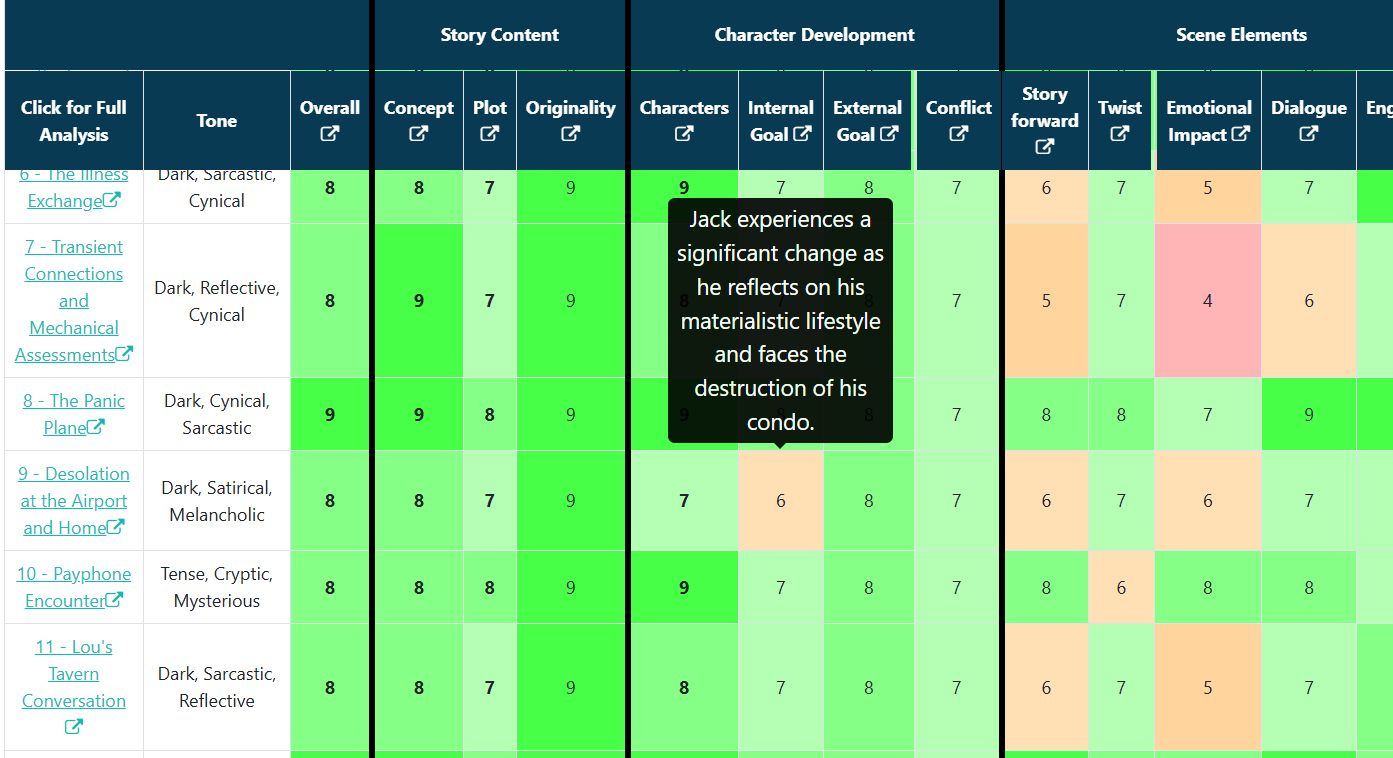
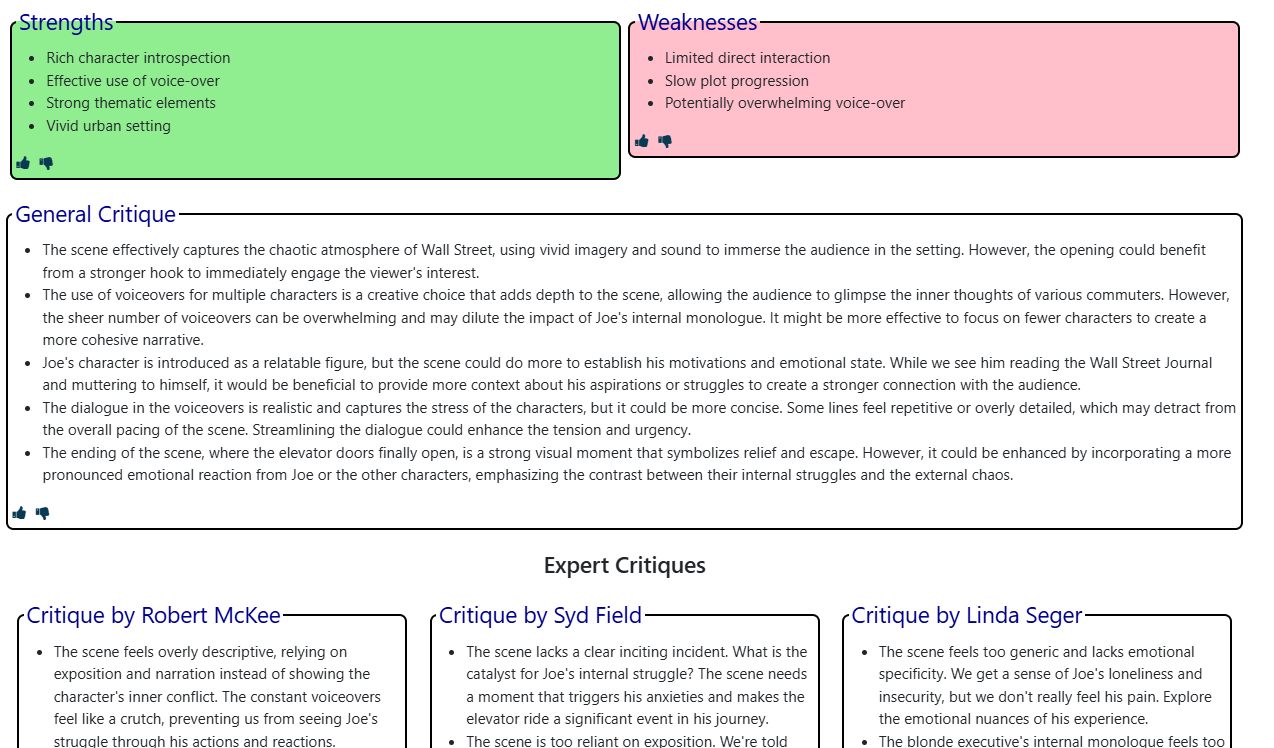
What are your weakest/strongest skills?
Is it conflict? Originality? Are you a conceptual writer and your concept and plot are amazing but characters and dialogue lame? We compare all criteria to the scripts in our vault and you see what percentile you fall in.
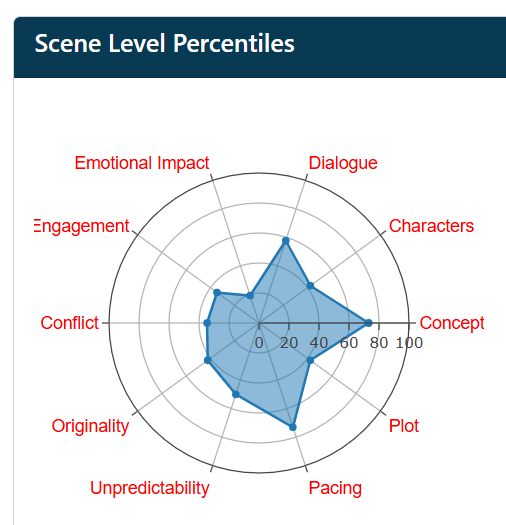
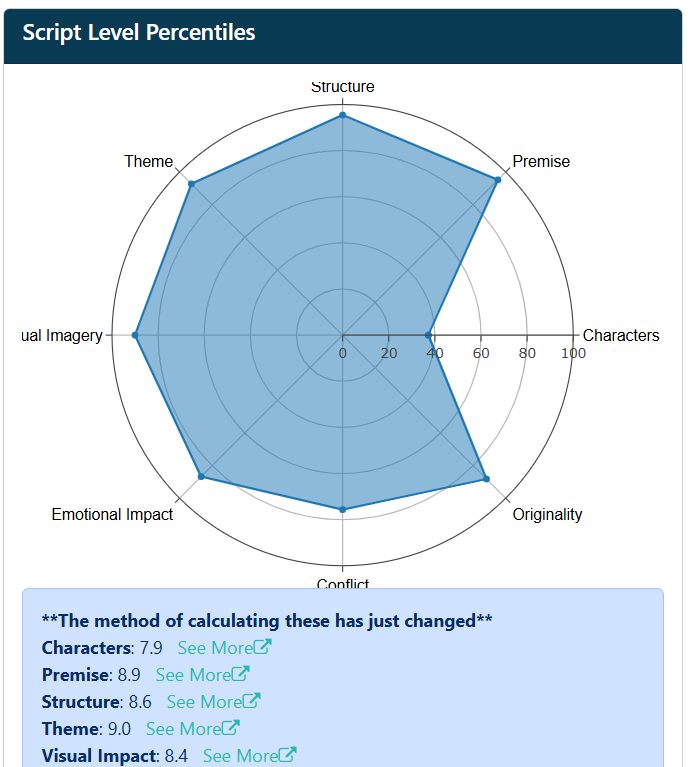
What emotional journey have you created?
.
Check out Coco's Analysis and scroll down to see it in action.
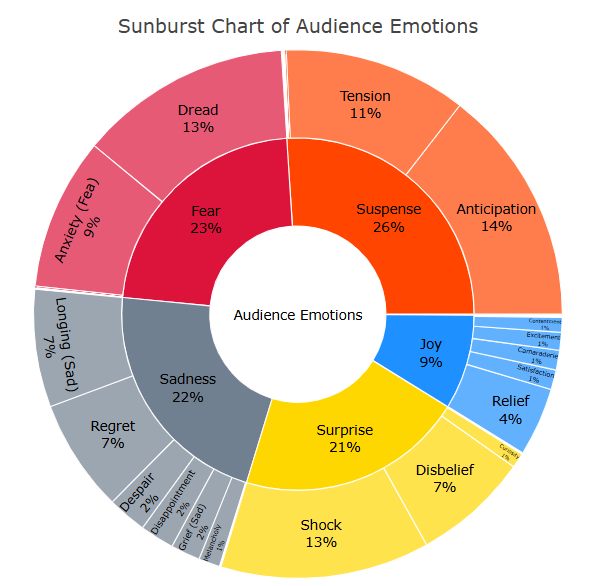
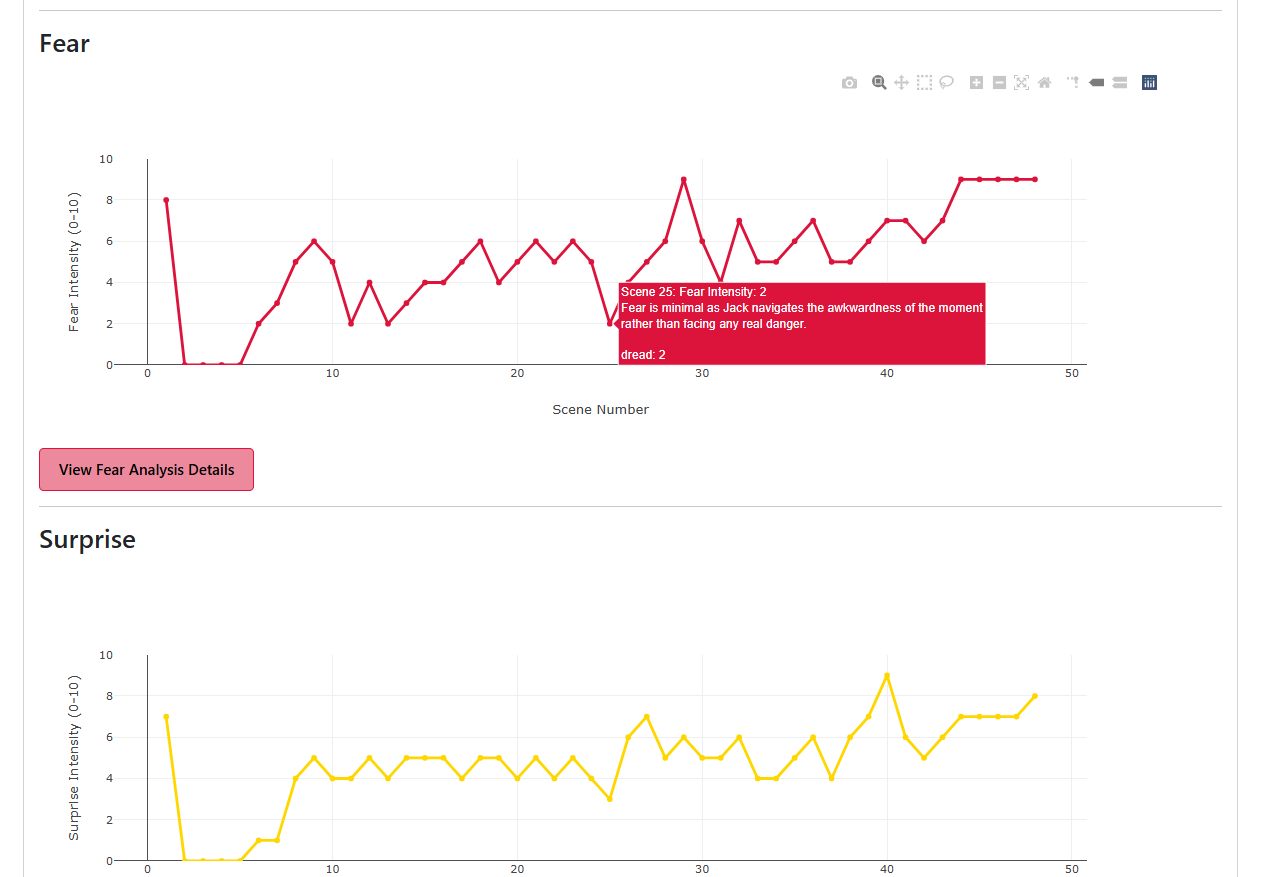
Hear From Experts...
Industry veterans tell their success stories with ScriptReader.ai
Upload Your Script View features"If you can't make your script at least 30% better with ScriptReader.ai, you're not doing your job as a writer. In bang for the buck, there's nothing even close."
"Script AI is a brilliant use of AI for script writing. It's a terrific resource for script writers, and for those who have to evaluate scripts."
